

19 Short Stories and Questions For Critical Thinking
Apr 2, 2024
There have been rumblings in different online teacher groups recently about replacing novels with short stories and informational articles in middle and high school English classrooms. I have to admit I was shocked when I first read the comments because I am a book lover at heart, but since then, I’ve considered that there are several pros and cons to this approach.
Short stories and other smaller texts can provide a briefer timeline to complete tasks, and this process is helpful when there is already SO MUCH curriculum to cover. Short stories and related activities can also be more engaging for our students because of the exposure to diverse voices and themes! Using short stories and lessons provides students with amazing choices to meet their needs and preferences!
On the other hand, incorporating mainly short stories and other shorter passages means students’ already-pressed attention spans (as a result of social media influences and pervasive sources of technology) are reinforced. Plus, students miss out on the more complex stories within longer pieces of fiction that are, dare I say, life-altering! A novel can provide opportunities for sustained reading and layers for analysis that shorter pieces of literature like short stories and related texts cannot offer.
Ultimately, no matter where you find yourself on the issue, I think we can all agree that short stories and their counterparts can be vital, effective, and helpful in the modern classroom!
Continue reading for 19 Short Stories and Questions For Critical Thinking!!
Need help with Test Prep ? Check out this FREE Pack of 3 Test Prep Activities to help students achieve success on standardized tests!

Table of Contents
19 Short Stories and Questions – Suggestions for Teaching Them
You don’t need to remove all novels to be able to include short stories and smaller passages like vignettes, articles, and narratives; there’s a time and place for all genres! But if you’re thinking about ways to include more short stories and fun activities, check out this list of 19 varied short stories and critical thinking questions as well as suggestions for teaching them in middle school and high school.
1. “The Most Dangerous Game”
“The Most Dangerous Game” is one of my absolute favorite short stories and overall plots to teach! This suspenseful short story by Richard Connell follows the harrowing ordeal of Sanger Rainsford, a skilled hunter who becomes the prey of a deranged aristocrat named General Zaroff. Stranded on Zaroff’s secluded island, Rainsford must outwit the cunning general in a deadly game of survival, where the stakes are life and death.

SUGGESTIONS FOR TEACHING:
- You could focus on the setting (description of time and place) and examine how the setting changes throughout the story.
- Students could learn about the plot (major events in the story) and list the major events and evidence as they read.
- Define foreshadowing (hints for what will happen by the end of the story) and encourage students to hypothesize about what will happen after every page.
- Analyze the character development (how a character changes over time) of Rainsford and highlight his traits/actions as you read along.
CRITICAL THINKING QUESTIONS:
- How does the setting contribute to the tension and suspense in the story?
- How does the author use foreshadowing? How does the author hint at the danger Rainford is facing?
- What inferences can you make about the main character and the changes he undergoes from the beginning to the end of the story?
If you want to teach plot elements and plot analysis , check out this lesson bundle for the story , which includes comprehension quizzes and a variety of activities!
2. “An Occurrence at Owl Creek Bridge”
Ambrose Bierce’s story is a gripping tale set during the American Civil War, where a Southern civilian named Peyton Farquhar faces execution by hanging after attempting to sabotage a Union railroad bridge. As Farquhar falls through the trapdoor, time seems to stretch, and he experiences a surreal moment, only to realize his grim reality.
Integrating historical texts with other short stories and passages like “An Occurrence at Owl Creek Bridge” will make history come more alive and relevant for our students!
- Teach about irony (when the opposite occurs from what is expected) and how it plays a role throughout the story.
- Explain the term characterization (how a character is depicted) by looking at direct and indirect references while reading with your students.
- Discuss the major themes (messages) of the story and how they connect to our modern era within a Socratic Seminar.
- How does the author use characterization to convey Peyton Farquhar’s thoughts, emotions, and motivations?
- What is the purpose of irony in this story? How does its use affect the reader’s interpretation and understanding of events?
- What is the significance in our contemporary/real world of the themes of the story, including reality and fantasy, the passage of time, and the consequences of actions?
Ensure students’ understanding of the story with this set of reading questions that are perfect for state test prep, too !
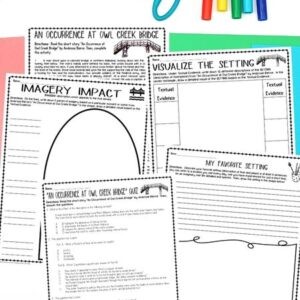
3. “The Masque of the Red Death”
This chilling tale from Edgar Allan Poe is set in a secluded abbey where Prince Prospero and his wealthy guests attempt to escape a deadly plague known as the Red Death. Despite their isolation efforts, the guests are confronted with their own mortality as a mysterious figure in a blood-red mask appears.
If you have not read any short stories and poems from Poe, this story is a perfect journey into the horror genre!
- The setting (description of time and place) plays a MAJOR role in the story, so following the Prince from room to room and highlighting the imagery (description that connects to the five senses) is very important when reading.
- If you have not introduced mood (emotion intended for the reader to experience), this story is PERFECT for delineating its progression from start to finish.
- As students read, you might guide them through identifying various examples of symbolism (object, person, or place that represents something else); each room, objects within, and the “antagonist” is symbolic in some way!
- How does the author convey the tone of the story? How would you, as the reader, describe the story’s mood?
- What role does the plot structure (focus on the different rooms) play in shaping the reader’s understanding of the story?
- What is the purpose of the symbolism in the story such as the clock and the masked figure?
Check out this EASY-TO-TEACH bundle , you can practice with your students, so they will feel more confident analyzing higher-level language in “The Masque of the Red Death!”
4. “The Cask of Amontillado”
Another chilling tale from Poe is the classic story “The Cask of Amontillado.” This one is set during Carnival in an unnamed Italian city. The plot centers on a man seeking revenge on a ‘friend’ he believes has insulted him. If your students are anything like mine, they will relish the ending particularly!
This is just one more of Poe’s short stories and tales that will capture the mind of every reader!
- As you plan for this short story, be sure to encourage your students to analyze the changing setting (description of time and place); following Fortunato from scene to scene will help your students track what is really going on.
- This story is the perfect moment to teach about dialogue (conversation within someone=internal and/or between someone and someone/thing else=external); Montresor certainly means more than what he SEEMS to say!
- You might also offer a mini-lesson on the 3 types of irony and how each plays a role in the story: verbal (when a person says the opposite of what is really intended), situational (an action occurs that is the opposite from what the reader expects), and dramatic (a character expects a result, but the opposite occurs and the audience can tell what will happen)!
- Describe Montresor. What are his motives and personality?
- What inferences can you make about Montresor’s mindset based on his dialogue?
- What is the purpose of the family’s motto and the carnival atmosphere?
Check out this Short Story Activity & Quiz Bundle for Edgar Allan Poe’s “The Cask of Amontillado,” which contains questions and answers modeled after various reading standardized tests as well as pre-quiz reading comprehension questions, graphic organizers, and a writing activity to get students thinking critically about this classic short story involving REVENGE!
Want 7 more teaching ideas for one of Poe’s epic short stories and questions to go with it? Click below!
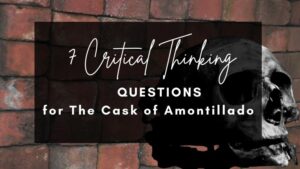
5. “To Build a Fire”
This story by Jack London describes the treacherous journey of a man through the harsh Yukon wilderness during extreme cold. Despite warnings and the company of a loyal dog, the man’s arrogance and underestimation of nature’s power lead to a tragic end.
Short stories and ideas related to survival in nature are still relevant today! Who knows when you might get lost on a hike or crashland in no man’s land?
- This story is PERFECT for a bit of literary analysis (examining the impact of various ideas, elements, or themes within a piece of literature); you could hone in on literary devices, characterization, theme, etc.!
- Integrating clips from survival shows will help students see connections to the world and extend their thinking by comparing (recognizing similarities) and contrasting (recognizing differences) varied experiences!
- Write a short narrative about surviving 24 hours in a different setting (description of time and place).
- How does the author use irony? Provide an example and explain.
- What real-world connections can be made between this story and our contemporary life?
- What is the story’s message about preparedness and respecting nature?
Grab these engaging short stories and activities to make teaching this Jack London story stress-free!
6. “The Cactus”
Told from the point of view of a young man at his former lover’s wedding, the narrator retells their story. Like most of O. Henry’s short stories and texts, this one has a twist that involves the titular cactus plant.
The ending will end in a bit of fun for your students!
- Introduce diction (word choice) and its impact within the story by hyperfocusing on specific words within the story . Students can look up definitions, locate synonyms, create their own sentences, replace the words, etc.
- Investigate twist endings (unexpected finish to a story); before reading the end of the story, ask students to guess why the girl “rejected” him. Some students may know the answer before reading it!
- Describe the main characters. What similarities and differences are evident? How does this affect the story’s action?
- What inferences can you make about Trysdale and his feelings about love and marriage?
- What are the real and symbolic meanings of the cactus?
This resource packed with questions and answers, graphic organizers, and writing activities is sure to get your students thinking about this love story driven by misconceptions.

7. “After Twenty Years”
This tale of friendship and betrayal focuses on the reunion of two old friends after twenty years apart on a New York City street corner. As they reminisce, something is revealed that demonstrates the reality of their bond as well as the choices they’ve made in life.
If you have not read O. Henry’s short stories and incorporated character analysis yet, this is your chance! The story is not long and can be completed in one to two class periods!
- Sometimes, we ask students to visualize (create a picture) in their minds, but why not give them the opportunity to use their artistic skills to draw the two characters?
- As students read, annotate for a description of each character; then, students can do a character analysis (investigation of the characters’ similarities and differences).
- What type of irony is used in the story? How does its use affect your interpretation and understanding of the story?
- How does the urban setting contribute to the mood of the story?
- What is the story’s message about friendship and loyalty?
Examine the links between loyalty and duty with this set of resources designed specifically for this O. Henry story.
8. “The Lottery”
“The Lottery” is the quintessential short story for middle school or high school English! Shirley Jackson’s “The Lottery” tells the story of an annual ritual that takes place in a seemingly idyllic town. When the townsfolk gather for the lottery drawing, a shocking turn of events demonstrates the dark side of human nature and their ties to (outdated) traditions.
- Introduce the terms suspense (uncertainty and/or excitement leading up to a major event) and tension (anxiety or uneasy feelings experienced by characters). While reading, identify evidence that relates to each of these concepts and chat/write about their impact on meaning and plot.
- Teach title (the name of the text) analysis. The title of “The Lottery” is perfect for teaching the impact of the title and audience expectations. Before reading, students may write what they believe the story will be about based on the title. After reading, students can complete a quick write responding to their previous expectations! You can do a text analysis for all short stories and poems!
- What role does the plot structure play in building suspense and tension? (Consider the revelation of the lottery’s ‘prize’ in particular.)
- What social commentary is being made through the story and its characters?
- Describe Mr. Summers, Tessie, and Old Man Warner. What does the story reveal about their role in the community and their feelings about the lottery?
Give yours elf a breath of fresh air with this NO PREP curriculum that integrates test prep within the teaching of literature by using Shirley Jackson’s quintessential story!
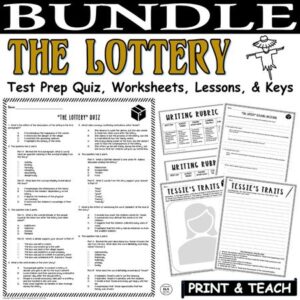
9. “The Pedestrian”
This Ray Bradbury story follows a lone walker in a futuristic society in which everyone else is consumed by technology, particularly the television. One evening, the walker encounters a police car that questions his unusual behavior and the end is quite unexpected! (Most of Bradbury’s short stories and texts connect to the future and technology in some way!)
- This story exemplifies Dystopian Literature (texts that include a supposedly perfect future society marred in some way by governmental or societal oppression). Using this story to introduce this type of literature is always fun for students because they will easily make connections to other dystopic short stories and poems!
- Teach about mood (the emotional impact of a story’s description/action). The goal is to get students to deepen their critical thinking skills by recognizing how the mood changes and the purpose for that change!
- How does the author use foreshadowing and suspense to build the mood of the story?
- What is the central theme of the story? How might it connect with our current world?
- What similes and metaphors does Bradbury use to describe the community and its members? What is notable about these comparisons?
With this resource about Bradbury’s “The Pedestrian,” you can just print and teach the lesson and activities with EASE!
10. “The Gift of the Magi”
This 1905 story by O. Henry relays a tale about a couple struggling to make ends meet. Throughout the story, they both figure out gifts to buy one another for Christmas and realize what love truly means!
- Review character traits (how a character is depicted internally and externally). Log the traits of each character within the story and how they are important to the meaning of the story.
- Extend (move beyond the text) critical thinking skills by encouraging students to think and write about other people. If they had $1,000 to spend on someone else, how would they spend the money and why?
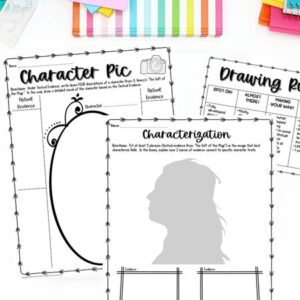
- How would you describe Della and Jim, and their relationship?
- What values do the characters have, when you consider their actions and decisions?
- Explain how dramatic irony is used in the story. Is it necessary? Is it effective? Why or why not?
This tale is a great addition to your short stories and questions unit around the winter holidays! Save yourself time at that time of the year with this lesson bundle .
11. “The Monkey’s Paw”
“The Monkey’s Paw” is a classic horror story about the White family who come into possession of a mystical monkey’s paw that grants three wishes. Despite warnings, they use it and then face devastating consequences as a result.
- Teach about the elements of the horror/suspense genre (Ex. Scary movies are typically dark, stormy, surprising, morbid, etc.).
- Create a thematic statement (message relayed by the text in a complete sentence). There is no perfectly created theme (message) unless it is directly stated by the author; however, students can create a theme by supporting their ideas with evidence from the story!
- What is the main theme of the story? Or how does the author communicate the themes of greed or fate? Is one stronger than the other?
- Are Mr. and Mrs. White more alike or different from one another? How do you know?
- Should we be afraid of the unknown? What message does the story share? Do you agree or disagree?
Examine W.W. Jacobs’ classic story with this set of questions and answers along with rigorous reading and writing activities . While it is ideal for a spooky season, the story is valuable for its ability to hook readers any time of year!
12. “Lamb to the Slaughter”
This classic story with a killer plot twist is about a woman who kills her husband and gets away with murder thanks to cooking a leg of lamb!
- You could introduce the plot elements (exposition, rising action, climax, falling action, resolution), encourage students to identify major events to fit each element and write down textual evidence to support their ideas.
- Complete a film analysis (examination of film techniques and their effects) to compare/contrast the short story with the classic Alfred Hitchcock television episode.
- What is Mary Maloney’s state of mind? Does it remain the same or does it change throughout the story? Explain.
- Is the resolution of the story satisfying? Why or why not? Why do you think the author ended it as he did?
- How does irony contribute to the theme of deception in the story? Explain.
Spice up your middle school English or high school English class with this short stories and activities bundle for Dahl’s famous story!
13. “The Tell-Tale Heart”
Poe’s classic psychological thriller is narrated by an unnamed protagonist who insists on their sanity while recounting how they murdered an old man. The narrator is haunted by the sound of the victim’s beating heart, which ultimately drives him to confess to the crime despite not originally being a suspect.
- Teach symbolism (object, person, or place that represents something else) by focusing on the heart and eye . The author used these symbols in various ways!
- Investigate psychology (the study of the human mind) as a part of the story. Determine what is fact and what is fiction within the narrator’s mind.
- What does the story reveal about the human psyche?
- What is the deeper meaning of the two key symbols in the story – the beating heart and the eye of the old man?
- What role do the narrator’s inner thoughts play in the development of the plot?
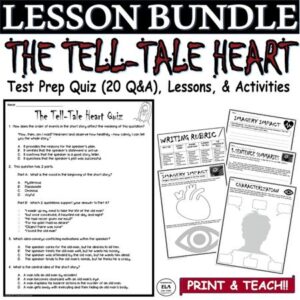
This Short Story Comprehension Bundle offers quick (and effective!) ways to assess students’ learning and understanding of the story. It’s easy to use and will no doubt save you time too!
14. “The Scarlet Ibis”
Emotional short stories and their counterparts have a place as well in English classrooms! This short story by James Hurst about two brothers is a heartbreaking must-read. Through flashbacks, the unnamed narrator tells the life story of his younger sickly brother William Armstrong, who is nicknamed Doodle. And the end…well, you’ll see.
- Define and explain the purpose of a flashback (referring back to the past within a story). Think about the implications of never thinking back on the past or always thinking about the past.
- Complete a comparison chart between Doodle and the Ibis as you read along. Then, students can create a visual of each after they have ready by using their own evidence!
- What is the meaning of the story’s title and the presence of a scarlet ibis in the story?
- What is the central theme of the story? How do the events of the story support this chosen theme?
- How does the author use personification for the storm? What effect does this have on the story?
This flexible resource features critical thinking questions and answers as well as writing and reading activities for students to explore Hurst’s heartbreaking story.
15. “The Veldt”
This science fiction story by Ray Bradbury was first published as “The World the Children Made” and it is quite fitting as a title! The story focuses on a futuristic world in which a video screen can be controlled and it turns out to be more than simple virtual reality! By the story’s conclusion, the world the children made is the downfall of their parents.
- Compare and contrast “The Veldt” with “The Pedestrian,” two short stories and dystopic texts by Ray Bradbury. Analyze the similarities and differences of both short stories and create a thematic statement that connects to both texts!
- Make connections to our current reality in the 21st century. Locate research about the implications of technology on young people and integrate this information as you discuss this short story.
- How does the author address the theme of technology versus humanity in the story? Do you agree with this commentary? Why or why not?
- How does the nursery reflect the personalities of Wendy and Peter in this story?
- Do you know the story of Peter Pan and his friend Wendy? What connections can you make between it and this story by Ray Bradbury?
Ray Bradbury’s classic short stories and similar passages are the BEST to teach in middle and high school English! With so much to dive into, they are sure to be a hit with your students. Grab this set of activities to extend your students’ engagement with rigorous reading and writing activities about “The Veldt.”
16. “The Necklace”
A woman who longs for a life of luxury and elegance beyond her means faces consequences when she loses a borrowed necklace. Guy de Maupassant’s story ends with a twist that has the reader question the value of material possessions.
- I love comparing this short story with O. Henry’s “The Gift of the Magi.” You might choose to focus on the theme, characterization, setting, etc.
- Summarize (writing about the main idea with details) each chunk of the story as you read with your students. Instead of asking students to write a paragraph, you could ask students to create each summary in only one sentence.
- The story explores vanity, deception, and the consequences of striving for social status. Which theme do you think is the most important? Explain with support from the story.
- Is Mathilde Loisel a likable character? Does this change during the story? Does it matter if the reader likes her? Why or why not?
- What clues does the author provide throughout the story that foreshadow the twist at the story’s end?
Focus on the standards with this Short Story Lesson Bundle for “The Necklace” by Guy de Maupassant!
Need help with implementing activities for “The Necklace?” See below!
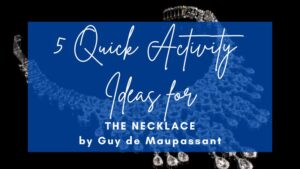
17. “A Vendetta”
Guy de Maupassant’s late-19th-century story is all about REVENGE. A mother is obsessed with creating a plan to avenge her son’s murder and she then puts the plan into action with a morbid outcome.
- There are so many texts that involve REVENGE! Why not use this concept as a focus for a thematic unit (texts linked to a similar concept and/or message)? You could read “A Poison Tree,” “The Cask of Amontillado,” and “Lamb to the Slaughter” as well as “A Vendetta” with the intention of writing about all 4 for a comparison/contrast paper, presentation, or seminar.
- Analyze the development (how a character changes over time) of the mother and the dog throughout the story; you might annotate for similarities and differences as well as their motivations!
- What comment is the story making about the nature (or need) for justice? Do you agree or disagree? Why or why not?
- What similes and metaphors does the author use to communicate the main character’s feelings about the vendetta?
- How does the author use details to explain the main character’s thoughts, feelings, and motivation?
Add these activities for this lesser-known work to your short story plans. It’s sure to keep things fresh for your short stories and activities unit!
18. “Thank You, Ma’am” (also known as “Thank You, M’am”)
This heartfelt story by Langston Hughes tells the story of Luella, an older woman in the neighborhood, who is nearly robbed by a young man named Roger. In response to Roger, Luella brings him back to her home and treats him with an abundance of kindness, which has a profound effect on Roger.
This tale is at the top of the list for the BEST short stories and passages for upper middle and younger high school students!
- Introduce perspective and/or point of view (how a story is told: 1st, 2nd, 3rd omniscient, 3rd limited, 3rd objective). Students might rewrite the story from another perspective or extend the story using the perspective of one of the main characters.
- Review plot elements with a focus on the exposition (introduction to the characters, setting, and conflict), climax (highest point of interest/turning point of the story), and resolution (how the story is concluded and/or resolved in some way.) You could assign an activity surrounding each concept: visualization of the scene, a journal response to the event, or a short response focused on how the element is important to the overall theme!
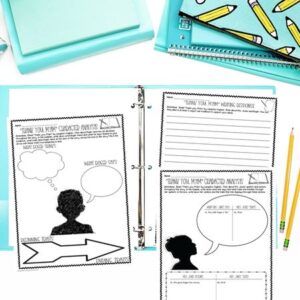
- Do you believe in second chances? What does the story say about second chances?
- How might the climax of the story also be seen as the turning point in Roger’s life?
- How would you describe Mrs. Luella Bates Washington Jones? Are her actions expected or unexpected in the story? Consider from Roger’s and the reader’s point of view.
Click to check out all of the details for this BUNDLE with differentiated options , which includes a Test Prep Quiz (with varied options), Venn Diagrams, Graphic Organizers, and Writing Responses!!
19. “Click Clack the Rattle Bag”
This short story by Neil Gaiman is creepy and fun in the best ways possible! The narrator is taking care of his girlfriend’s little brother and walking him to bed when the child asks for a story. Instead of the narrator sharing a story, the boy shares about the Click Clacks who drink their prey and leave behind rattling bodies. The end is too good to be missed!
Short stories and plots like those in “Click Clack the Rattle Bag” will most certainly engage even your most struggling learners!
- We all know that test prep can be tough as many reading passages are, well, boring! Why not accomplish some test prep with your students and incorporate 5 standardized test-related questions ? You could focus on theme, structure, order of events, characterization, etc.!
- Help students make inferences (acknowledging and hypothesizing about the impact of details that are not directly referenced or stated) as the scene moves along. Students can analyze the change in the setting, the little boy himself, the story the boy is telling, and specific phrases from the story.
- What details in the story contribute to its eerie atmosphere or mood? Or what figurative language devices does Neil Gaiman use to create a sense of suspense in the story?
- How does the author use ambiguity in the story? Is it effective or not? Explain.
- What inferences can you make about the relationship between the narrator and the young boy?
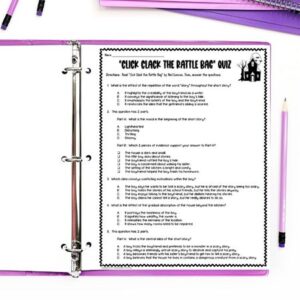
This “Click Clack the Rattle Bag” Quiz Pack for middle and high school students uses the Common Core standards and contains questions and answers modeled after various state standardized tests! Make teaching this amazing short story by Neil Gaiman SIMPLE & EASY!
Why should we incorporate more short stories and activities in our teaching?
While I would never advocate replacing all novels with short stories and smaller texts, there is still something to be said about spending quality time with short stories and excerpts.
Including short stories and standards-based activities is an ideal option to improve reading comprehension and develop skills, especially in middle and high school English classes!
SHORT STORIES AND ACTIVITIES RESOURCES:
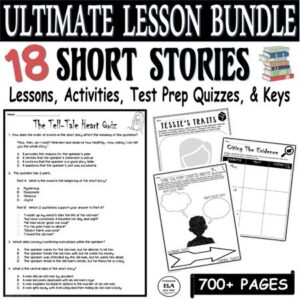
This Short Stories and Test Prep Questions ULTIMATE BUNDLE with Lessons, Quizzes, and Activities uses the Common Core standards with reading comprehension QUESTIONS and ANSWERS for 18 short stories such as “The Most Dangerous Game,” “The Monkey’s Paw,” “The Tell-Tale Heart,” “After Twenty Years,” “The Gift of the Magi,” “The Veldt,” “The Lottery,” “The Pedestrian,” etc. modeled after various state reading exams.
Make teaching short stories and activities SIMPLE & EASY!
Just PRINT & TEACH with engaging short stories and lessons!!
Need more fun ideas for teaching short stories and corresponding activities? Check out my store Kristin Menke-Integrated ELA Test Prep !

Hi, I’m KRISTIN!
I primarily focus on integrating multiple disciplines and subjects. The goal is to make teaching simplified and effective!
Let's Connect
- Follow Follow
Click below to download “13 Simple Strategies to make test prep a breeze!”

Storytelling and Critical Thinking
By charles temple.

Years ago while working in Eastern Europe and Central Asia as a trainer for the Open Society Institute I stumbled the value of storytelling as a tool for sparking discussions and helping people think critically. Our task was to work with teachers who, shortly after the cataclysmic political changes of 1989, wanted to know how to teach students to think in diverse ways and come up with their own answers to questions. I wanted to demonstrate ways of doing that; and soon found that the quickest way to engage listeners in a pithy subject for a discussion was to tell them a story, usually through a translator who would retell the words in the local language, sentence by sentence. And then everybody would jump in and say what they thought about it.
Fifteen years and forty countries later it has become clear that storytelling is just a wonderful way to provoke discussions that get everybody thinking together—and you don’t have to go six thousand miles from home to do that. Here in the US, teachers in 45 states and the District of Columbia are now required by the Common Core Standards to teach the way those Eastern European teachers wanted to: so that students will learn to think deeply about issues they care about, stake out positions on those issues and support them with reasons, often in friendly debates with others. Storytelling is humanity’s oldest and most engaging way of putting issues out there for debate. To provoke rich discussions, all you need is to present them in a way that invites questions rather than asserts answers. That, and a few strategies for inviting and hosting discussions.
Some stories pose their own questions. They have questions built right into them. “The Cow Tail Switch,” from West Africa, and “The Theft of a Smell,” from Peru, are examples. You can have a good discussion of each by asking for predictions about the end, or you can use a fancier strategy such as “Corners” that gives people group support as they think of reasons to back their answers.
Some stories contain moral dilemmas that invite exploration. These stories may not come right out and ask a question, but the questions aren’t hard to find. “The Woman of the Sea,” from Scotland, and “The King and the Shirt,” from Russia, are stories that can invite listeners to voice their own questions. But there are strategies that can deepen the discussion and lead to debate. Some of those strategies are “Shared Inquiry,” “Discussion Web,” “Academic Controversy,” and “Value Line.”
And some stories seem straightforward, but can still yield up engaging issues with a little work. “Jack and the Beanstalk,” from England; “Hansel and Gretel,” from Germany; “The Boy Who Lived With the Bears,” from the Seneca Indians of Upstate New York; “The Orphan Boy and the Elk Dogs,” from the Blackfoot people of the Northern Plains; and “A Gift of Laurel Blooms,” from the Appalachian Mountains in Kentucky, can all inspire interesting thoughts. But sometimes to get at the heart of these stories you need to to twist them around. And sometimes you need to climb inside the skin of the characters and see what they are going through. Strategies like retelling them by casting people in different roles, or comparing them to other stories, or relating them to life, or dramatizing them can all lead to good discussions.
I look forward to seeing you in Richmond at the National Storytelling Conference this August.
About Charles
As a teacher, author of children’s books and textbooks, and leader of workshops for teachers and writers, my work has taken me to more than 30 countries in North America, Central and South America, Europe, the Caucasus, Central and Southeast Asia, and East and West Africa–with support from USAID, the World Bank, UNESCO, CIDA of Canada, the Dutch government, the Open Society Institute, and the International Reading Association. I was born in North Carolina, and lived in South Carolina, Virginia, and Texas before moving to Upstate New York, where I chair the education department at Hobart & William Smith Colleges and have happily taught for thirty years.
Contact Charles
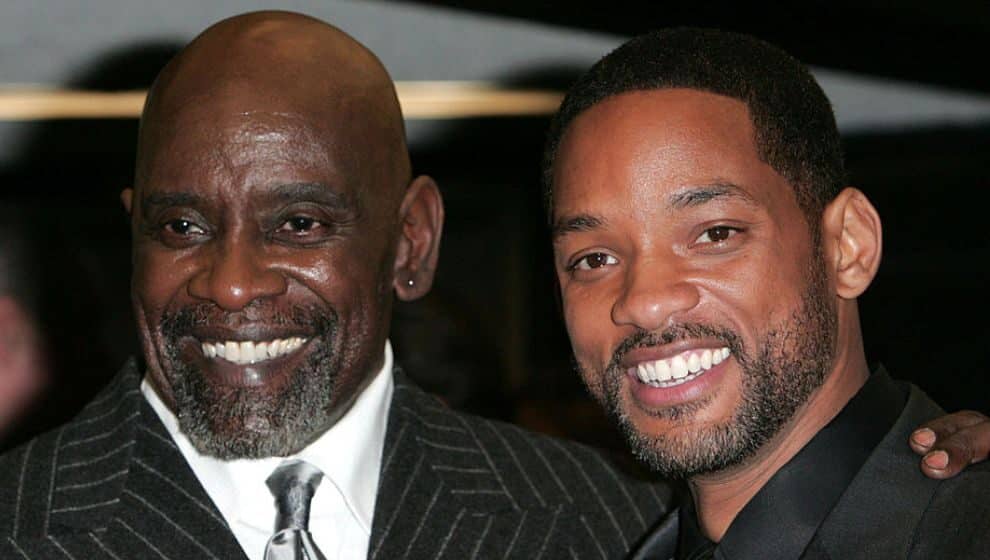
Eamonn McCormack/Getty Images
By Christine Ruggeri Leaders Staff
Christine Ruggeri
Leadership Writer
Christine Ruggeri is a business and personal growth writer for Leaders Media. Previously, she worked as a senior content writer...
Learn about our editorial policy
Updated Aug 21, 2023
Reviewed by Hannah L. Miller
Hannah L. Miller
Senior Editor
Hannah L. Miller, MA, is the senior editor for Leaders Media. Since graduating with her Master of Arts in 2015,...
10 Inspirational Stories to Develop Empathy, Critical Thinking, and Heightened Perspective
There’s a reason why we start hearing stories from the time we’re toddlers. The world’s obstacles and inevitable setbacks are portrayed in countless literary works, whether they are children’s books, short stories, memoirs, or biographies. Inspirational stories provide motivation and encouragement while offering a perspective that helps people contextualize their own adversities.
In fact, research in neuroscience suggests that reading fictional works helps people develop critical thinking, empathy, and theory of mind.
The best short stories, in fiction and nonfiction genres, inspire people to pursue their dreams and overcome obstacles. They can remind people that they are not alone in their struggles and that others have persevered through similar challenges. Motivational stories can also help foster a sense of community and connection, creating a ripple effect of positivity that encourages people to support one another in their personal growth and development.
Reading and sharing short inspirational stories can be a powerful motivating tool that helps create a more positive and supportive world. In this article, you’ll learn about some of the most impactful short stories and memoirs that are often used to teach lessons and drive motivation.
Top 10 Must-Read Inspirational Stories
1. the parable of “the elephant rope” .
“The elephant was conditioned to believe he could never break away. He believed the rope could still hold him, so he never tried to break free.”
Summary: “The Elephant Rope” is a short motivational story about a young man who observes elephants at a circus and is amazed at how they are held in place by a simple rope tied to a stake in the ground, despite their massive size and strength. It was clear that the elephants could break away from their bonds but chose not to because they were conditioned to believe it wasn’t possible.
Theme: “The Elephant Rope” is a story about limiting beliefs. The young man learns that the elephants were conditioned from a young age to believe that they could not break free from the rope. As a result, the elephants never tried to gain freedom again, even when they were fully grown and capable of doing so.
Moral of the story: Limiting beliefs can hold us back from reaching our full potential. We may have been conditioned by our past experiences or beliefs to believe that we cannot achieve something, but in reality, we may be more capable than we think. By breaking free from our limiting beliefs and challenging ourselves, we can achieve great things.
2. “ The Gift of the Magi” by O. Henry
“And here I have lamely related to you the uneventful chronicle of two foolish children in a flat who most unwisely sacrificed for each other the greatest treasures of their house. But in a last word to the wise of these days, let it be said that of all who give gifts these two were the wisest.”
Summary: “The Gift of the Magi” is a short story written in 1905 by O. Henry. It’s about a young couple, Jim and Della, who are struggling to make ends meet during the Christmas season. Despite their financial difficulties, they each want to buy a special gift for the other. They end up making sacrifices to do so, each giving up something they treasure to please the other.
Theme: “The Gift of the Magi” displays the true meaning of gift-giving, which is about the thought and love behind the gift rather than its material value. The couple’s gifts to each other are ultimately meaningless in terms of their practical use, but their representation of love and sacrifice proves to be invaluable for both Jim and Della.
Moral of the story: The story highlights the benevolent spirit of gift-giving and reminds readers that the value of a gift is not in how much money was spent on it but in the thought and love behind it.
3. “The Man Who Planted Trees” by Jean Giono
“For a human character to reveal truly exceptional qualities, one must have the good fortune to be able to observe its performance over many years.”
Summary: “The Man Who Planted Trees” is a short story by Jean Giono, first published in 1953. The story is a fictional account of a man named Elzéard Bouffier, who lives in a remote valley in the French Alps and spends his life planting trees. Over the course of several decades, Bouffier single-handedly transforms the barren and desolate landscape into a lush and thriving forest, which has a profound impact on the surrounding environment and community.
Theme: “The Man Who Planted Trees” highlights the power of individual action and the importance of environmental stewardship. The story emphasizes the transformative power of nature and highlights the impact that even one person can have on the world.
Moral of the story: The story shows that small actions can have a big impact on the world. It serves as a reminder of the importance of preserving and protecting the natural world, and of the power of individual action. It also encourages readers to take responsibility for the environment and to work toward a more sustainable and harmonious relationship with the natural world.
4. “The Three Questions” by Leo Tolstoy
“Remember then: there is only one time that is important—Now! It is the most important time because it is the only time when we have any power.”
Summary: “The Three Questions” is a short story by Russian author Leo Tolstoy that was published in 1903. The story follows a king seeking answers to three questions: What is the best time to do things? Who is the most important person? What is the right thing to do? He offers a reward for the answers to these questions and consults with various advisors and wise men, but none can give him satisfactory responses. Eventually, he learns the answers to his questions through his own experiences and actions.
Theme: “The Three Questions” portrays the importance of living in the present moment and taking personal action. The story emphasizes the futility of worrying about the past or the future and highlights the importance of engaging fully in all of life’s moments.
Moral of the story: The story teaches that the answers to life’s big questions can only be found through action and experience rather than through intellectual inquiry alone. Tolstoy shows that the best way to live is with compassion and kindness toward others. It also encourages readers to cultivate a sense of mindfulness, rather than being preoccupied with the past or the future.
5. “The Necklace” by Guy de Maupassant
“She was one of those pretty and charming women whose infatuation with luxury is their one form of heroism.”
Summary: “The Necklace” is a short story by Guy de Maupassant, first published in 1884. It follows the life of a woman named Mathilde Loisel, who is unhappy with her modest lifestyle and longs for wealth and luxury. One day, her husband secures an invitation to a fancy ball, and Mathilde borrows a diamond necklace from a wealthy friend to wear to the event. However, after the ball, she discovers that she has lost the necklace and spends years working to pay off the debt incurred by replacing it, only to learn that the original necklace was fake.
Theme: The theme of “The Necklace” is the danger of materialism and the pursuit of social status. Mathilde’s obsession with wealth and status blinds her to the comforts she has in her current life and leads her to make poor decisions that ultimately ruin her chances of happiness.
Moral of the story: The story is a cautionary tale that teaches readers that material possessions and social status are not the keys to happiness. Mathilde’s relentless pursuit of luxury leads her to a life of poverty and misery, and her true happiness is found only when she accepts her circumstances and learns to appreciate the blessings in her life.
6. “To Build a Fire” by Jack London
“The trouble with him was that he was without imagination. He was quick and alert in the things of life, but only in the things, and not in the significances. Fifty degrees below zero meant eighty-odd degrees of frost. Such fact impressed him as being cold and uncomfortable, and that was all.”
Summary: “To Build a Fire” is a short story by Jack London, first published in 1908. The story follows an unnamed man traveling through the Yukon wilderness on foot with his dog. Despite warnings from an experienced old-timer, the man sets out alone in frigid temperatures and attempts to build a fire to keep warm. However, when he encounters several setbacks, he ultimately succumbs to the cold while his dog manages to survive.
Theme: “To Build a Fire” portrays the power and indifference of nature. It highlights the brutal conditions of the Yukon wilderness and the harsh reality that even the most prepared and experienced individuals can be no match for the forces of nature. While it’s not inspirational in the traditional sense, it offers an important lesson about human fragility and our role in the world.
Moral of the story: London’s story highlights the importance of respecting and understanding the power of nature while limiting overconfidence. This is a cautionary tale against arrogance and hubris, and it emphasizes the importance of caution and humility when facing the unpredictable and unforgiving forces of nature.
7. “The Parable of the Good Samaritan” From the Bible
“But a Samaritan, as he journeyed, came to where he was, and when he saw him, he had compassion.”
Summary: “The Parable of the Good Samaritan” is a story told by Jesus in the Bible, found in Luke 10: 25–37. It tells the story of a traveler who is beaten, robbed, and left for dead on the side of the road. A priest and a Levite, who were both considered to be religious leaders, passed by the man without helping. Then a Samaritan, who was an outsider and often looked down upon, stopped to help the man, tending to his wounds and providing for his needs. The Samaritan put the traveler on his donkey and brought him to an innkeeper, who he paid to look after him.
Theme: “The Parable of the Good Samaritan” is meant to teach people about the call to love and serve others, regardless of differences in background or status. It emphasizes the importance of acting with compassion, kindness, and generosity toward those in need.
Moral of the story: The parable shows readers that everyone is our neighbor, and we are called to love and serve others without discrimination or prejudice, even to those who are considered an enemy.
8. The Pursuit of Happyness by Chris Gardner
“The future was uncertain, absolutely, and there were many hurdles, twists, and turns to come, but as long as I kept moving forward, one foot in front of the other, the voices of fear and shame, the messages from those who wanted me to believe that I wasn’t good enough, would be stilled.”
Summary: The Pursuit of Happyness is a memoir by Chris Gardner that was published in 2006. It’s an inspiring story that details Gardner’s journey from homelessness to success as a stockbroker. The memoir describes the challenges he faced as a single father trying to provide for his son while struggling with poverty, homelessness, and no college degree.
Theme: Gardner’s rags-to-riches story portrays a life of resilience and perseverance. Despite facing seemingly insurmountable obstacles, he refused to give up on his dreams and continued to work hard toward achieving them. He showed incredible resilience in the face of adversity and remained determined to create a better life for himself and his son.
Moral of the story: This story shows that with hard work, determination, and a positive attitude, anyone can achieve their dreams, no matter how difficult or impossible they may seem. It encourages readers to pursue their passions, never give up, and believe in themselves, even when others may doubt them.
9 . The Story of Colonel Sanders
“I made a resolve then that I was going to amount to something if I could. And no hours, nor amount of labor, nor amount of money would deter me from giving the best that there was in me. And I have done that ever since, and I win by it. I know.”
Summary: The true-life account of Harland Sanders, the founder of Kentucky Fried Chicken (KFC), is an inspiring and motivational story of success despite many rejections. Sanders was born in Indiana in 1890 and worked a variety of odd jobs to support his siblings after his father’s death. At 40 years old, he began cooking and selling fried chicken out of a gas station in Corbin, Kentucky, in the 1930s. He developed his own blend of 11 herbs and spices, and after that, his business grew steadily over the next few decades, leading to the creation of the KFC franchise.
Theme: The story of Colonel Sanders portrays perseverance and determination, even in the face of numerous setbacks and obstacles. Sanders refused to give up on his dream of creating a successful fried chicken business, and he continued to work tirelessly to achieve his goals.
Moral of the story: Sanders’ achievements teach us that success often comes from hard work, perseverance, and a refusal to give up in the face of adversity. Even when things seem bleak or impossible, it’s important to keep pushing forward and striving to achieve your goals. With dedication and determination, anyone can achieve their dreams, just as Colonel Sanders did with his fried chicken empire.
10. Shoe Dog by Phil Knight
“The cowards never started and the weak died along the way. That leaves us, ladies and gentlemen. Us.”
Summary: Shoe Dog is a memoir written by Phil Knight, the co-founder of Nike, Inc. Published in 2016, this story is an inspirational depiction of Nike, from its humble beginnings as a small startup company to a global giant in the athletic shoe industry. Just out of business school, Phil Knight borrowed fifty dollars from his father and launched what would become one of the world’s most iconic and profitable brands.
Theme: The motivational story of Phil Knight highlights themes of perseverance and determination. Knight and his team faced numerous challenges throughout the company’s journey, including financial difficulties, legal battles, and intense competition. However, they persevered and never gave up, ultimately achieving great success.
Moral of the story: Shoe Dog shows that success comes from a combination of passion, hard work, and perseverance. Knight’s story is an inspiring reminder that no matter how difficult the road may seem, if you believe in your vision and are willing to put in the effort, you can achieve great things.
What Makes for an Inspirational Story?
An inspirational story is one that motivates, encourages, and uplifts the reader. It’s used to teach a lesson and break barriers of false perception.
Some key elements that can make a story inspirational include:
- Overcoming Adversity: An impactful story often features protagonists who face significant challenges or adversity. They may struggle, fail, and experience setbacks, but ultimately find a way to overcome their challenges and achieve their goals.
- Positive Messages: A motivational story often conveys a positive message of hope, perseverance, and resilience. The story should leave the reader feeling empowered and motivated to take action in their own lives, which is made possible when a relatable character or figure makes their own personal realization.
- Realistic: While an inspirational story may be fictional, it should be grounded in reality. The characters, situations, and challenges should be believable and relatable so that readers can see themselves within the story.
- Emotional Impact: An effective story should elicit an emotional response from readers. Whether it’s laughter, sadness, fear, or joy, the story should have a powerful emotional impact that allows its message to shine through.
- Empathy: An inspirational story should create empathy between the reader and the characters. The reader should care about the characters and their struggles and feel invested in their journey.
- Universal Themes: When authors use universal themes that resonate with readers, such as love, courage, sacrifice, and self-discovery, they allow for inspirational real-life connections.
- Transformation: An inspiring story often features a protagonist or central figure who undergoes a transformation. They may start out feeling defeated or hopeless, but through their journey, they discover inner strength and achieve personal growth.
- Memorable: Impactful stories should be memorable and leave a lasting impression on the reader. They should stick with the reader long after they finish reading it and inspire them to take action or make positive changes in their own lives.
Telling or reading empowering stories that are grounded in reality and convey positive messages is an impactful way to boost motivation, whether it’s at home, in the workplace, or for your own self-growth.
To continue reading timeless literary works with powerful characters and themes, check out these top Ernest Hemingway books .
Leaders Media has established sourcing guidelines and relies on relevant, and credible sources for the data, facts, and expert insights and analysis we reference. You can learn more about our mission, ethics, and how we cite sources in our editorial policy .
- Seifert, C. (2020, May 28). The Case for Reading Fiction . Harvard Business Review. https://hbr.org/2020/03/the-case-for-reading-fiction
- Khan, M. (n.d.). The Elephant Rope (Belief) Story: don’t limit yourself to a belief that You Can’t! https://www.linkedin.com/pulse/elephant-rope-belief-story-dont-limit-yourself-you-cant-mobarza-khan/
- A Summary and Analysis of O. Henry’s ‘The Gift of the Magi.’ (2023, March 18). Interesting Literature. https://interestingliterature.com/2021/12/o-henry-gift-of-the-magi-summary-analysis/
- Green, C., Green, C., & Green, C. (2020b, April 21). The Man Who Planted Trees Before His Time . Chelsea Green Publishing. https://www.chelseagreen.com/2020/the-man-who-planted-trees-before-his-time/
- The Three Questions . (2023, February 11). Plough. https://www.plough.com/en/topics/culture/short-stories/the-three-questions
- The Necklace: Summary, Themes, and a Short Story Analysis | Blog StudyCorgi.com . (2023, March 17). StudyCorgi.com. https://studycorgi.com/blog/the-necklace-summary-themes-and-a-short-story-analysis/
- Summary Of To Build A Fire By Jack London – 1085 Words | Bartleby . (n.d.). https://www.bartleby.com/essay/Summary-Of-To-Build-A-Fire-By-PK6XJ6939A6
- The Parable of the Good Samaritan – Morality – GCSE Religious Studies Revision – WJEC – BBC Bitesize . (n.d.). BBC Bitesize. https://www.bbc.co.uk/bitesize/guides/zwxm97h/revision/6
- Cheng, A. (2020, November 13). The Pursuit of Happyness Book Summary, by Chris Gardner – Allen Cheng . Allen Cheng. https://www.allencheng.com/the-pursuit-of-happyness-book-summary-chris-gardner/
- Culver, A. (2019, August 1). The inspiring life story of KFC’s Colonel Sanders . Snagajob. https://www.snagajob.com/blog/post/the-inspiring-life-story-of-kfcs-colonel-sanders
- Shoe Dog Summary: 10 Best Lessons from Phil Knight . (n.d.). Growth.me. https://growth.me/books/shoe-dog/
- Baker, D. (2022, August 9). How to Make Your Writing Inspirational – Supercharge Your Marketing . Super Copy Editors. https://supercopyeditors.com/blog/writing/make-writing-inspirational/
Search Leaders.com


10 of the Best Children’s Books That Promote Critical Thinking
Mikkaka Overstreet
Mikkaka Overstreet is from Louisville, Kentucky by way of Saginaw “Sagnasty”, Michigan. She has been an educator since 2006 and earned her PhD in Curriculum and Instruction in 2015. By day she is a mild-mannered literacy specialist. By night she sleeps. In between, she daydreams, writes fiction, and reads books. She currently lives in North Carolina with her husband and cats.
View All posts by Mikkaka Overstreet
Unfortunately, there are people and groups more interested in an industrious than a thoughtful population. The general public doesn’t agree on the purpose of public education . Neither, it seems, do education stakeholders. During recent remarks, North Carolina State Superintendent of Public Instruction Catherine Truitt declared 2022 “the year of the workforce.”
Truitt explained, “We have got to redefine what the purpose of K–12 education is. Some would say it’s to produce critical thinkers, but my team and I believe that the purpose of a public K–12 education is to prepare students for the postsecondary plans of their choice so that they can be a functioning member of the workforce.”
While that statement makes my skin crawl, it’s more than unsettling: it’s contradictory. Employers regularly cite problem-solving and critical thinking skills as ideal qualities they seek in employees. According to a study from the Association of American Colleges and Universities , 95% of employers view critical thinking specifically as “very important” or “somewhat important.” Thus, preparing kids to think critically is preparing them for the workforce — and beyond.
Undoubtedly, our society needs more critical thinkers . We have lots of problems, both old and new, that will require innovative solutions. The following books will help encourage the next generation of big thinkers.
10 Children’s Books That Promote Critical Thinking
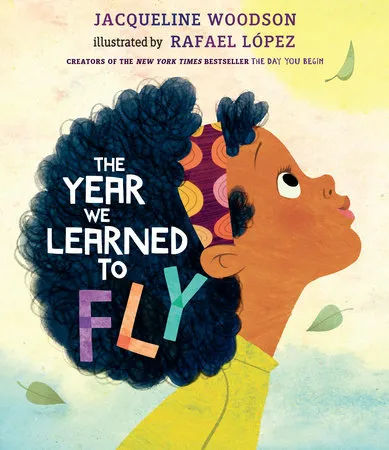
The Year We Learned to Fly by Jacqueline Woodson and Rafael López
The incomparable Jacqueline Woodson has done it again. In this newly released children’s book, readers journey into the vivid imaginations of the central characters. Woodson tells the story of children stuck inside because of bad weather. Rather than succumb to boredom, the children use their imaginations to escape the confines of their apartment. Surely, this will inspire children to dream big.
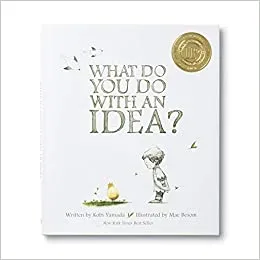
What Do You Do With An Idea? by Kobi Yamada and Mae Besom
This inspiring picture book centers on a child with an idea. We get to follow the child as they nurture the idea and watch it grow. Undoubtedly, this simple story will resonate with anyone who has ever been afraid to share their big dreams with the world.
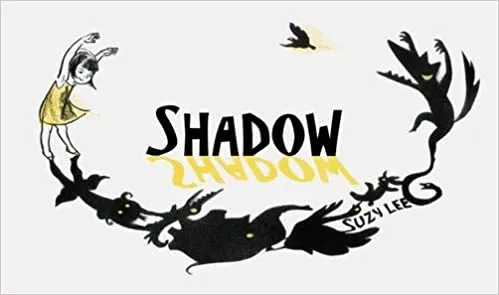
Shadow by Suzy Lee
This gorgeous wordless picture book is a guaranteed hit. The young protagonist uses her imagination and her shadow to create a fantasy world. Mirrored illustrations show both the true objects and the magical world the girl has built.
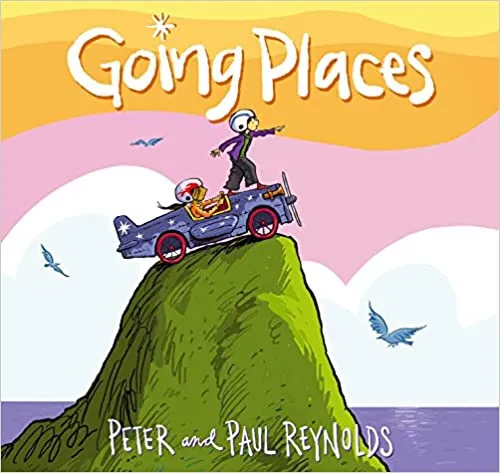
Going Places by Peter H. Reynolds and Paul A. Reynolds
I’m a big fan of Peter H. Reynolds’s work. He has a whimsical style and encourages creativity and self-love in his several excellent picture books. In this story, written with his twin brother, Reynolds introduces us to another uniquely wonderful protagonist. Maya enters a go-cart competition and must create a winning vehicle out of one of the identical kits given to all contestants. Of course, Maya doesn’t think inside the box she’s given. This is another fun story with a great lesson.
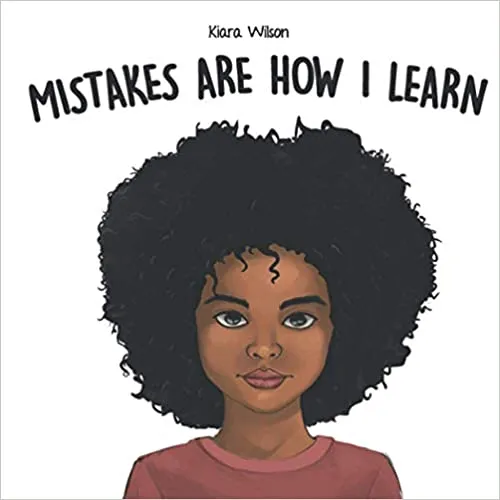
Mistakes Are How I Learn by Kiara Wilson
As we all know, mistakes are a part of the learning process. In this encouraging book, Wilson reminds kids to give themselves grace and space to make mistakes. Similar to The Girl Who Never Made Mistakes , this book is a good reminder for little perfectionists.
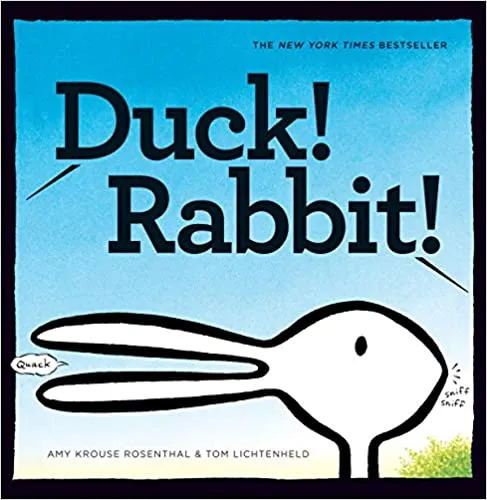
Duck! Rabbit! by Amy Krouse Rosenthal and Tom Lichtenheld
This picture book takes the well-known duck or rabbit puzzle and tells a story. Obviously, readers will feel compelled to see both sides of this argument. This is a humorous introduction to considering varying viewpoints.
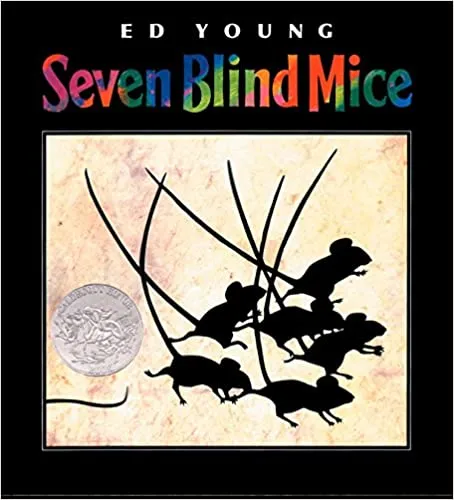
Seven Blind Mice by Ed Young
In this Caldecott Honor winner, seven blind mice try to determine the identity of an unfamiliar object. In Young’s take on the classic Indian tale, each mouse only gathers partial information. Of course, it takes the wisdom of the seventh mouse to put the pieces together and solve the puzzle.
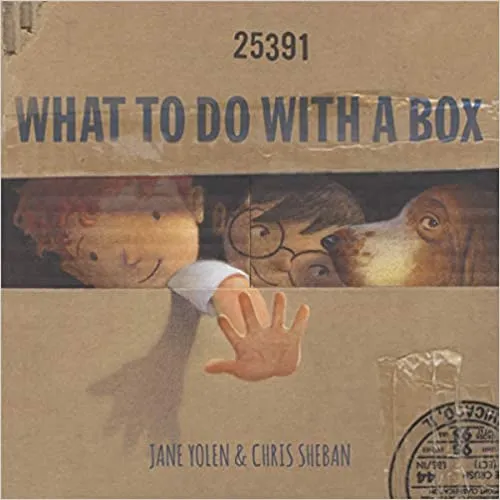
What To Do With A Box by Jane Yolen and Chris Sheban
You can probably guess what’s going to happen in this book, right? Clearly, there’s a metaphor here. Enjoy all the things a child can imagine with outside-of-the-box thinking in this rhythmic tale.
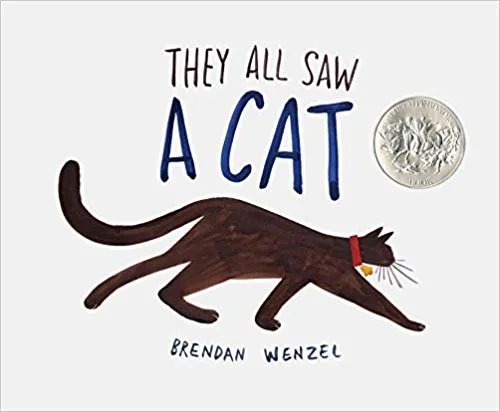
They All Saw A Cat by Brendan Wenzel
This book brilliantly executes a creative concept. Using strange and gorgeous illustrations, Wenzel depicts how differently individuals can perceive the same object. Consequently, readers are pushed to consider multiple viewpoints and how our perceptions color what we see.
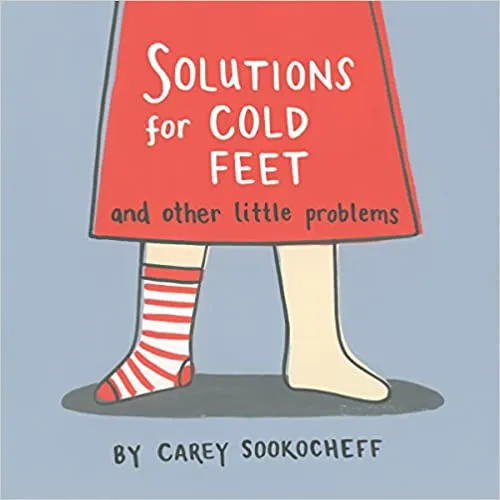
Solutions for Cold Feet and Other Little Problems by Carey Sookocheff
Follow one little girl and her dog through the challenges of a normal day in this fun story. The girl asks lots of questions and persists when she encounters problems. This tale will inspire kiddos to see problem-solving as a positive and necessary part of life.
Hopefully, you’ve found something on this list that inspires you to think and dream. If you’d like more content like this, check out 7 Board Books for Woke Babies and 10 Science Books for Curious Kiddos . Read, think, and dream BIG!
You Might Also Like

- Accessibility
- Terms and Conditions
- Privacy Policy
Short Stories for Critical Thinking
- Post author: Hayden J Williams
- Post published: March 24, 2024
- Post category: Productivity / Creativity / Learning
We all love a good story. But have you ever stopped to dissect why a character made a certain choice, or questioned the author’s motives?
By delving deeper into the narrative, we can sharpen our ability to analyze evidence, identify bias, and uncover underlying themes. This article equips you with critical thinking tools to unlock the deeper meaning within each sentence.
Table of Contents
Building Your Critical Thinking Toolkit
Pre-reading activities : Prepare your mind for critical thinking before delving into the story.
- Title and Cover Analysis : Examine the title and cover artwork to make predictions about themes, characters, and plot.
- Author Research : Explore the author’s background, literary influences, and relevant historical or cultural contexts to understand their perspective.
- Identify Biases : Challenge yourself to identify potential biases or assumptions in the story. Consider how they may affect your interpretation.
- Question Generation : Brainstorm questions or discussion prompts to explore while reading, focusing on themes, character motivations, and moral dilemmas.
- Debate or Discussion : Engage in a brief debate or discussion with peers to share different perspectives and interpretations of the story’s themes and messages.
By actively engaging in these pre-reading activities, you’ll stimulate your critical thinking skills and enhance your ability to analyze and interpret the text effectively.
Active Reading: Become a Story Detective
Prepare to Engage : Immerse yourself in the text as you embark on a journey of discovery. Before you begin, take a moment to skim through the text, getting a sense of its main ideas and key points. Equip yourself with tools like highlighters, notebooks, and sticky notes to interact actively with the material. This will promote active engagement for critical analysis.
Focus on the Details : Start by paying attention to the details. Notice the language used, the interactions between characters, and the descriptions of the setting. Each word holds significance, guiding you deeper into the heart of the story. Enhances comprehension and critical interpretation.
Ask Questions Ask questions along the way. Why did the characters act the way they did? What might happen next? Asking questions before, during, and after reading helps you better understand and think critically about the text. Stimulates critical inquiry and understanding.
Predict Make predictions based on what you already know and what you’ve read so far. Picture scenes unfolding in your mind’s eye. Create mental images to help you better understand the story. Encourages anticipation and analysis of narrative elements.
Annotate for Understanding As you read, jot down your thoughts and reactions in the margins of the text. Underline passages that stand out to you, and write down any questions or ideas that come to mind. These notes will help you stay engaged with the material and remember important points. Helps contextual understanding and critical comparison.
Connect & Compare Look for connections between the text and your own experiences, as well as other texts you’ve read. How does this story relate to what you already know? Are there similarities or differences between this and other stories you’ve encountered?
Remember, reading is not just about reaching the end—it’s about the journey. Enjoy the process of discovery and embrace the challenges that come with understanding a new story. So, grab your book, get comfortable, and dive into the text. Who knows what secrets you’ll uncover along the way?
Post-Reading Debrief: Unmasking the Clues
Character Analysis: Delve into the motivations, actions, and contributions of characters to the story’s message. Engage in debates about character decisions and question their reliability as narrators. This activity promotes critical thinking by examining character development and the impact on the narrative. Example “How does the story portray a character’s growth or internal conflict? Did they overcome a limitation or learn something about themself?
Theme Detectives: Identify the story’s central themes and analyze how different elements portray them. Discuss symbolism, analyze plot twists for thematic significance, and explore how characters and events contribute to the overall themes. This activity encourages critical analysis of underlying messages and the author’s thematic intentions. Example “Does the story highlight the potential for humans to overcome adversity? How do specific elements, like symbolism or plot twists, reinforce this message?”
Author’s Intent: Explore the author’s potential message and analyze their writing techniques. Examine the use of language, identify literary devices such as foreshadowing or imagery, and consider how these elements contribute to the story’s meaning. This activity encourages critical thinking by unpacking the author’s craft and intentions behind the narrative. Example “Does the author seem to be questioning the limitations of the human experience or celebrating its potential? What writing techniques support this interpretation?”
Alternative Perspectives : Consider different viewpoints within the story or imagine alternative endings. This activity prompts readers to think critically about narrative possibilities, character motivations, and the impact of different choices on the story’s outcome. It encourages creative thinking and cultivates a deeper understanding of the text’s complexities. Example: What would be the story like from the viewpoint of a different character, or how a change in setting or historical context might impact the story’s message
By engaging in these post-reading activities, readers continue to unravel the mysteries of the story, uncover hidden layers of meaning, and develop a more nuanced appreciation for the text. Whether exploring characters’ motivations, analyzing thematic elements, deciphering the author’s intent, or imagining alternative perspectives, these activities promote critical thinking , creativity , and deeper engagement with the text.
Put Your Skills to the Test: Analyze and Discuss
The Critical Thinking Showcase: Analyzing Short Stories
We’ve explored the tools for critical thinking analysis. Now, let’s put them into practice! Here are summaries of three captivating short stories representing diverse genres:
Story 1: The Necklace (Genre: Realism by Guy de Maupassant)
Summary: Mathilde Loisel, a young woman consumed by a desire for a more affluent life, feels trapped in her ordinary existence with her kind but working-class husband. An invitation to a prestigious social event fuels her yearning for luxury. Desperate to appear the part of a wealthy socialite, Mathilde convinces her friend, Madame Forestier, to loan her a magnificent diamond necklace. The evening allows Mathilde to temporarily escape her reality, basking in the admiration she receives because of the borrowed jewels.
However, disaster strikes when Mathilde loses the necklace during the event. Terrified of her friend’s reaction and determined to rectify their mistake, Mathilde and her husband plunge themselves into years of grueling labor and strict frugality to replace the expensive necklace. The experience takes a heavy toll on their lives, forcing them to sacrifice their dreams and endure significant hardship. Finally, after years of relentless work, they manage to buy a replacement necklace and return it to Madame Forestier, relieved to be free of the burden of their deception. The devastating truth is then revealed – the borrowed necklace was a cheap imitation, and their immense sacrifice was entirely in vain.
Story 2: The Machine Stops (Genre: Dystopian Fiction) by E. M. Forster
Summary: In the far future, people live in underground sterile chambers, depending completely on a massive machine for everything. This machine, treated like a god, provides food, entertainment, and even air to breathe. Communication happens only through the machine, eliminating face-to-face talks. Vashti, one of the residents, is disturbed when her son Kuno expresses a desire to see the forbidden surface world, challenging the machine’s authority. She questions the sterile existence enforced by the machine and yearns for a deeper connection. Vashti is initially dismissive.
However, Kuno’s persistence leads him to escape the underground confines, experiencing the freedom of nature. Meanwhile, the machine begins to malfunction, causing panic among the underground dwellers. As the machine ultimately fails, Vashti and Kuno find themselves facing the unknown on the surface. The story explores themes of technological dependence, isolation, and the loss of human connection, offering a cautionary tale about the consequences of overreliance on technology and the importance of genuine human interaction.
Story 3: The Gift of the Magi (Genre: Coming-of-Age by O. Henry)
Summary: Deeply in love but struggling with poverty, a young couple, Della and Jim yearn to give each other meaningful Christmas gifts. Determined to express their love despite their limited means, Della sells her most treasured possession – long, flowing hair – to buy a platinum chain for Jim’s cherished pocket watch. Meanwhile, Jim sacrifices his most prized possession, a gold watch passed down through generations, to buy jeweled combs for Della’s hair. The irony of their situation unfolds when they exchange gifts, realizing that their sacrifices made the gifts unusable. Though their possessions are gone, their love shines brighter than ever.
The story celebrates the true meaning of love and the sacrifices people make for their loved ones, showing that the greatest gifts are often not material but expressions of love and selflessness.
Critical Thinking Challenge: Sharpen Your Skills
For each story summary, we’ll delve deeper with critical thinking questions (5-7 questions) that target different aspects of human development and the story’s message:
Story 1: The Necklace
Character Analysis: How does Mathilde’s obsession with material wealth affect her life and relationships? Analyze her thoughts, actions, and motivations throughout the story
Theme Detectives: Does the story explore the limitations of social class or the dangers of envy? Analyze the symbolism of the necklace to support your answer. Consider how social pressures and desires for possessions influence the characters.
Author’s Intent: What message might Guy de Maupassant be conveying about societal pressures and human desires? Explore how the story critiques social expectations and the potential dangers of coveting what others have. Consider the use of irony and the characters’ downfalls.
Alternative Perspectives: How might the story be different if told from the perspective of Mathilde’s friend who loaned the necklace? Consider the friend’s motivations, potential feelings of betrayal, and the impact of the situation on their relationship. What message might the story convey from this viewpoint?
Story 2: The Machine Stops
Theme Detectives : How does the story portray the dangers of uncontrolled automation? Analyze how the machine’s role in society highlights the potential for technology to become oppressive.
Character Analysis : How does Vashti’s rebellion challenge the status quo? What does her yearning for connection reveal about the limitations of a technology-dependent life?
Author’s Intent: What message might E. M. Forster be conveying about the importance of human interaction and the dangers of sacrificing individuality for convenience?
Alternative Perspectives: Imagine the story from the viewpoint of someone who wholeheartedly believes in the machine’s superiority. How would they justify the system and view Vashti’s actions?
Story 3: The Gift of the Magi
Character Analysis:
- How do Della and Jim’s sacrifices for each other reveal their love and commitment? Analyze their actions, thoughts, and the challenges they face.
Theme Detectives:
- Does the story celebrate the true meaning of love or highlight the challenges of poverty? Analyze the symbolism of the gifts to support your answer. Consider the characters’ motivations and the emotional impact of the story.
Author’s Intent:
- What message might O. Henry be conveying about the importance of love and selflessness? Explore how the story portrays the characters’ love despite their limited means. Consider the use of irony and the story’s ending.
Alternative Perspectives:
- How might the story be different if set in a time of great wealth and abundance? Would the characters’ actions and the story’s message change? Consider the impact of economic circumstances on the themes of love and sacrifice.
Recognizing Bias in Stories
For critical thinking, it is important to recognize the biases in the short stories.
For example: in “To Kill a Mockingbird” by Harper Lee, we can recognize the bias inherent in the novel’s portrayal of racial injustice in the American South during the 1930s. The story is told from the perspective of a young white girl, Scout Finch, whose father, Atticus Finch, defends a Black man accused of raping a white woman.
Critical Analysis: By critically analyzing the characters, themes, and narrative structure, we can gain insight into the biases and prejudices present in society at the time. We can also explore how the novel challenges and subverts these biases through characters like Atticus, who stands up for justice and equality despite societal pressures.
How to recognize bias? Look for different types of bias:
- Social Bias: Race, gender, class, sexual orientation – are characters judged based on these?
- Historical Bias: Does the story reflect the era’s views? Consider the author’s background.
- Narrative Bias: Who’s telling the story? Does their perspective influence what’s shown?
Unmask Bias with Detective Work:
- Loaded language: Do words favor one side?
- Missing voices: Whose stories are absent?
- Unequal representation: Who gets the spotlight?
By questioning bias, you gain a deeper understanding of the story’s message and its historical context. This detective work helps you challenge biases in stories and, ultimately, in the real world.
Final Thoughts
Delving into short stories for critical thinking has been a rewarding adventure.
Pre-reading activities, active reading techniques, and post-reading analysis become tools to sharpen our critical thinking skills, unlocking deeper layers of meaning within literary works. By examining diverse perspectives , dissecting themes, and identifying biases , we unravel the intricacies of a story. Additionally, we cultivate a more sharper mindset applicable to various aspects of life. This process encourages a continuous quest for understanding, enriching both our appreciation for literature and our broader understanding of the world.
Embracing the challenge of interpretation and the nuances of narratives leads us on a rewarding exploration. This journey enhances our analytical skills and deepens our engagement not only with literature but also with the world around us.
Critical Thinking, Reading, and Writing: A Brief Guide to Argument by Sylvan Barnet and Hugo Bedau
Was this helpful?
You might also like.
Learn High Velocity Decision Making with Examples
The High Price of Multitasking (12 Important Facts)
Kanban Time Management (Helpful Examples)

Finding Faith Everywhere.
God is Truth, Goodness, and Beauty itself.
Wherever they are found, God is also present.

Finding Faith Everywhere
Teach critical thinking with stories.
Confidently teach your students to seek and love the truth wherever it is found.
People skilled in critical thinking are:
Problem solvers
Truth seekers

Critical thinking is using reason to pursue the truth by:
Making distinctions between what is true, and what is not true
Considering the possible consequences of an action or an idea
Discovering the principles at the foundations of an idea
Developing your natural process of reasoning
Critical thinking skills train your mind to:
Observe a situation or object
Analyze what you've observed
Arrive at a logical conclusion

HOW DO YOU LEARN TO DO THAT WITH STORIES?
I'll walk you through how to teach critical thinking skills to your students by using stories in my lesson plans.
Critical thinking skills train your mind to:
Teaching Critical Thinking with Stories is a series of printable exercises that give you:
Planned Series of Exercises
All students can begin with the first set of exercises. When they're ready for more challenges, you can add additional levels, or incorporate the challenges in the levels
Additional Challenges to Exercises
The exercises also have additional levels to challenge students to go deeper into the story and develop their capacity for more complex thoughts. That allows you to use the same exercise for an entire class, while making adjustments for individual students who need more of an intellectual challenge
Human Development
I include explanations on what abilities your students will develop as they work through the different exercises, and what foundations they’re laying so that students can learn how to think more clearly and engage in more thoughtful discussions.
These lesson plans can be used with any work of fiction.
These exercises are grouped into 3 levels:

Level 1 (Observation): Memory, Logic, and Sequencing
The exercises help your students to develop their imagination and memory, while learning cause and effect through sequencing exercises. They also take our natural ability to use reason, and develop it. The first few exercises in these lesson plans can be used for children as young as 3, but the rest of the exercises are intended for children who are at least 5. The extra levels to some of the exercises can challenge students even through middle school.
Level 2 (Reasoning to a Conclusion): Transformation in Stories
You’ll be helping your students learn to think about change, and how changes and conflict that a character experiences lead to that character’s transformation by the end of the story. The exercises guide them through what they should be paying attention to, and how the author prepares the reader for the character's transformation. The first exercises can be used for younger children who are able to read and write. The rest of these exercises are best used beginning with Grade 5/age 10 and continue through high school. Some of the extra challenges should only be attempted by very advanced students.
Level 3 (Abstract Thought): Symbols and Allusions in Stories
You’ll be teaching your students how to identify and understand symbols and metaphors in stories. They will also learn how authors are often referring to other sources when using symbols, and how those references affect the story they're reading. These exercises require the ability to think abstractly, so they’re best used for high school and above. Students in middle school are usually not ready to engage in abstract thought, so my recommendation for using these is for grades 9 through adult. Just as with the Level 2 exercises, some of the extra levels should only be attempted by very advanced students.
Each Lesson Plan Includes:
Background information on what skills the student will develop with the exercises
Additional levels for exercises to challenge your student
A list of recommended stories and authors
A series of exercises that progressively challenge your student
The exercises in Teaching Critical Thinking with Stories allow teachers and parents—who know their kids better than anyone—to decide what their students and children are ready for, and to discern what challenges each individual student or child needs, at every level.
These exercises can be used with any story, so they can be used over and over again.
These exercises help your students:
Form the mind by directing it towards the truth
Engage with ideas in greater depth
Make distinctions between truth and error
Develop abstract thinking
Engage with stories in greater depth
Encourage discussion of ideas
That leads to a higher quality discussion for:
Literature circles for younger students
Book club discussions for adult learners
Readers of any age will get more out of every story and bring their own insights to any discussion.

Regular Price: $9.97

Regular Price: $19.97

** SendOwl uses popup forms for ordering, so you may need to adjust your browser setting to allow popups when you click to purchase these lesson plans
How to Get Started:
1. download the file.
Once you purchase the file, you will receive a link to download the PDF.
2. READ THE STORY
The story is the foundation. Pick any story and read it, or start with one from the included list of suggested stories and authors.
3. PRINT THE EXERCISES
The pages are color-coded so you can go right to the exercises and print them out, or choose to read more about the “why” behind each of the exercises in the packet.

Memory, Sequencing, and Logic
Developing the imagination
Strengthening memory
Understanding how stories work

Regular Price: $19.97
Discovering How Characters Change in a Story
How characters are transformed
Where changes happen
Develop memory, logic, analytical skills

Discovering Common Elements Across Stories
Understanding symbols
Literary allusions
Developing abstract thought
Save When you Buy the Full Bundle
Purchase all 3 lesson plans together, save 20% off the full price, automatically get updates through the end of 2021.

* FREE Updates *
If you purchase now, you will receive any updates to the lesson plan you purchase, now
through the end of 2021!
Click here to buy all 3 for $39.97
TO PURCHASE PRINTABLES INDIVIDUALLY, CLICK BELOW
This is the first time these lesson plans have been made available,which is why they are being offered at a low price. When they are updated to the final version, I will send you a link to download the final version.
Printables are downloadable digital files which can't be returned, so I don't offer refunds on them.

How Do Detectives Solve their Cases in Best-Selling Fictional Stories?

Why is Lent Always 40 Days Long?

What is Wrong with Catholics Who Actually Read the Bible Literally?
The 17 Best Books on Critical Thinking (to Read in 2024)
All products were independently selected by our editors and contributors. When you buy through links on our site, we may earn an affiliate commission.
The aim of improving your skill of critical thinking isn’t just to be able to reason and give logical arguments about a subject skillfully; your goal is to get to the right answer, to make the right decisions and choices for yourself and others.
Critical thinking helps you:
First , improve the quality of your decisions and judgments, and reevaluate your beliefs objectively.
The human mind is rarely objective. However, mastering the skill of critical thinking keeps your mind objective, at least about those things based on facts.
Take for example the beliefs you have about yourself; Some are based on facts, some on subjective (negative) opinions of others.
Second , become an independent thinker (learn to think for yourself); take ownership of your values, beliefs, judgments, and decisions.
Mastering critical thinking is essential , especially in our modern times, because you must:
- Make a tone of decisions every day;
- Think and come to the right conclusion fast;
- Solve (mostly alone) your problems and issues;
- Weigh carefully facts and information you receive from the dozens of sources you have at your disposal;
- Reevaluate your strategies, beliefs, and habits periodically.
Critical thinking is a skill that you must learn; you’re not born with it. To make your journey a little easier, we’ve gathered the best critical thinking books so you can learn from the masters. Get inspired to become a critical thinker in no time!
The best books on critical thinking:
Table of Contents
1. Critical Thinking: A Beginner’s Guide to Critical Thinking, Better Decision Making, and Problem Solving – Jennifer Wilson
2. wait, what: and life’s other essential questions- james e. ryan, 3. think smarter: critical thinking to improve problem-solving and decision-making skills – michael kallet, 4. brain power: learn to improve your thinking skills – karl albrecht, 5. the art of thinking clearly – rolf dobelli, 6. being logical: a guide to good thinking – d.q. mcinerny, 7. predictably irrational, revised and expanded edition: the hidden forces that shape our decisions – dr. dan ariely, 8. a more beautiful question: the power of inquiry to spark breakthrough ideas – warren berger, 9. a rulebook for arguments – anthony weston, 10. thinking, fast and slow – daniel kahneman, 11. the organized mind: thinking straight in the age of information overload – daniel j. levitin, 12. don’t believe everything you think: the 6 basic mistakes we make in thinking – thomas e. kida, 13. the decision book: 50 models for strategic thinking – mikael krogerus, roman tschäppeler, philip earnhart, jenny piening, 14. weaponized lies: how to think critically in the post-truth era – daniel j. levitin, 15. the demon-haunted world: science as a candle in the dark paperback – carl sagan, ann druyan, 16. how to think about weird things: critical thinking for a new age – theodore schick, lewis vaughn, 17. the 5 elements of effective thinking – edward b. burger, michael starbird.

As the title says, this book introduces you to the art of critical thinking. You’ll discover in it:
- What is critical thinking in practice,
- The different thought processes of critical thinking,
- How will your life be better mastering critical thinking,
- The things your brain needs to enjoy exercising critical thinking,
- Techniques you can use for solving problems,
- How to become a better decision maker, Strategies to use in your critical thinking processes,
- Ways to make good decisions when more people (not just you) are involved,
- Tips to frame your questions in order to maximize the efficiency of your critical thinking.

Wisdom comes from observation, learning, practice, and asking the right questions.
Using examples from history, politics, and his own personal life, James e Ryan shows you the importance of knowing how to:
- Ask questions and gain a better understanding,
- Get to be more curious,
- Push yourself to take action,
- Make your relationship stronger,
- And stay focused on the important things in life.
Related: Critical Thinking Examples
The book starts with the five fundamental questions:
- Couldn’t we at least…?
- How can I help…?
- What truly matters….?
Knowing how to formulate, address, and deliver the right questions doesn’t leave room for misunderstandings, misinterpretations; asking the wrong questions will most probably give you a wrong answer.
This book (Wait, What?: And Life’s Other Essential Questions) will make you feel (more) courageous; after all, asking questions thanks courage. Asking yourself and others the right questions helps you make informed decisions and decisive action.

This book is a guide on how to train your brain to work even more for you. The author (Michael Kallet) is a critical thinking trainer and coach and gives you a practical set of tools and techniques for critical thinking in your day-to-day life and business.
If you want a clear, actionable step by step program to:
- Improve your critical thinking skills,
- A better understanding of complex problems and concepts,
- And how to put them in practice, then this book is for you.
Learn how to discover the real issues that need a solution, so you don’t waste your time in trying to solve imaginary problems. Increase your mental toughness, useful and productive thought.

In this book, Karl Albrecht shows you how to:
- Build your mental strength,
- Think more clearly logically and creative,
- Improve your memory,
- Solve problems,
- Make decisions more effectively.
Karl Albrecht talks in this book about the six functional abilities you need to have and become more adaptable and an innovative thinker.
The book is packed with practical exercises, fascinating illustrations, games, and puzzles to improve your mental capabilities.

The art of thinking Clearly by Rolf Dobelli is a window into human psychology and reasoning; how we:
- Make decisions;
- Evaluate choices and options;
- Develop cognitive biases.
This book helps you notice and recognize erroneous thinking and make better choices and decisions, change unwanted behaviors and habits.
It will change the way you think about yourself and life in general because you have in this book 99 short chapters with examples of the most common errors of judgment and how to rectify them.
If you wish to think more clearly, make better decisions and choices, reevaluate your biases, and feel better about yourself, this book is for you.

When you decide you want to study the field of logic more closely and improve your critical thinking, this book might be exactly what you need. It’s written clearly and concisely laying out for you the basic building blocks of logic and critical thinking.
The ancient civilizations understood better than us how important is to study logic and rhetoric. With the help of this book, you’ll bring back into your life these essential things that our modern society forgot and missed to teach you as a child.
Having increased logical thinking doesn’t mean to ignore your emotions. It means to start from your emotions and together, (emotions and logic) to take better decisions and see more clearly your choices to move forward in life.

“Predictably Irrational, The Hidden Forces That Shape Our Decisions” is a book packed with examples of how:
- Irrational are our choices;
- We make decisions on impulse;
- We fool ourselves with optimism- “that must work for me.”
The author presents you, in this book, a large number of mental traps and flawed tendencies which can make your life harder.
After reading this book, you’ll be better informed about a variety of human flaws and how to avoid being trapped by irrational thinking. You’ll be better prepared to make decisions and choices based more on facts rather than subjective personal opinions.

Knowing how to ask the right questions is determining your success about many things in your life:
- Influencing others,
- Getting out of tricky situations,
- Reevaluating your beliefs,
- Offering yourself and others compassion,
- Overcoming mistakes and fears.
Warren Berger shows you in this book examples of people who are successful (partially) because they are experts in asking questions and don’t have preconceived ideas about what the answers should be.
This book helps you avoid wasting your innovative and brilliant ideas by presenting them in the same way over and over and getting nowhere over and over.
Asking yourself (and others) the right questions gives you the opportunity to display your ideas in a way that those around you feel compelled to listen.

This book is impressive because, Anthony Weston gives you a lot of excellent and practical advice, ordered in a logical and clear manner.
The examples in this book are realistic and useful, ranging from deductive to oral arguments, from argumentative essays to arguments by analogy.
Once you read this book you’ll want to have it on hand to sort out all sorts of situations you’ll encounter in your day-to-day life.

Daniel Kahneman, the author of this book, is a renowned psychologist and winner of the Nobel Prize in economics.
In this book, you will discover where you can and cannot trust your intuition; how to use the two systems that drive the way you think.
The first system is fast, intuitive, and emotional; the second system is slower, based on facts, and more logical.
The author argues that knowing how to use these two systems can make a huge difference in how you:
- Design your strategies,
- Predict consequences,
- Avoid cognitive biases,
- (and even simple things like) choosing the colors for your home office.
If you want to improve your critical thinking, know when you should use logic (instead of using emotions), and become mentally stronger this book is definitely for you.

Critical thinking can’t be created in a cluttered mind. It’s like trying to prepare a gourmet meal for your loved ones in a cramped and dysfunctional kitchen.
As if is not enough all the information you store in your mind from what you personally experience every day, our modern times forcefully adds to that information a lot of junk.
The book “The Organized Mind: Thinking Straight in the Age of Information Overload” by Daniel J. Levitin will help you sort out and organized your thoughts with the help of the four components in the human attentional system:
- Mind wandering mode;
- Central executive mode;
- Attentional filter;
- Attentional switch.
The book is showing you how you can improve your critical thinking and make better decisions concerning many areas of your life.
This book can (really) change your life if you’re dealing with procrastination, multitasking, the inability to switch off and block the outside world.
All in all, you’ll be better prepared to think straight in the age of information overload.

Thomas E. Kida talks in this book very elegantly about the six basic mistakes your thinking can make.
- The first mistake is being mesmerized by stories and ignoring the facts or statistics.
- The second mistake is searching to confirm what we already know or believe.
- The third mistake is to discount the role that chance and coincidence play in our life.
- The fourth mistake is believing that what you see it’s always the reality.
- The fifth mistake is to oversimplify things.
- The sixth mistake is to believe (trust) faulty memories.
This book can be for you an eye-opener into critical thinking, accepting who you are as you are, and improving the way you choose and make decisions.

Did you know you have a strategy for everything you do? From brushing your teeth to making new friends? From choosing a career to dealing with difficult people?
Considering you have a strategy for everything you do, it’s only logical the try to improve every day the way you develop your strategies and don’t leave it to chance, habit, or convenience.
“The Decision Book: 50 Models for Strategic Thinking” can improve your critical thinking and help you make your life easier and more enjoyable.
This book is interactive and provokes you to think about some of the strategies that don’t bring you the results you want.
It contains 58 illustrations offering summaries for known strategies such as the Rubber Band Model, the Personal Performance Model, and the Black Swan Model.
This book is for you if you want to improve the flexibility of your thinking, accept challenges more comfortable, feel more in control of your decisions and choices.

From this book, by Daniel Levitin, you’ll learn how to think critically and avoid being manipulated by things like misleading statistics and graphics, extreme view, or fake news.
The book contains three main sections:
- Evaluating numbers – how to read statistics and data to find out what lurks underneath and make a more objective analysis
- Evaluating words – how to assess the information you receive from experts, understanding the difference between incidence and prevalence, risk perceptions, and probabilistic thinking
- Evaluating the world – how to interpret scientific methods for different types of reasoning (induction, deduction, abduction)
This book will help you improve your critical thinking providing you with a lot of food for thought.
You know how in a criminal trial they call two experts that have divergent opinions on the same facts? Depending on whose side they are? This book teaches you to see the truth.

Although written in the 1990s, this bestseller book is still relevant in today’s society.
With both intelligence and compassion, Carl Sagan lays out the importance of education, logic, and science. This book will show you a ton of practical skills for assessing arguments, recognizing logical fallacies, and applying the scientific method.
Sagan felt that reason and logic could make the world a better place.

This book contains invaluable instructions on logic and reason using critical thinking, without being dull or difficult to understand.
Schick and Vaughn effectively laid out the key elements on how to assess evidence, sort through reasons, and recognize when a claim is likely to be accurate, making this book an absolute must-read for all students.
If you want to be better at decision-making based on sound evidence and argument, then this book is for you.

If you ever found yourself stuck on a problem, or having trouble in forming new ideas, this book will guide you in finding creative solutions to life’s difficult challenges.
This book emphasizes the value of effective thinking, how it can be mastered, and how to integrate it into everyday life.
How useful was this post?
Click on a star to rate it!
As you found this post useful...
Share it on social media!
We are sorry that this post was not useful for you!
Let us improve this post!
Tell us how we can improve this post?

Carmen Jacob
- Grades 6-12
- School Leaders
Win 10 Summer Reading Books from ThriftBooks 📚!
100+ Critical Thinking Questions for Students To Ask About Anything
Critical thinkers question everything.
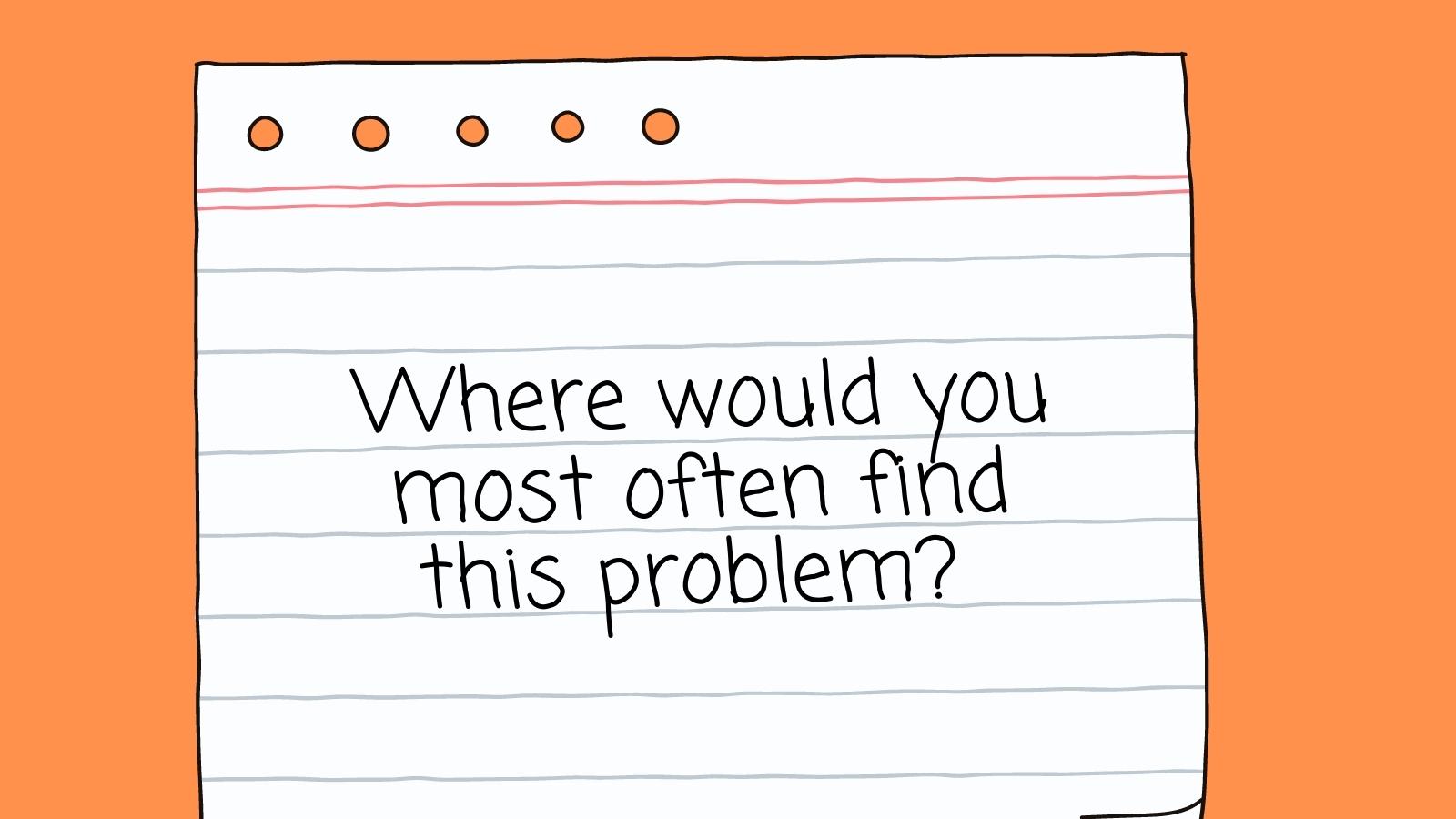
In an age of “fake news” claims and constant argument about pretty much any issue, critical thinking skills are key. Teach your students that it’s vital to ask questions about everything, but that it’s also important to ask the right sorts of questions. Students can use these critical thinking questions with fiction or nonfiction texts. They’re also useful when discussing important issues or trying to understand others’ motivations in general.
“Who” Critical Thinking Questions
Questions like these help students ponder who’s involved in a story and how the actions affect them. They’ll also consider who’s telling the tale and how reliable that narrator might be.
- Is the protagonist?
- Is the antagonist?
- Caused harm?
- Is harmed as a result?
- Was the most important character?
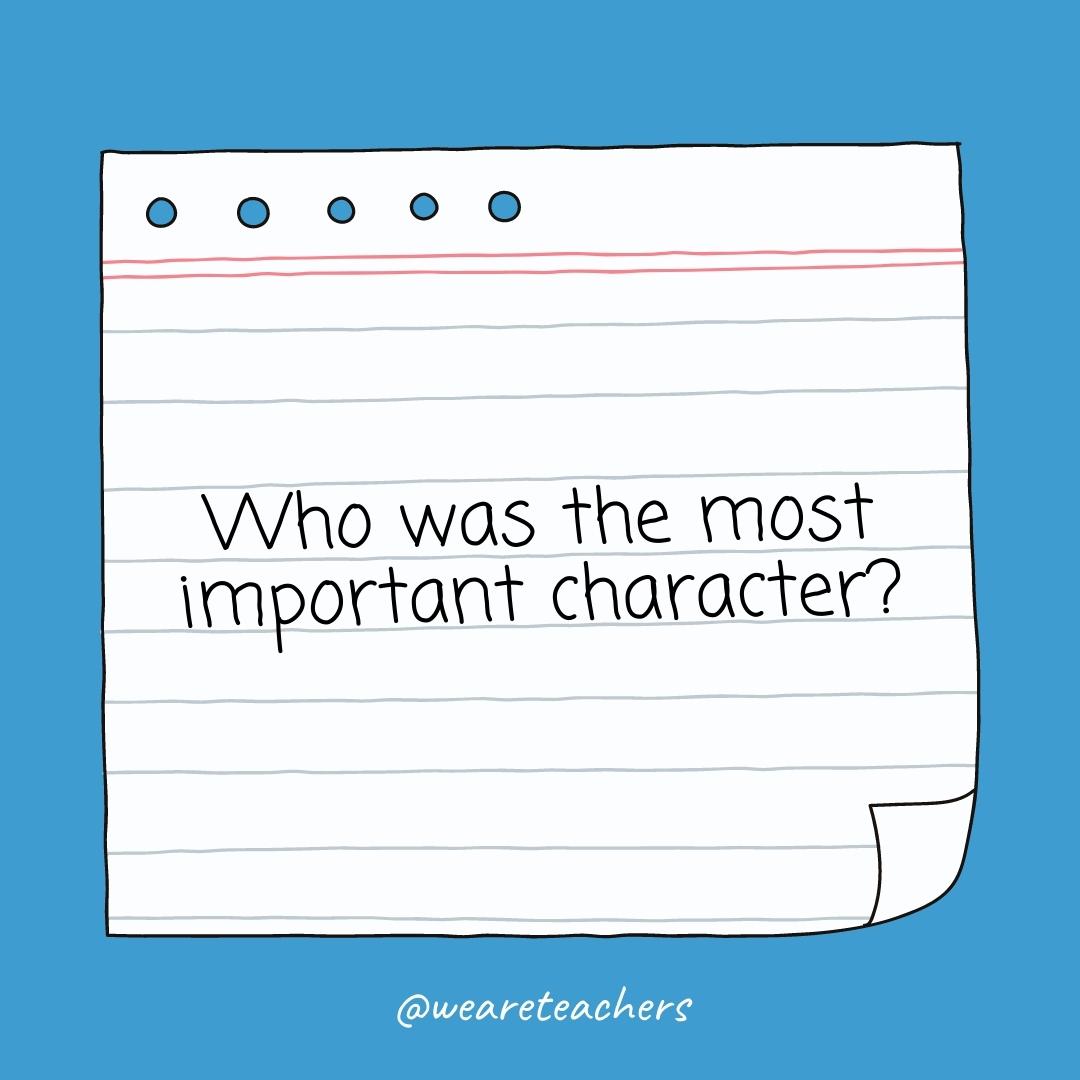
- Is responsible?
- Is most directly affected?
- Should have won?
- Will benefit?
- Would be affected by this?
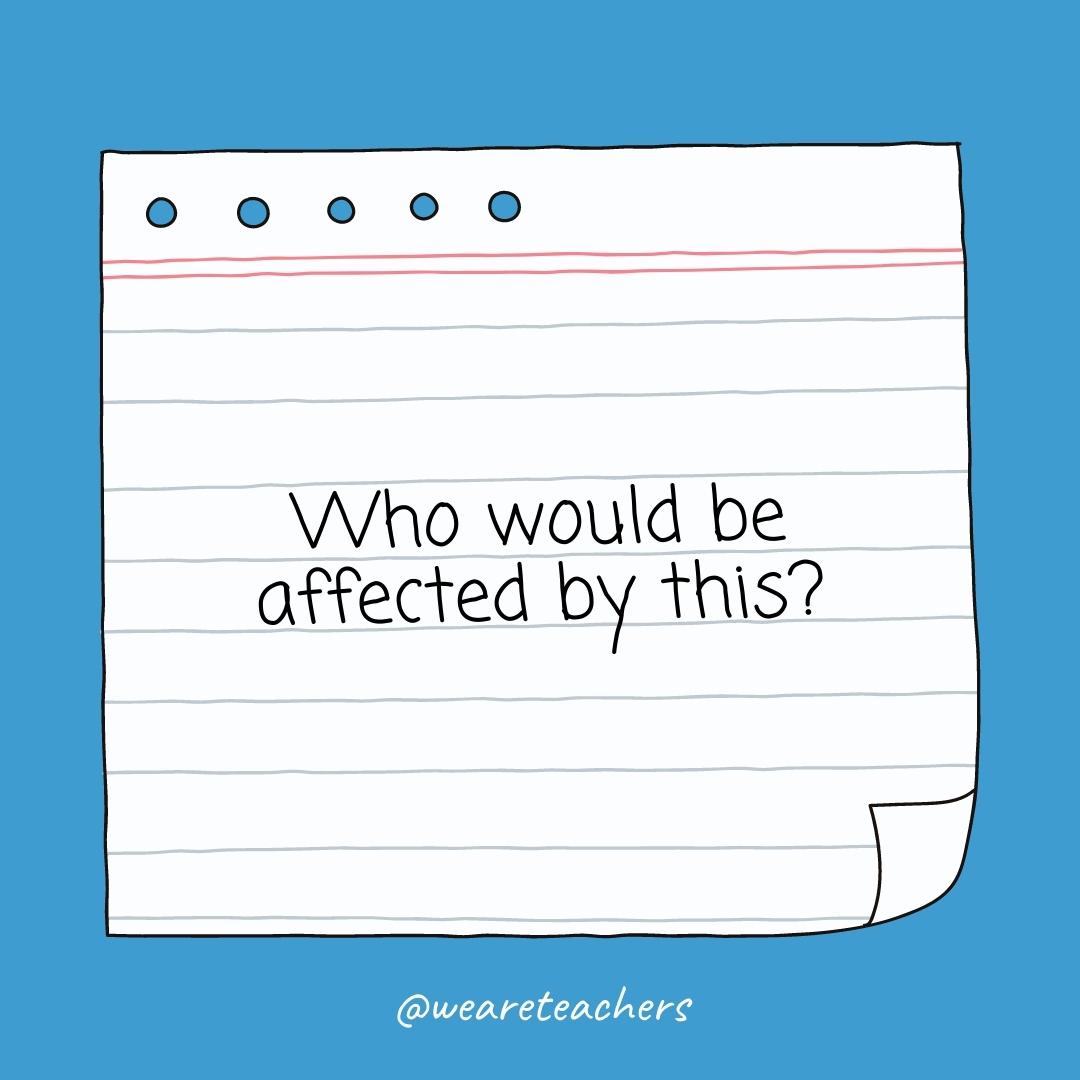
- Makes the decisions?
“What” Critical Thinking Questions
Ask questions that explore issues more deeply, including those that might not be directly answered in the text.
- Background information do I know or need to know?
- Is the main message?
- Are the defining characteristics?
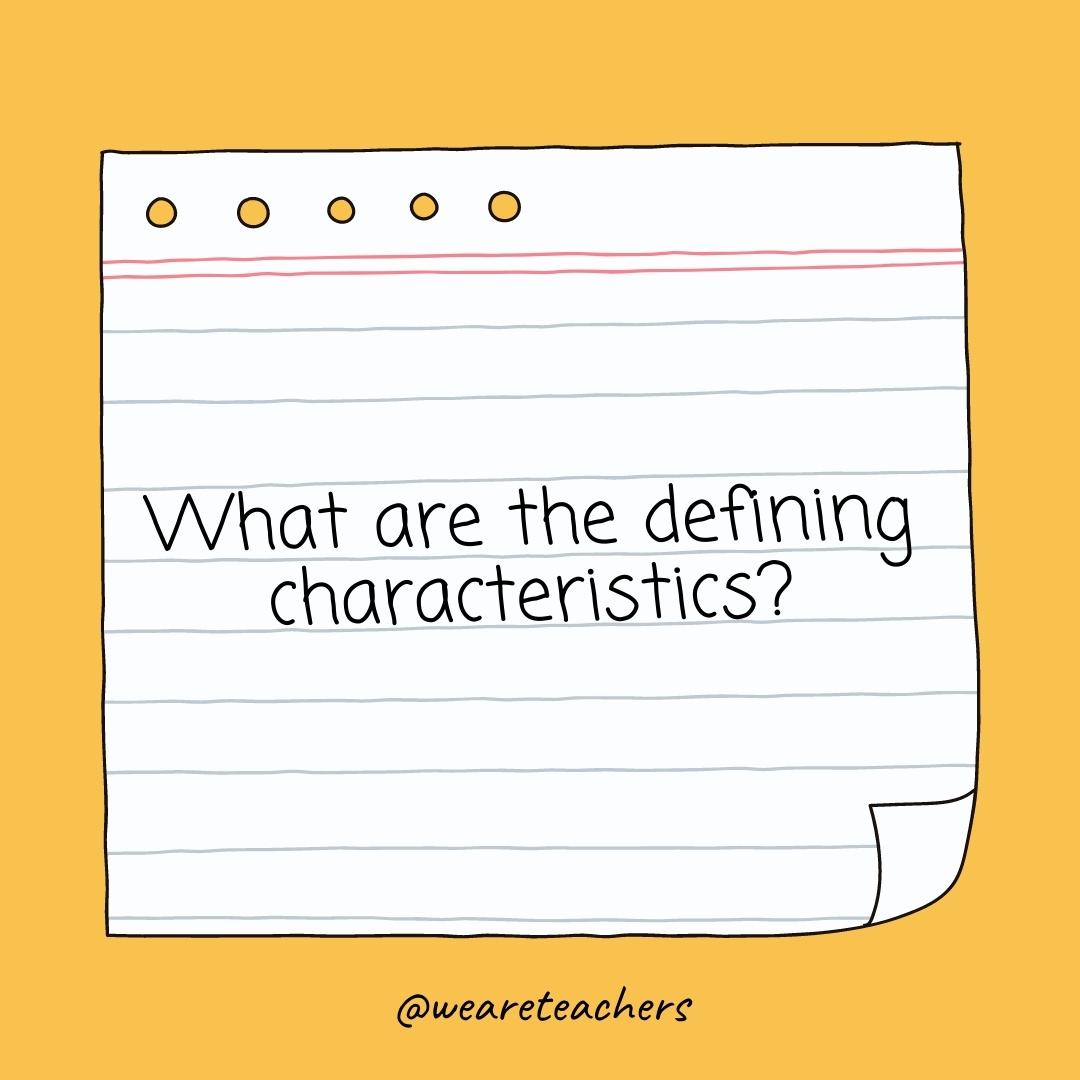
- Questions or concerns do I have?
- Don’t I understand?
- Evidence supports the author’s conclusion?
- Would it be like if … ?
- Could happen if … ?
- Other outcomes might have happened?
- Questions would you have asked?
- Would you ask the author about … ?
- Was the point of … ?
- Should have happened instead?
- Is that character’s motive?
- Else could have changed the whole story?
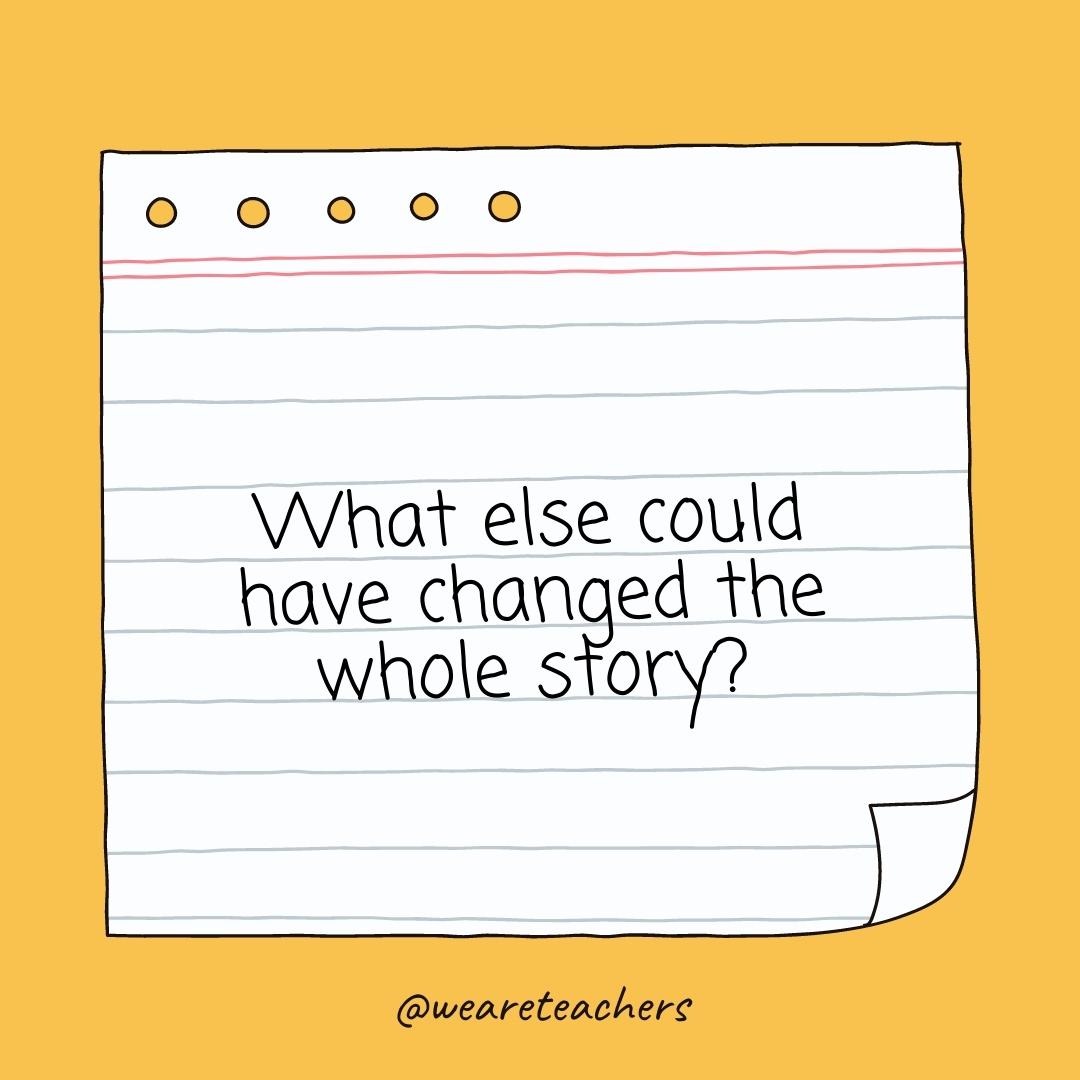
- Can you conclude?
- Would your position have been in that situation?
- Would happen if … ?
- Makes your position stronger?
- Was the turning point?
- Is the point of the question?
- Did it mean when … ?
- Is the other side of this argument?
- Was the purpose of … ?
- Does ______ mean?
- Is the problem you are trying to solve?
- Does the evidence say?
- Assumptions are you making?
- Is a better alternative?
- Are the strengths of the argument?
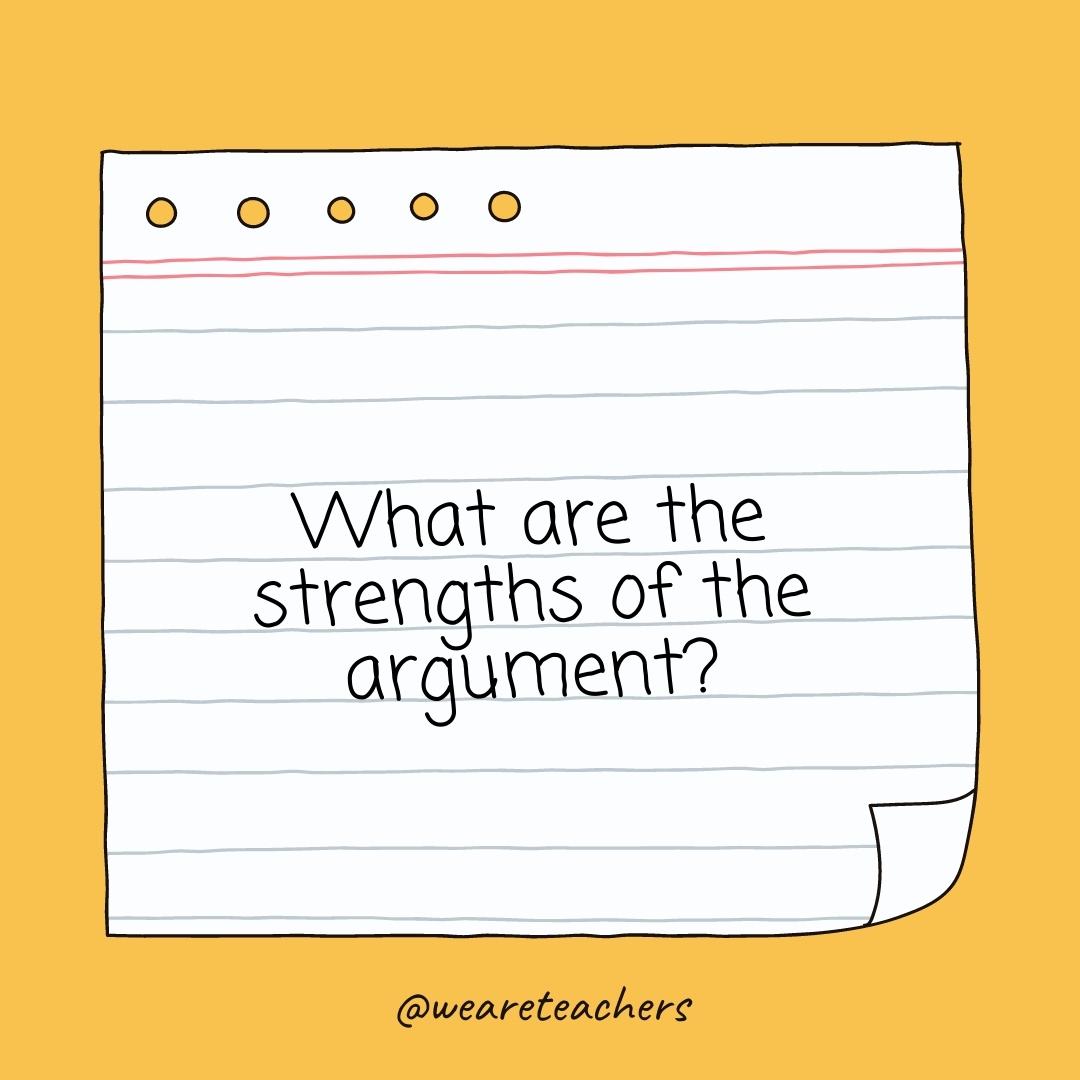
- Are the weaknesses of the argument?
- Is the difference between _______ and _______?
“Where” Critical Thinking Questions
Think about where the story is set and how it affects the actions. Plus, consider where and how you can learn more.
- Would this issue be a major problem?
- Are areas for improvement?
- Did the story change?
- Would you most often find this problem?

- Are there similar situations?
- Would you go to get answers to this problem?
- Can this be improved?
- Can you get more information?
- Will this idea take us?
“When” Critical Thinking Questions
Think about timing and the effect it has on the characters or people involved.
- Is this acceptable?
- Is this unacceptable?
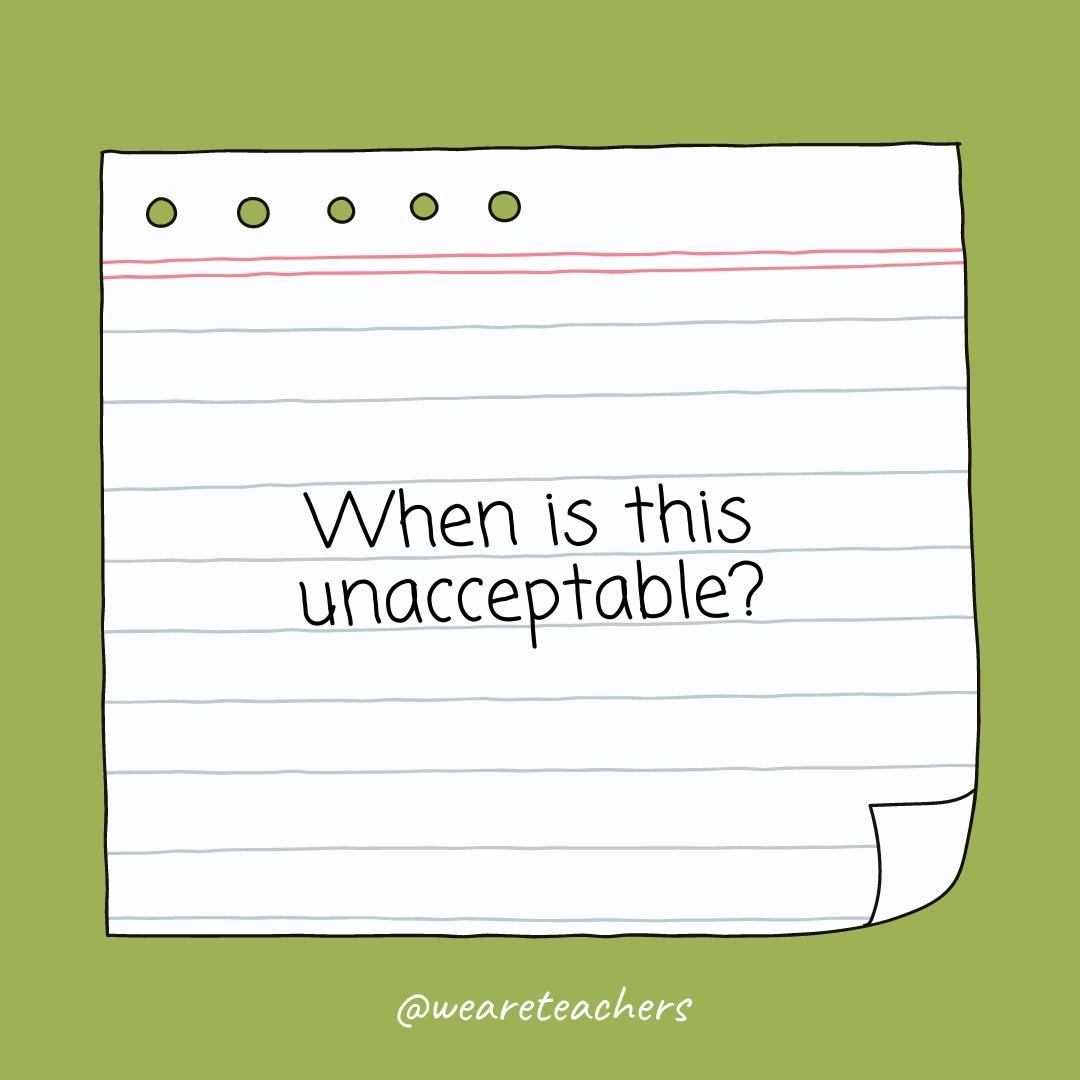
- Does this become a problem?
- Is the best time to take action?
- Will we be able to tell if it worked?
- Is it time to reassess?
- Should we ask for help?
- Is the best time to start?
- Is it time to stop?
- Would this benefit society?
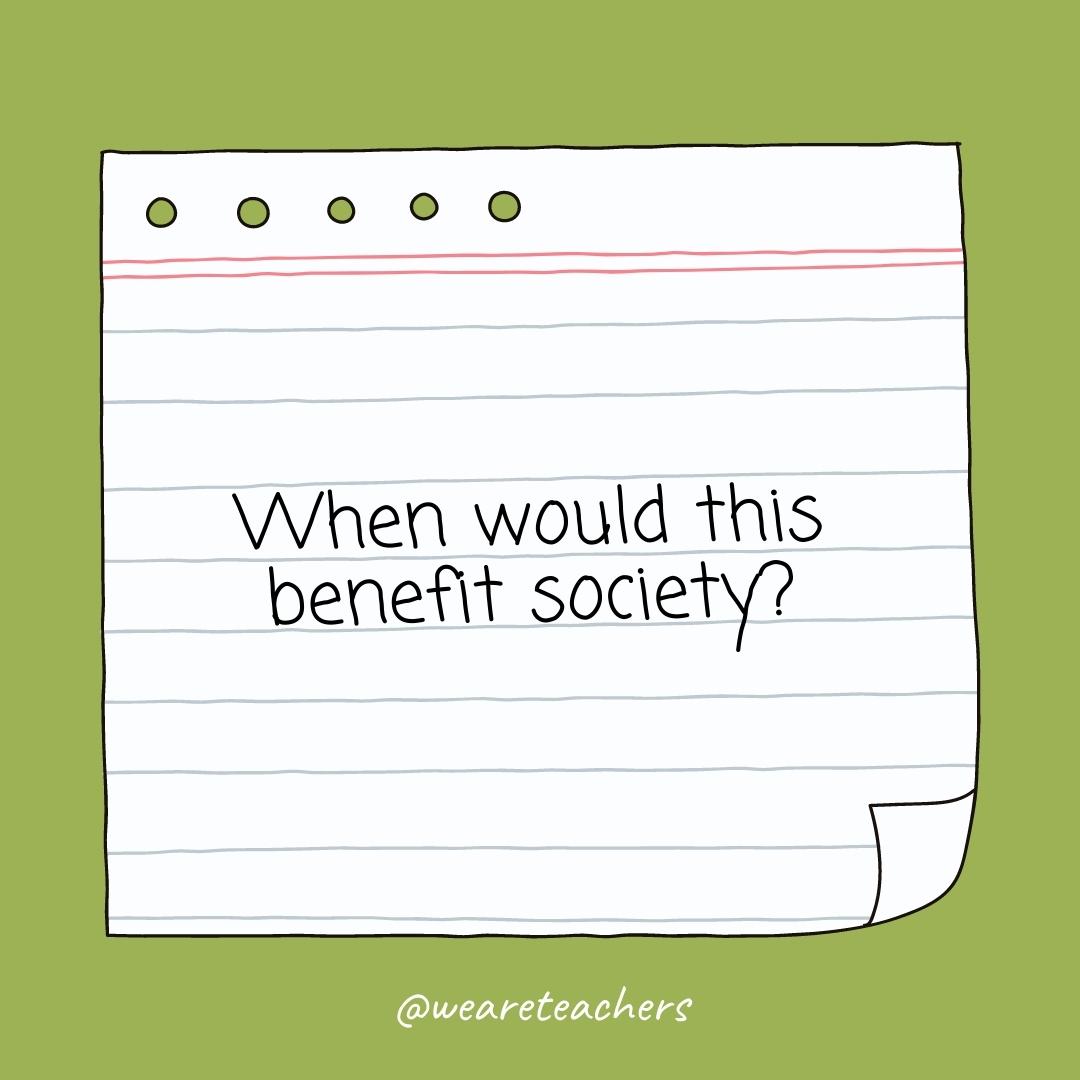
- Has this happened before?
“Why” Critical Thinking Questions
Asking “why” might be one of the most important parts of critical thinking. Exploring and understanding motivation helps develop empathy and make sense of difficult situations.
- Is _________ happening?
- Have we allowed this to happen?
- Should people care about this issue?
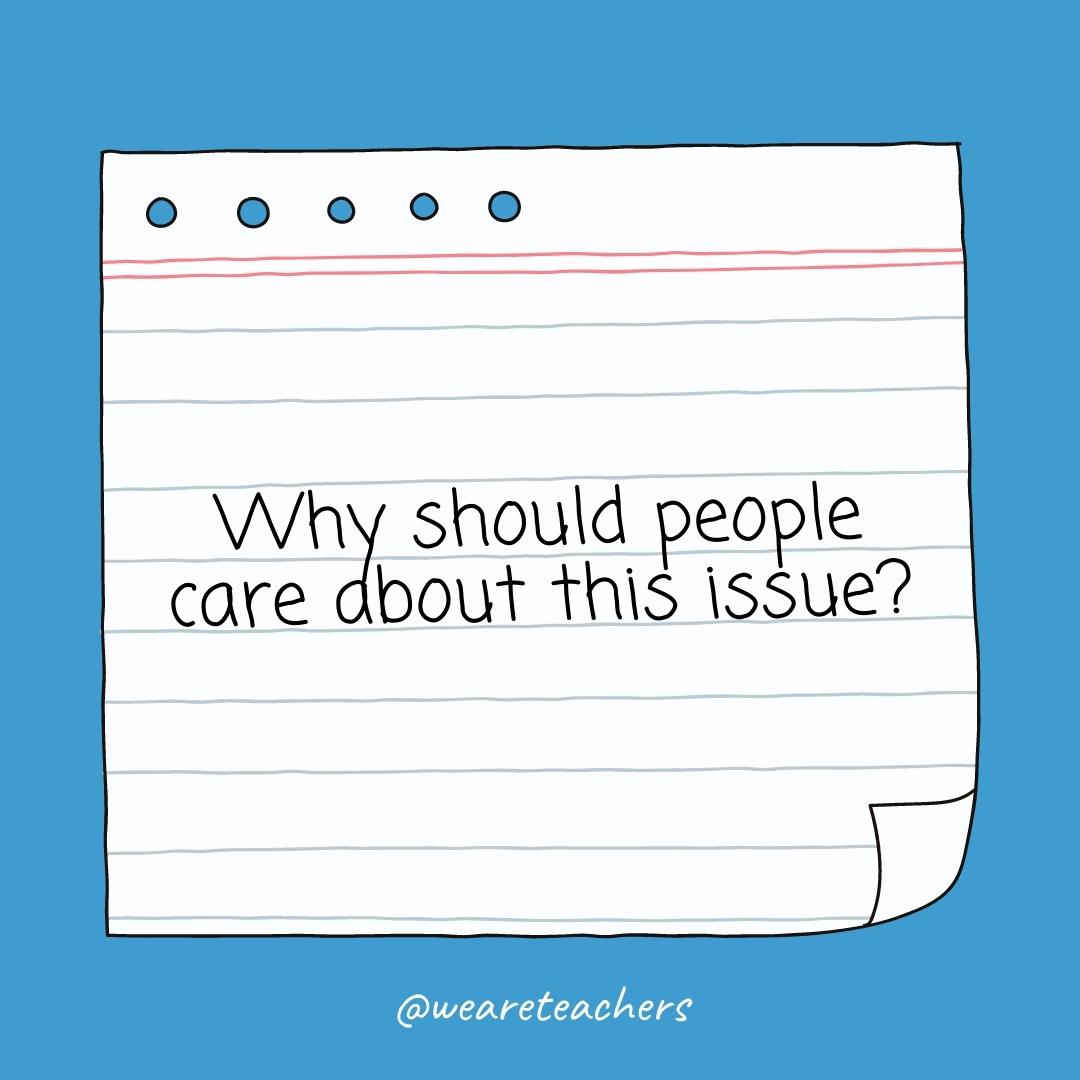
- Is this a problem?
- Did the character say … ?
- Did the character do … ?
- Is this relevant?
- Did the author write this?
- Did the author decide to … ?
- Is this important?
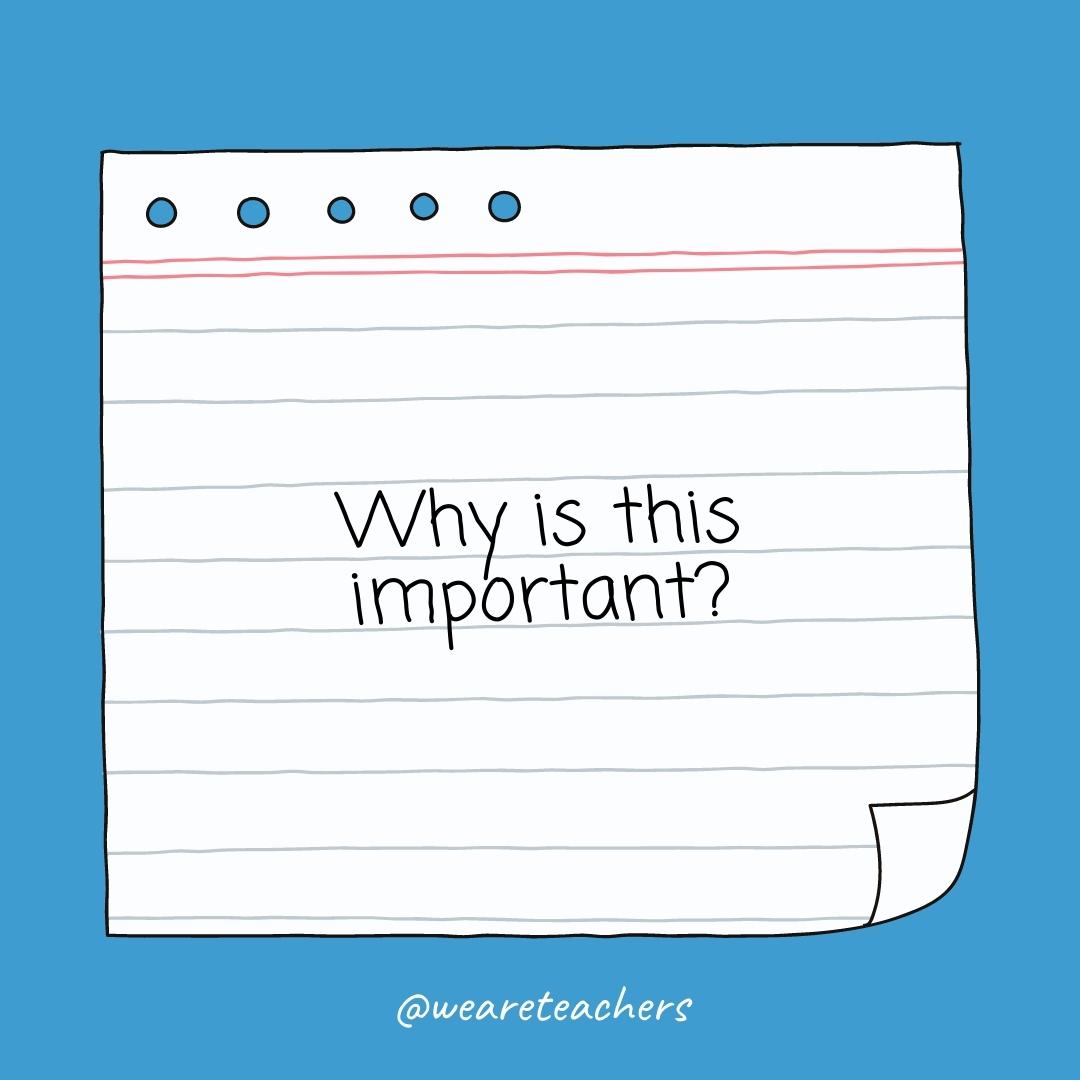
- Did that happen?
- Is it necessary?
- Do you think I (he, she, they) asked that question?
- Is that answer the best one?
- Do we need this today?
“How” Critical Thinking Questions
Use these questions to consider how things happen and whether change is possible.
- Do we know this is true?
- Does the language used affect the story?
- Would you solve … ?
- Is this different from other situations?
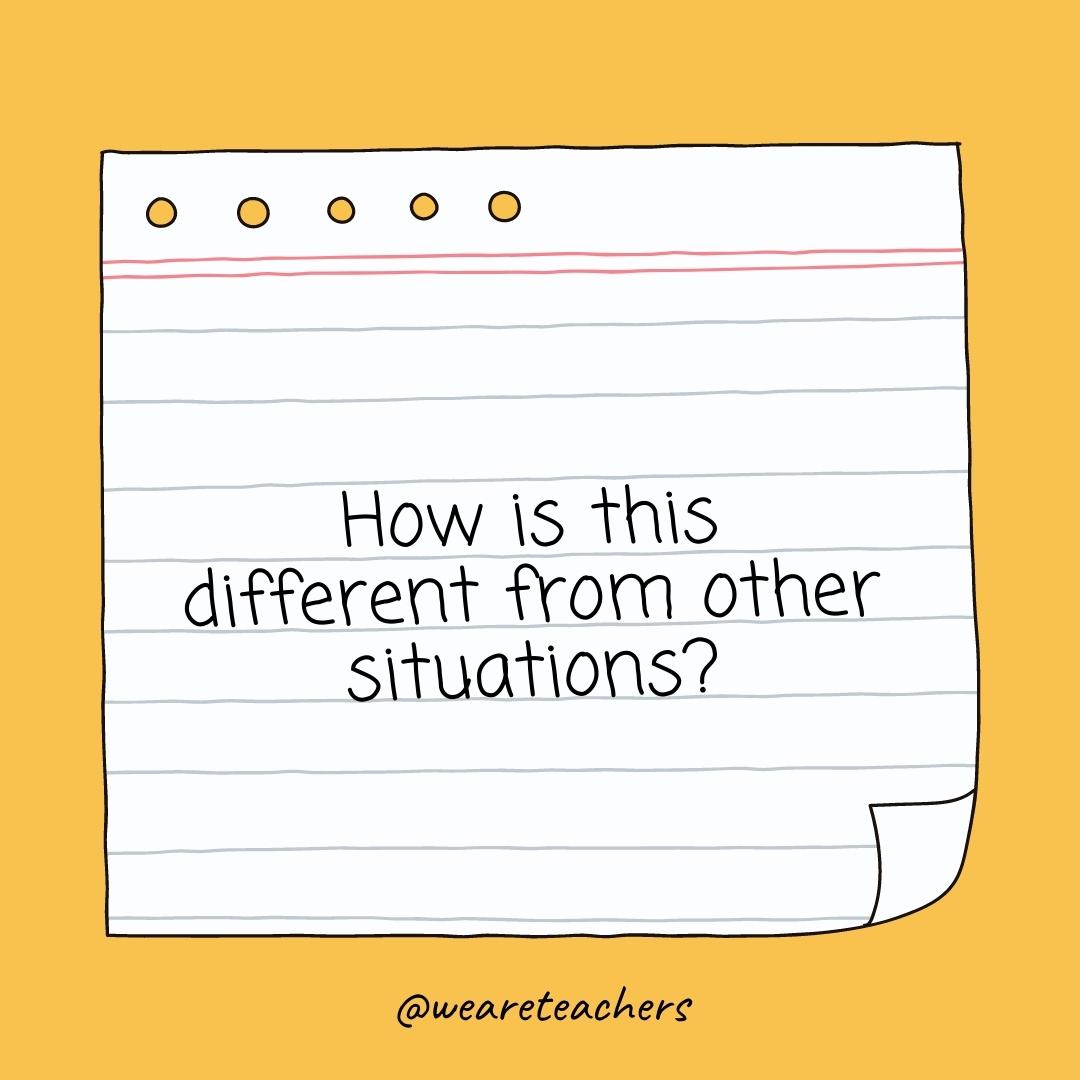
- Is this similar to … ?
- Would you use … ?
- Does the location affect the story?
- Could the story have ended differently?
- Does this work?
- Could this be harmful?
- Does this connect with what I already know?
- Else could this have been handled?
- Should they have responded?
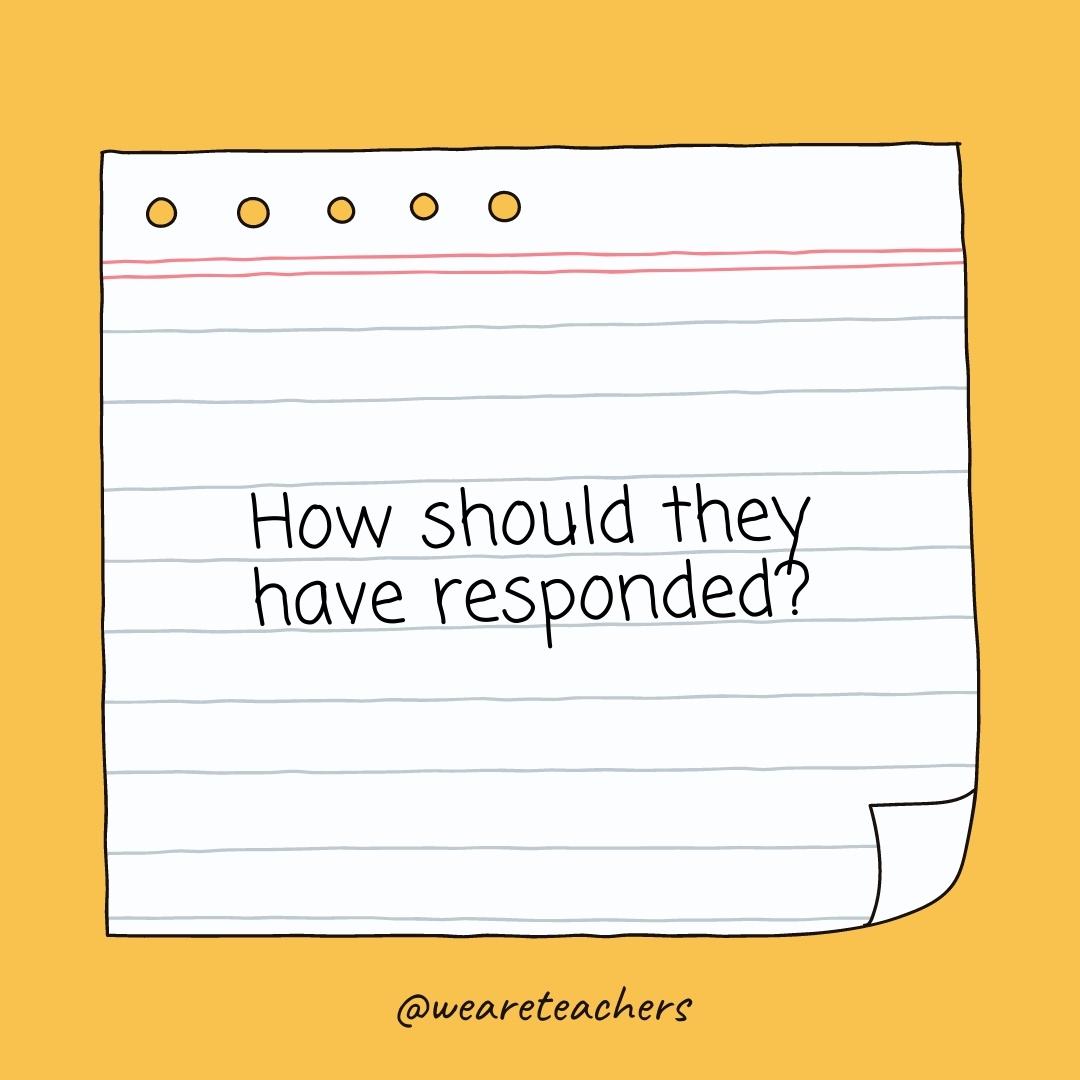
- Would you feel about … ?
- Does this change the outcome?
- Did you make that decision?
- Does this benefit you/others?
- Does this hurt you/others?
- Could this problem be avoided?
More Critical Thinking Questions
Here are more questions to help probe further and deepen understanding.
- Can you give me an example?
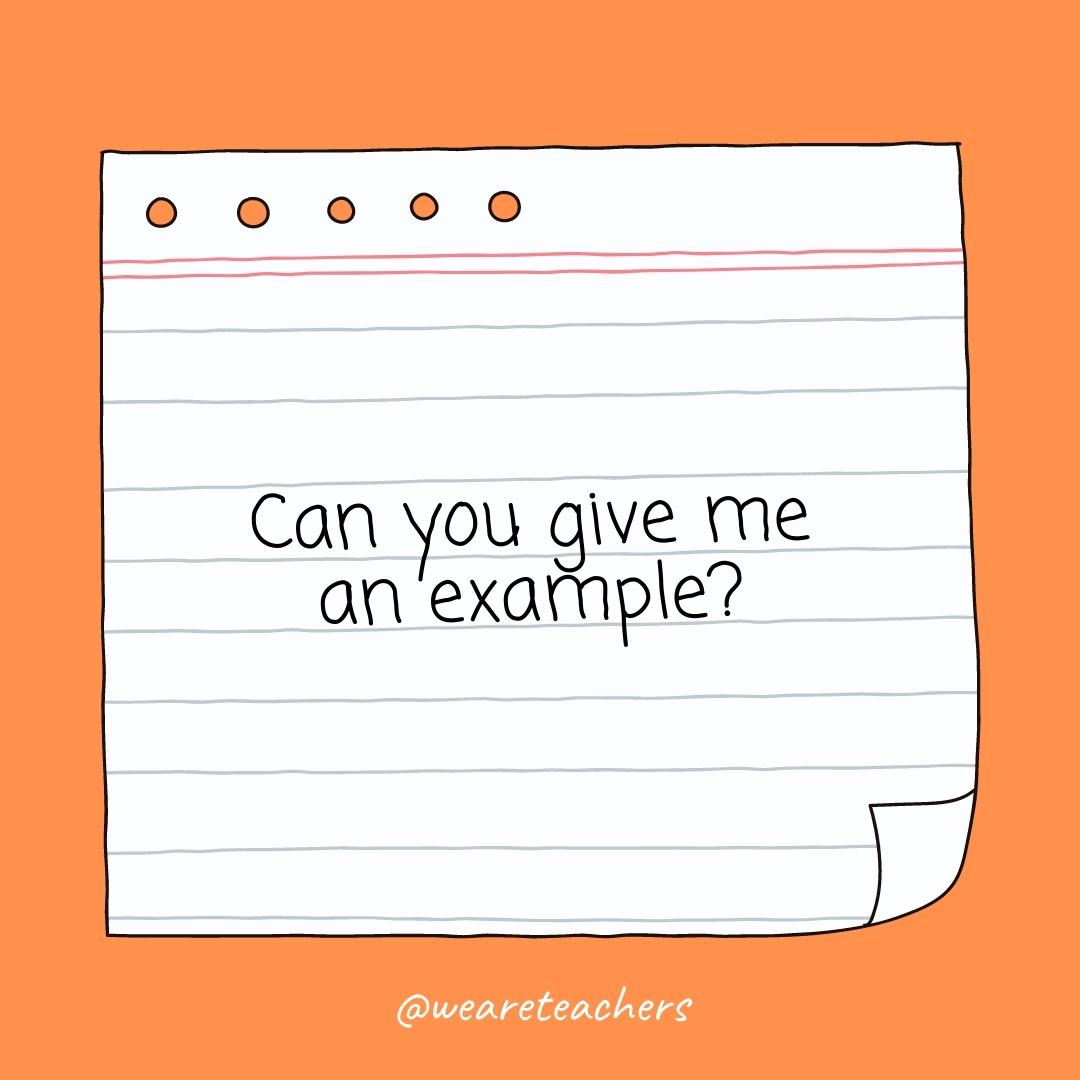
- Do you agree with … ?
- Can you compare this with … ?
- Can you defend the actions of … ?
- Could this be interpreted differently?
- Is the narrator reliable?
- Does it seem too good to be true?
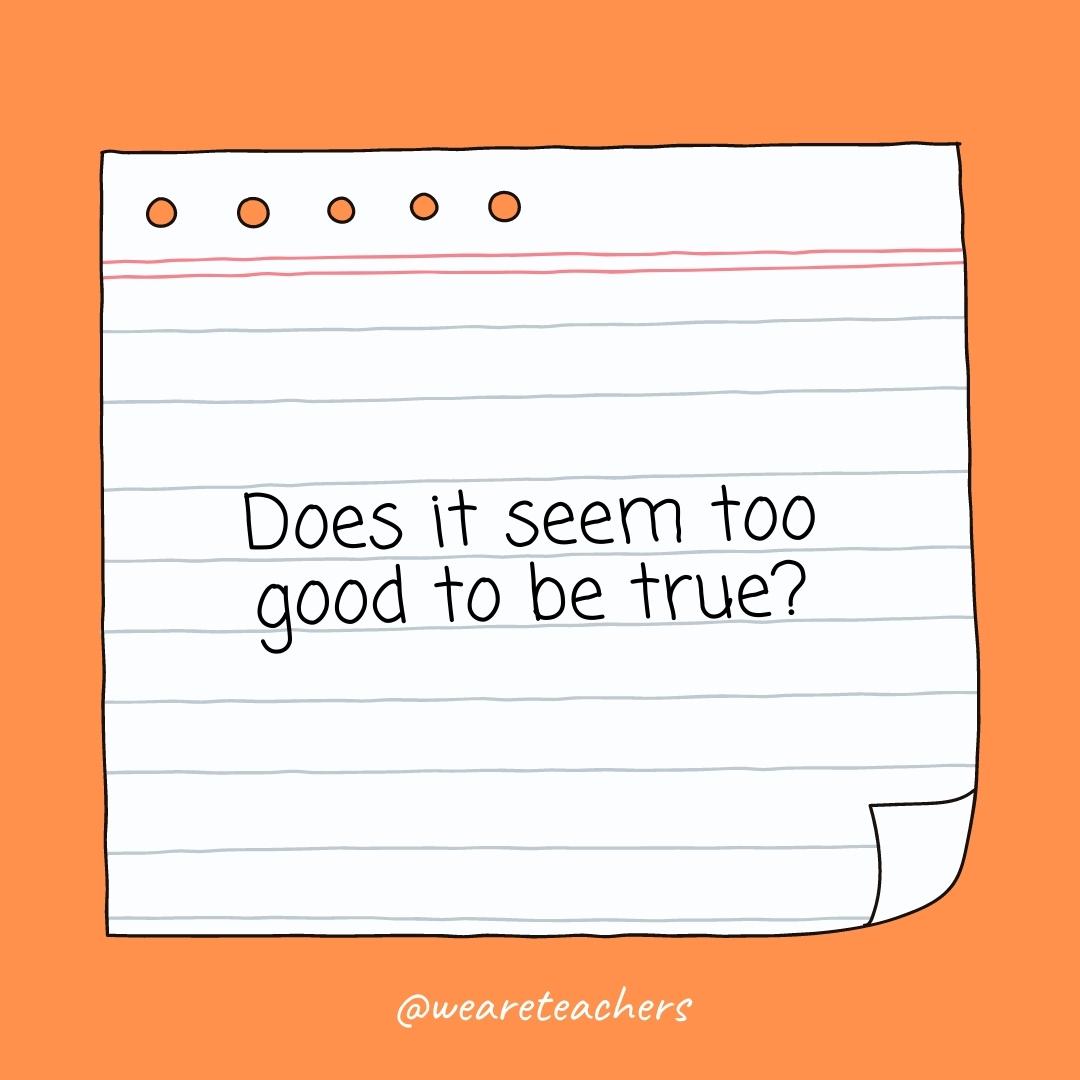
- Is ______ a fact or an opinion?
What are your favorite critical thinking questions? Come exchange ideas on the WeAreTeachers HELPLINE group on Facebook .
Plus, check out 10 tips for teaching kids to be awesome critical thinkers ., you might also like.
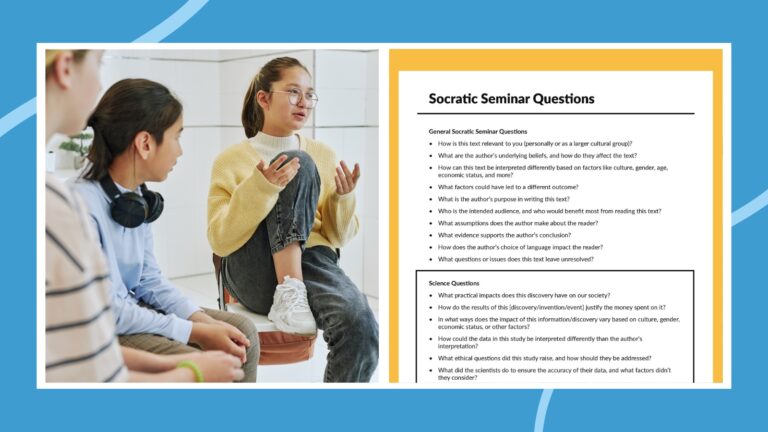
Socratic Seminar: Step-by-Step Guide and Questions (Free Printable)
Here's how to use this guided discussion strategy. Continue Reading
Copyright © 2024. All rights reserved. 5335 Gate Parkway, Jacksonville, FL 32256
- SUGGESTED TOPICS
- The Magazine
- Newsletters
- Managing Yourself
- Managing Teams
- Work-life Balance
- The Big Idea
- Data & Visuals
- Reading Lists
- Case Selections
- HBR Learning
- Topic Feeds
- Account Settings
- Email Preferences
The Case for Reading Fiction
- Christine Seifert

It’s an easy way to build emotional intelligence.
When it comes to reading, we may be assuming that reading for knowledge is the best reason to pick up a book. Research, however, suggests that reading fiction may provide far more important benefits than nonfiction. For example, reading fiction predicts increased social acuity and a sharper ability to comprehend other people’s motivations. Reading nonfiction might certainly be valuable for collecting knowledge, it does little to develop EQ, a far more elusive goal.
Some of the most valuable skills that managers look for in employees are often difficult to define, let alone evaluate or quantify: self-discipline, self-awareness, creative problem-solving, empathy, learning agility, adaptiveness, flexibility, positivity, rational judgment, generosity, and kindness, among others. How can you tell if your future employees have these skills? And if your current team is lacking them, how do you teach them? Recent research in neuroscience suggests that you might look to the library for solutions; reading literary fiction helps people develop empathy , theory of mind , and critical thinking .
- CS Christine Seifert is a professor of communication at Westminster College in Salt Lake City, Utah, where she teaches rhetoric, strategy, and professional writing
Partner Center

7 Puzzles to Challenge Your Critical Thinking
Can you spot the connections and sort these items.
Posted March 5, 2015 | Reviewed by Ekua Hagan

The theme of this post is critical thinking—and the kinds of puzzles that can be constructed around it. This term is used frequently in psychology and education . There are various definitions, but the one that best suits our purpose and which is, in the end, perhaps the best, is the ability to comprehend the logical connections among ideas, words, phrases, and concepts . In the relevant scientific literature, of course, the term is used much more broadly as a framework for understanding human cognition . But in my opinion, the best way to understand things is to construct puzzles to illustrate their basic essence.
Critical thinking involves skill at recognizing a pattern in given information and especially recognizing how the information is connected to the real world. Here are a couple of very simple examples. First, consider the five words below:
- Cruise ship
- Walking on foot
- Automobile (not a race car)
Now, put them in order from the slowest to the fastest, when they are going at maximum speed. The solution, of course, is: 4-2-5-1-3.
As with all such puzzles, there might be slightly different solutions—one could claim that some automobiles go faster than cruise ships. This “indeterminacy” characterizes this kind of thinking. However, some puzzles are straightforward. For instance, what do the following five things have in common?
The answer? These are all words referring to shades of blue.
The seven puzzles below are to the ones above, though hopefully more challenging. Some involve knowledge of facts, but critical thinking is still involved in such cases because the organization of the facts according to some principle is always involved—for example, a puzzle may ask you to put five items in order of their dates of invention.
The following tongue-in-cheek definition of critical thinking by Richard W. Paul, a leading expert on critical thinking theory, says it all: “Critical thinking is thinking about your thinking while you’re thinking in order to make your thinking better.”
I. What do the following 5 things have in common?
- Orange juice
II. Put the following buildings or structures in order of height, from the shortest to the tallest.
- Typical camping tent
III. What do the following animals have in common?
IV. Put the following inventions in order from earliest to most recent.
V. What feature do the following words have in common?
- Imagination
VI. Put these bodies of water in order in terms of volume, from smallest to largest .
VII. What do the following landmasses have in common?
I. They are all drinkable liquids. II. 5-1-4-3-2 III. They all have a tail. They are also all quadrupeds. IV. To the best of my knowledge: 5-4-3-1-2 V. They start with a vowel: a, e, i, o, u VI. 4-2-1-5-3 VII. They are all peninsulas.

Marcel Danesi, Ph.D. , is a professor of semiotics and anthropology at Victoria College, University of Toronto. His books include The Puzzle Instinct and The Total Brain Workout .
- Find a Therapist
- Find a Treatment Center
- Find a Psychiatrist
- Find a Support Group
- Find Online Therapy
- United States
- Brooklyn, NY
- Chicago, IL
- Houston, TX
- Los Angeles, CA
- New York, NY
- Portland, OR
- San Diego, CA
- San Francisco, CA
- Seattle, WA
- Washington, DC
- Asperger's
- Bipolar Disorder
- Chronic Pain
- Eating Disorders
- Passive Aggression
- Personality
- Goal Setting
- Positive Psychology
- Stopping Smoking
- Low Sexual Desire
- Relationships
- Child Development
- Self Tests NEW
- Therapy Center
- Diagnosis Dictionary
- Types of Therapy

At any moment, someone’s aggravating behavior or our own bad luck can set us off on an emotional spiral that threatens to derail our entire day. Here’s how we can face our triggers with less reactivity so that we can get on with our lives.
- Emotional Intelligence
- Gaslighting
- Affective Forecasting
- Neuroscience
JavaScript seems to be disabled in your browser. For the best experience on our site, be sure to turn on Javascript in your browser.
- Order Tracking
- Create an Account

200+ Award-Winning Educational Textbooks, Activity Books, & Printable eBooks!
- Compare Products
Reading, Writing, Math, Science, Social Studies
- Search by Book Series
- Algebra I & II Gr. 7-12+
- Algebra Magic Tricks Gr. 2-12+
- Algebra Word Problems Gr. 7-12+
- Balance Benders Gr. 2-12+
- Balance Math & More! Gr. 2-12+
- Basics of Critical Thinking Gr. 4-7
- Brain Stretchers Gr. 5-12+
- Building Thinking Skills Gr. Toddler-12+
- Building Writing Skills Gr. 3-7
- Bundles - Critical Thinking Gr. PreK-9
- Bundles - Language Arts Gr. K-8
- Bundles - Mathematics Gr. PreK-9
- Bundles - Multi-Subject Curriculum Gr. PreK-12+
- Bundles - Test Prep Gr. Toddler-12+
- Can You Find Me? Gr. PreK-1
- Complete the Picture Math Gr. 1-3
- Cornell Critical Thinking Tests Gr. 5-12+
- Cranium Crackers Gr. 3-12+
- Creative Problem Solving Gr. PreK-2
- Critical Thinking Activities to Improve Writing Gr. 4-12+
- Critical Thinking Coloring Gr. PreK-2
- Critical Thinking Detective Gr. 3-12+
- Critical Thinking Tests Gr. PreK-6
- Critical Thinking for Reading Comprehension Gr. 1-5
- Critical Thinking in United States History Gr. 6-12+
- CrossNumber Math Puzzles Gr. 4-10
- Crypt-O-Words Gr. 2-7
- Crypto Mind Benders Gr. 3-12+
- Daily Mind Builders Gr. 5-12+
- Dare to Compare Math Gr. 2-7
- Developing Critical Thinking through Science Gr. 1-8
- Dr. DooRiddles Gr. PreK-12+
- Dr. Funster's Gr. 2-12+
- Editor in Chief Gr. 2-12+
- Fun-Time Phonics! Gr. PreK-2
- Half 'n Half Animals Gr. K-4
- Hands-On Thinking Skills Gr. K-1
- Inference Jones Gr. 1-6
- James Madison Gr. 10-12+
- Jumbles Gr. 3-5
- Language Mechanic Gr. 4-7
- Language Smarts Gr. 1-4
- Mastering Logic & Math Problem Solving Gr. 6-9
- Math Analogies Gr. K-9
- Math Detective Gr. 3-8
- Math Games Gr. 3-8
- Math Mind Benders Gr. 5-12+
- Math Ties Gr. 4-8
- Math Word Problems Gr. 4-10
- Mathematical Reasoning Gr. Toddler-11
- Middle School Science Gr. 6-8
- Mind Benders Gr. PreK-12+
- Mind Building Math Gr. K-1
- Mind Building Reading Gr. K-1
- Novel Thinking Gr. 3-6
- OLSAT® Test Prep Gr. PreK-K
- Organizing Thinking Gr. 2-8
- Pattern Explorer Gr. 3-9
- Practical Critical Thinking Gr. 8-12+
- Punctuation Puzzler Gr. 3-8
- Reading Detective Gr. 3-12+
- Red Herring Mysteries Gr. 4-12+
- Red Herrings Science Mysteries Gr. 4-9
- Science Detective Gr. 3-6
- Science Mind Benders Gr. PreK-3
- Science Vocabulary Crossword Puzzles Gr. 4-6
- Sciencewise Gr. 4-12+
- Scratch Your Brain Gr. 2-12+
- Sentence Diagramming Gr. 3-12+
- Smarty Pants Puzzles Gr. 3-12+
- Snailopolis Gr. K-4
- Something's Fishy at Lake Iwannafisha Gr. 5-9
- Teaching Technology Gr. 3-12+
- Tell Me a Story Gr. PreK-1
- Think Analogies Gr. 3-12+
- Think and Write Gr. 3-8
- Think-A-Grams Gr. 4-12+
- Thinking About Time Gr. 3-6
- Thinking Connections Gr. 4-12+
- Thinking Directionally Gr. 2-6
- Thinking Skills & Key Concepts Gr. PreK-2
- Thinking Skills for Tests Gr. PreK-5
- U.S. History Detective Gr. 8-12+
- Understanding Fractions Gr. 2-6
- Visual Perceptual Skill Building Gr. PreK-3
- Vocabulary Riddles Gr. 4-8
- Vocabulary Smarts Gr. 2-5
- Vocabulary Virtuoso Gr. 2-12+
- What Would You Do? Gr. 2-12+
- Who Is This Kid? Colleges Want to Know! Gr. 9-12+
- Word Explorer Gr. 6-8
- Word Roots Gr. 3-12+
- World History Detective Gr. 6-12+
- Writing Detective Gr. 3-6
- You Decide! Gr. 6-12+

Tell Me a Story
Storybooks that teach critical thinking.
Grades: PreK-1
Critical Thinking, Language Arts
- Award Winner
This fun, easy to use picture book is made up of two stories. Students tell each story by analyzing the pictures and responding to the guided questions on each page. The questions are engaging and produce a deeper analysis of the scene and the storyline by encouraging students to provide details, describe events, explain motives, make evidence-based predictions, and use cause and effect leading up to the scene. Each story develops important critical and creative thinking skills.
- Observation
- Identifying and evaluating evidence
- Comparing and contrasting shapes and objects
- Inference (evidence-based prediction)
- Cause and effect
- Identify and describing a sequence of events
These stories also develop pre-reading skills. Pre-readers progress from “listening” to a story to “telling” a story, becoming more engaged in the reading process as they identify and shape the storyline. Reading involves more than just decoding written text. A large part of reading is gaining meaning from symbols—both letters and pictures.
Description and Features
All products in this series.
• Our eBooks digital, electronic versions of the book pages that you may print to any paper printer. • You can open the PDF eBook from any device or computer that has a PDF reader such as Adobe® Reader®. • Licensee can legally keep a copy of this eBook on three different devices. View our eBook license agreement details here . • You can immediately download your eBook from "My Account" under the "My Downloadable Product" section after you place your order.
- Add to Cart Add to Cart Remove This Item
- Special of the Month
- Sign Up for our Best Offers
- Bundles = Greatest Savings!
- Sign Up for Free Puzzles
- Sign Up for Free Activities
- Toddler (Ages 0-3)
- PreK (Ages 3-5)
- Kindergarten (Ages 5-6)
- 1st Grade (Ages 6-7)
- 2nd Grade (Ages 7-8)
- 3rd Grade (Ages 8-9)
- 4th Grade (Ages 9-10)
- 5th Grade (Ages 10-11)
- 6th Grade (Ages 11-12)
- 7th Grade (Ages 12-13)
- 8th Grade (Ages 13-14)
- 9th Grade (Ages 14-15)
- 10th Grade (Ages 15-16)
- 11th Grade (Ages 16-17)
- 12th Grade (Ages 17-18)
- 12th+ Grade (Ages 18+)
- Test Prep Directory
- Test Prep Bundles
- Test Prep Guides
- Preschool Academics
- Store Locator
- Submit Feedback/Request
- Sales Alerts Sign-Up
- Technical Support
- Mission & History
- Articles & Advice
- Testimonials
- Our Guarantee
- New Products
- Free Activities
- Libros en Español
16 Critical Thinking Examples in Real Life
What is critical thinking.
While making your academic assignments or thesis, you are required to do some research and analyze various things, or for making a career decision or any other decision you are required to think of all pros and cons of that decision. Well, the most important thing that helps us to effectively take these decisions is what we call critical thinking. Critical thinking is very important in both personal and professional life. The process of critical thinking involves the analysis of the various facts and figures in a particular situation before straightaway acting on that situation. Critical thinking demands keen observation, creativity, problem-solving skills, which helps the individual to thoroughly evaluate the gathered information and then use this available information as a guide to making accurate decisions. From doing academic works or regular activities to solving various large scale problems, critical thinking is required in everyday life. In this article, we will learn about some real-life examples where critical thinking plays an important role.
Critical Thinking Examples in Real Life
1. critical thinking in problem solving.
Suppose your manager asks you to find an effective solution to a problem that is affecting the business. What would be your first step? Like most people, you may also start looking for potential solutions to deal with that situation. Well, one requires the use of critical thinking here. Before looking for the solution one needs to take a step back and try to understand the cause of the problem first. One should ask for the opinions of the other people that how does this particular problem impact them and the overall business. If you arrive at a solution, you should not only just rely on one solution, instead, you should always have various backup plans in case the first solution does not work as expected. Most people feel that they are great at problem-solving, but if one is not following all these above discussed steps before making a final judgement, he/she is not a critical thinker. Critical thinking allows people to find the best possible solution to any problem. Critical thinking is an important factor of problem-solving skills, one needs to look at any situation from multiple perspectives because in some cases, your decisions not only impact you but also the people in your surrounding.
2. Critical Thinking in Analysing Risks
Risk assessment is another important factor, which requires the use of critical thinking. Risk assessment is required in various sectors, from children analysing the impact of eating junk food on their health to large businesses in analysing the impact of certain policies on the growth of the company. Let us understand the implication of critical thinking in analysing the risks with some examples.
3. Critical Thinking in Data Analysis
Whether analysing the performance of the children in the schools or analysing the business growth of a multi-national company, the skill of data analysis is very crucial. In today’s era, almost every sector demands experts that can accurately evaluate the available data or information and draw out effective conclusions from it. With the rise in technology, the various tasks of the data analysis such as finding profit and loss, creating balance sheets, and issuing invoices are done with the help of various software, but it does not mean that human skill is not required. Various kinds of software can just convert a large amount of data into some simpler and readable format, but it is the critical thinking of the humans that is required to effectively interpret the data and apply the obtained insight for the benefits. The data analysis can even help us to estimate the future trends and potential risks of taking any decisions.
4. Critical Thinking in Hiring Employees
The ability to objectively view any situation without getting influenced by your personal beliefs or thoughts is one of the important characteristics of critical thinking. In business, the hiring managers require critical thinking to evaluate a large number of resume’s to choose the suitable candidates for the required position. Critical thinking here enables the hiring managers not to hire a candidate on the basis of various factors like gender, age, religion or country, these factors may influence the hiring managers unconsciously. The hiring manager may tend to choose the candidate on his/her subjective beliefs if he/she does not use critical thinking. Hence, critical thinking can help HR’s to hire the best employees that may eventually lead to the growth of the company.
5. Promoting the Teamwork
In a team, every individual is unique and has his/her different ideas to tackle the proposed problem. It is the responsibility of the team leader to understand the perspective of each member and encourage them to work collectively to solve the common problem. You may find the opinion of the other members of your team as ineffective, but instead of straightway denying their opinions one should logically analyse their suggestions and try to put your point of view regarding the problem in an effective and calm manner. If the team leader does not use critical thinking, instead, he/she boost his/her opinions on others, the team is sure to collapse.
6. Critical Thinking in Self-Evaluation
Critical thinking plays a major role in self-evaluation. The knowledge of critical thinking skills allows you to accurately analyse your performance by controlling various subjective biases. People should always evaluate their reactions towards any situation and the way they think, this may help them to get a deep insight into their thought processes, hence improving their thinking abilities to take accurate decisions. Self-evaluation is very important in professional life too. Suppose your manager has set a new target for the company. Every employee is thus required to analyse his/her contribution to the company and try to accomplish the set target. If you know your contribution to the company, it will help you to analyse your performance, and you can try to improve your performance in the areas where you lag.
7. Critical Thinking in Choosing the Career
Almost all of us face various dilemmas in our lives such as choosing the stream, the type of job, choosing between the regular college degree or the online programme. Whatever you choose, every option has its pros and cons. However, critical thinking allows us to accurately weigh the positives and negatives of each option and choose the one that offers more benefits than drawbacks. The best way to do this is to make a list of the pros and the cons and then analyse. Well, this is not just limited to choosing the career path, it can be used in other situations also such as professionally, and financially. One can list the pros and cons of selecting to work in a specific company or choosing the right insurance plan. It is often seen that our choices are greatly influenced by the choices of our friends or known, but one should understand that every individual’s beliefs, desires, and ambitions are different so, if the particular carrear or job is best for the others it does not mean that it would be the best option for you also. Hence, to choose the right carrear path, one requires critical thinking.
8. Critical Thinking in Time Management
Time is the most valuable asset that we have, hence utilizing it appropriately is very crucial. Critical thinking in time management helps you to wisely plan your schedule according to the importance of the particular task or the activity. For example, if the task to which you devote most of your time, is not giving you much return then you need to reconsider your schedule and should devote more time to the tasks that give you high returns.
9. Critical Thinking in Analysing the Fake News
Suppose, one of your friends shares a piece of news with you. Do you bother to analyse that whether this piece of news is real or not? Many of us just believe in the news and shares this with others too without thinking that this can be fake news too. A study conducted by Stanford University showed that around 82 per cent of the teenagers failed to distinguish between the real news and the advertisement with the ‘sponsored content’ label. This problem arises because the standard education curriculum does not emphasise much on critical thinking skills much because of the assumption that critical thinking is inbuilt in every person. By introducing certain lessons or activities that may help to increase the knowledge or overall thinking skills, the critical thinking of the children can be improved. Well, it is also seen that not only children, but adults also fall for these fake news and articles that circulate on various social media platforms. Before believing any piece of information, one should think of various questions like the source of the publication, the intention of the article, the author of the article, and the agenda behind the article. Critical thinking helps us to precisely evaluate any information before straightway believing it.
10. Critical Thinking in Distinguishing between Right and Wrong
Most people, especially teenagers are very much conscious about what their friends or relatives think of their behaviour. You may have had been through the situation, wherein if your friends think that certain behaviour is cool then you start acting in that way to fit in your friend’s circle without even considering that what you are doing is good or bad, and is your actions are related to your beliefs or not? One should understand that if a certain behaviour seems cool to some people, it may also seem bad to some others. One should not change his/her actions depending upon the approval of certain people, rather one should look at the broader aspect and should deeply analyse that whether their actions are morally right or wrong.
11. Critical Thinking in Decoding Fashion Trends
Nowadays, some people are so crazy about following the latest fashion trends, they start following every trend that some popular actor, actress, or fashion influencer suggest. If you are a critical thinker you may have had thought of the questions like why the particular trend that was so popular a few years back seems foolish now? why does a particular trend that does not even look good is so popular? Do the particular fashion trend that suits the other person suits yourself or not? Critical thinking helps people from falling victim to the bandwagon fallacy; it is fallacy in which people starts believing a particular thing or idea as good or bad if the majority of the population thinks so. Fashion trends are a common example of bandwagon fallacy.
12. Critical Thinking in Choosing the Suitable Diet and Exercise
You must have heard of various types of diets such as the Keto diet, Whole 30 diet, Gluten-free diet, Vegan diet and so on. It seems complex to choose the diet that is best for you. What people usually do is that they search online, go through several videos and choose the diet that showed the best results to the person in the video. Well, this is not the right approach, choosing the best diet for yourself requires critical thinking. People who use critical thinking evaluate the pros and cons of the particular diet on their own body, they generally ask about the suitable diet from professional dieticians rather than just following the advice of a random person online. Like choosing a suitable diet, choosing a suitable exercise also demands critical thinking. For example, What are your goals? How can you achieve this? At what time you can do exercise? Do you have any injuries that may get affected by the particular exercise? People who use critical thinking tend to ask all these questions, and then by utilizing the knowledge they have and the following routine for a few weeks, and by analyzing the results they are getting from it, they finally plan a proper schedule for them.
13. Critical Thinking in Online Shopping
In today’s digital era, online shopping is preferred by most people. However, there are various tactics and psychological tricks such as the anchoring effect , Stroop effect , and Serial position effect that are used by the various e-commerce websites, which makes the customers buy more things or things that they don’t even need. Critical thinking can help people to smartly buy items without falling victim to all these effects or tactics. While making the purchase you should focus on the price that you are paying for the particular item rather than the discount you are getting on that item because the chances are that the price that you are paying for that item is not worth paying even after the discount.
14. Critical Thinking in Job Search
Critical thinking plays an important role in the Job search. If you are applying for a job, you may consider the following points to get the desired job.
Use of Keywords in Resume: One should always understand the job post and its requirements before straightaway applying for the job. It is important to update your resume according to the job and add some keywords (mentioned in the job requirements) into your resume to get the job. If you possess some critical thinking skills such as problem-solving, analytical, communication, or creativity skills, it is better to put that in your resume. However, one should always restrain from adding any random critical thinking skills that you do not possess.
Cover Letter: Hiring managers receive hundreds of resumes daily, hence the chances that they will read every resume are quite less. Well, you can make your resume different from others by adding a good cover letter. You can add some of the critical skills that you have to your resume, it is better to explain a little about the tasks or activities where you showed these skills in your previous jobs or work experiences rather than just simply writing the skill. This assures the recruiter that you are not randomly writing the skills and you possess these qualities.
Interviews: Nowadays, some interviewers present the interviewees with hypothetical stories to check their critical thinking skills. You may be asked to explain what you think of the given situation or your first reaction after looking at the given image. You are required to solve any random problem, and then you have to explain to the recruiter about your thought processes. The interviewer here is more focused on the way you reach the conclusion rather than the conclusion itself. Your thought process helps the interviewer to analyse and evaluate the way you approach various problems
15. Critical Thinking While Driving
Imagine you are driving on a busy road and your phone starts ringing. It’s an urgent call that you have to pick. What would you do? Would you pick up the call and risk yourself into an accident or stop your car on the roadside to take the call. Critical thinking helps you to make accurate decisions while driving, it includes finding the right place to park your car, analysing whether you can pass the car through that narrow street or not, or how to handle if any animal suddenly comes in front of your car. Hence, critical thinking is must require skill in driving.
16. Critical Thinking in Business
Critical thinking is one of the most important things that the owner of the business needs to possess. One has to make several important decisions, effectively communicate with the clients, hire suitable employees, take certain risks, and deal with several ups and downs in the business, and much more; all these things require critical thinking.
Related Posts
12 Conflict Theory Examples in Real Life
12 Self-serving Bias Examples
9 Dunning-Kruger Effect Examples in Real Life
31 Vision Statement Examples for Business

8 Hypothesis Testing Examples in Real Life
10 Real Life Examples Of Gestalt Principles
Great post! I’ve been trying to apply critical thinking to my life, and these examples are a great way to start.
critical thinking is what anyone of us should have in spoiled world
Add Comment Cancel Reply
41+ Critical Thinking Examples (Definition + Practices)

Critical thinking is an essential skill in our information-overloaded world, where figuring out what is fact and fiction has become increasingly challenging.
But why is critical thinking essential? Put, critical thinking empowers us to make better decisions, challenge and validate our beliefs and assumptions, and understand and interact with the world more effectively and meaningfully.
Critical thinking is like using your brain's "superpowers" to make smart choices. Whether it's picking the right insurance, deciding what to do in a job, or discussing topics in school, thinking deeply helps a lot. In the next parts, we'll share real-life examples of when this superpower comes in handy and give you some fun exercises to practice it.
Critical Thinking Process Outline

Critical thinking means thinking clearly and fairly without letting personal feelings get in the way. It's like being a detective, trying to solve a mystery by using clues and thinking hard about them.
It isn't always easy to think critically, as it can take a pretty smart person to see some of the questions that aren't being answered in a certain situation. But, we can train our brains to think more like puzzle solvers, which can help develop our critical thinking skills.
Here's what it looks like step by step:
Spotting the Problem: It's like discovering a puzzle to solve. You see that there's something you need to figure out or decide.
Collecting Clues: Now, you need to gather information. Maybe you read about it, watch a video, talk to people, or do some research. It's like getting all the pieces to solve your puzzle.
Breaking It Down: This is where you look at all your clues and try to see how they fit together. You're asking questions like: Why did this happen? What could happen next?
Checking Your Clues: You want to make sure your information is good. This means seeing if what you found out is true and if you can trust where it came from.
Making a Guess: After looking at all your clues, you think about what they mean and come up with an answer. This answer is like your best guess based on what you know.
Explaining Your Thoughts: Now, you tell others how you solved the puzzle. You explain how you thought about it and how you answered.
Checking Your Work: This is like looking back and seeing if you missed anything. Did you make any mistakes? Did you let any personal feelings get in the way? This step helps make sure your thinking is clear and fair.
And remember, you might sometimes need to go back and redo some steps if you discover something new. If you realize you missed an important clue, you might have to go back and collect more information.
Critical Thinking Methods
Just like doing push-ups or running helps our bodies get stronger, there are special exercises that help our brains think better. These brain workouts push us to think harder, look at things closely, and ask many questions.
It's not always about finding the "right" answer. Instead, it's about the journey of thinking and asking "why" or "how." Doing these exercises often helps us become better thinkers and makes us curious to know more about the world.
Now, let's look at some brain workouts to help us think better:
1. "What If" Scenarios
Imagine crazy things happening, like, "What if there was no internet for a month? What would we do?" These games help us think of new and different ideas.
Pick a hot topic. Argue one side of it and then try arguing the opposite. This makes us see different viewpoints and think deeply about a topic.
3. Analyze Visual Data
Check out charts or pictures with lots of numbers and info but no explanations. What story are they telling? This helps us get better at understanding information just by looking at it.
4. Mind Mapping
Write an idea in the center and then draw lines to related ideas. It's like making a map of your thoughts. This helps us see how everything is connected.
There's lots of mind-mapping software , but it's also nice to do this by hand.
5. Weekly Diary
Every week, write about what happened, the choices you made, and what you learned. Writing helps us think about our actions and how we can do better.
6. Evaluating Information Sources
Collect stories or articles about one topic from newspapers or blogs. Which ones are trustworthy? Which ones might be a little biased? This teaches us to be smart about where we get our info.
There are many resources to help you determine if information sources are factual or not.
7. Socratic Questioning
This way of thinking is called the Socrates Method, named after an old-time thinker from Greece. It's about asking lots of questions to understand a topic. You can do this by yourself or chat with a friend.
Start with a Big Question:
"What does 'success' mean?"
Dive Deeper with More Questions:
"Why do you think of success that way?" "Do TV shows, friends, or family make you think that?" "Does everyone think about success the same way?"
"Can someone be a winner even if they aren't rich or famous?" "Can someone feel like they didn't succeed, even if everyone else thinks they did?"
Look for Real-life Examples:
"Who is someone you think is successful? Why?" "Was there a time you felt like a winner? What happened?"
Think About Other People's Views:
"How might a person from another country think about success?" "Does the idea of success change as we grow up or as our life changes?"
Think About What It Means:
"How does your idea of success shape what you want in life?" "Are there problems with only wanting to be rich or famous?"
Look Back and Think:
"After talking about this, did your idea of success change? How?" "Did you learn something new about what success means?"

8. Six Thinking Hats
Edward de Bono came up with a cool way to solve problems by thinking in six different ways, like wearing different colored hats. You can do this independently, but it might be more effective in a group so everyone can have a different hat color. Each color has its way of thinking:
White Hat (Facts): Just the facts! Ask, "What do we know? What do we need to find out?"
Red Hat (Feelings): Talk about feelings. Ask, "How do I feel about this?"
Black Hat (Careful Thinking): Be cautious. Ask, "What could go wrong?"
Yellow Hat (Positive Thinking): Look on the bright side. Ask, "What's good about this?"
Green Hat (Creative Thinking): Think of new ideas. Ask, "What's another way to look at this?"
Blue Hat (Planning): Organize the talk. Ask, "What should we do next?"
When using this method with a group:
- Explain all the hats.
- Decide which hat to wear first.
- Make sure everyone switches hats at the same time.
- Finish with the Blue Hat to plan the next steps.
9. SWOT Analysis
SWOT Analysis is like a game plan for businesses to know where they stand and where they should go. "SWOT" stands for Strengths, Weaknesses, Opportunities, and Threats.
There are a lot of SWOT templates out there for how to do this visually, but you can also think it through. It doesn't just apply to businesses but can be a good way to decide if a project you're working on is working.
Strengths: What's working well? Ask, "What are we good at?"
Weaknesses: Where can we do better? Ask, "Where can we improve?"
Opportunities: What good things might come our way? Ask, "What chances can we grab?"
Threats: What challenges might we face? Ask, "What might make things tough for us?"
Steps to do a SWOT Analysis:
- Goal: Decide what you want to find out.
- Research: Learn about your business and the world around it.
- Brainstorm: Get a group and think together. Talk about strengths, weaknesses, opportunities, and threats.
- Pick the Most Important Points: Some things might be more urgent or important than others.
- Make a Plan: Decide what to do based on your SWOT list.
- Check Again Later: Things change, so look at your SWOT again after a while to update it.
Now that you have a few tools for thinking critically, let’s get into some specific examples.
Everyday Examples
Life is a series of decisions. From the moment we wake up, we're faced with choices – some trivial, like choosing a breakfast cereal, and some more significant, like buying a home or confronting an ethical dilemma at work. While it might seem that these decisions are disparate, they all benefit from the application of critical thinking.
10. Deciding to buy something
Imagine you want a new phone. Don't just buy it because the ad looks cool. Think about what you need in a phone. Look up different phones and see what people say about them. Choose the one that's the best deal for what you want.
11. Deciding what is true
There's a lot of news everywhere. Don't believe everything right away. Think about why someone might be telling you this. Check if what you're reading or watching is true. Make up your mind after you've looked into it.
12. Deciding when you’re wrong
Sometimes, friends can have disagreements. Don't just get mad right away. Try to see where they're coming from. Talk about what's going on. Find a way to fix the problem that's fair for everyone.
13. Deciding what to eat
There's always a new diet or exercise that's popular. Don't just follow it because it's trendy. Find out if it's good for you. Ask someone who knows, like a doctor. Make choices that make you feel good and stay healthy.
14. Deciding what to do today
Everyone is busy with school, chores, and hobbies. Make a list of things you need to do. Decide which ones are most important. Plan your day so you can get things done and still have fun.
15. Making Tough Choices
Sometimes, it's hard to know what's right. Think about how each choice will affect you and others. Talk to people you trust about it. Choose what feels right in your heart and is fair to others.
16. Planning for the Future
Big decisions, like where to go to school, can be tricky. Think about what you want in the future. Look at the good and bad of each choice. Talk to people who know about it. Pick what feels best for your dreams and goals.

Job Examples
17. solving problems.
Workers brainstorm ways to fix a machine quickly without making things worse when a machine breaks at a factory.
18. Decision Making
A store manager decides which products to order more of based on what's selling best.
19. Setting Goals
A team leader helps their team decide what tasks are most important to finish this month and which can wait.
20. Evaluating Ideas
At a team meeting, everyone shares ideas for a new project. The group discusses each idea's pros and cons before picking one.
21. Handling Conflict
Two workers disagree on how to do a job. Instead of arguing, they talk calmly, listen to each other, and find a solution they both like.
22. Improving Processes
A cashier thinks of a faster way to ring up items so customers don't have to wait as long.
23. Asking Questions
Before starting a big task, an employee asks for clear instructions and checks if they have the necessary tools.
24. Checking Facts
Before presenting a report, someone double-checks all their information to make sure there are no mistakes.
25. Planning for the Future
A business owner thinks about what might happen in the next few years, like new competitors or changes in what customers want, and makes plans based on those thoughts.
26. Understanding Perspectives
A team is designing a new toy. They think about what kids and parents would both like instead of just what they think is fun.
School Examples
27. researching a topic.
For a history project, a student looks up different sources to understand an event from multiple viewpoints.
28. Debating an Issue
In a class discussion, students pick sides on a topic, like school uniforms, and share reasons to support their views.
29. Evaluating Sources
While writing an essay, a student checks if the information from a website is trustworthy or might be biased.
30. Problem Solving in Math
When stuck on a tricky math problem, a student tries different methods to find the answer instead of giving up.
31. Analyzing Literature
In English class, students discuss why a character in a book made certain choices and what those decisions reveal about them.
32. Testing a Hypothesis
For a science experiment, students guess what will happen and then conduct tests to see if they're right or wrong.
33. Giving Peer Feedback
After reading a classmate's essay, a student offers suggestions for improving it.
34. Questioning Assumptions
In a geography lesson, students consider why certain countries are called "developed" and what that label means.
35. Designing a Study
For a psychology project, students plan an experiment to understand how people's memories work and think of ways to ensure accurate results.
36. Interpreting Data
In a science class, students look at charts and graphs from a study, then discuss what the information tells them and if there are any patterns.
Critical Thinking Puzzles

Not all scenarios will have a single correct answer that can be figured out by thinking critically. Sometimes we have to think critically about ethical choices or moral behaviors.
Here are some mind games and scenarios you can solve using critical thinking. You can see the solution(s) at the end of the post.
37. The Farmer, Fox, Chicken, and Grain Problem
A farmer is at a riverbank with a fox, a chicken, and a grain bag. He needs to get all three items across the river. However, his boat can only carry himself and one of the three items at a time.
Here's the challenge:
- If the fox is left alone with the chicken, the fox will eat the chicken.
- If the chicken is left alone with the grain, the chicken will eat the grain.
How can the farmer get all three items across the river without any item being eaten?
38. The Rope, Jar, and Pebbles Problem
You are in a room with two long ropes hanging from the ceiling. Each rope is just out of arm's reach from the other, so you can't hold onto one rope and reach the other simultaneously.
Your task is to tie the two rope ends together, but you can't move the position where they hang from the ceiling.
You are given a jar full of pebbles. How do you complete the task?
39. The Two Guards Problem
Imagine there are two doors. One door leads to certain doom, and the other leads to freedom. You don't know which is which.
In front of each door stands a guard. One guard always tells the truth. The other guard always lies. You don't know which guard is which.
You can ask only one question to one of the guards. What question should you ask to find the door that leads to freedom?
40. The Hourglass Problem
You have two hourglasses. One measures 7 minutes when turned over, and the other measures 4 minutes. Using just these hourglasses, how can you time exactly 9 minutes?
41. The Lifeboat Dilemma
Imagine you're on a ship that's sinking. You get on a lifeboat, but it's already too full and might flip over.
Nearby in the water, five people are struggling: a scientist close to finding a cure for a sickness, an old couple who've been together for a long time, a mom with three kids waiting at home, and a tired teenager who helped save others but is now in danger.
You can only save one person without making the boat flip. Who would you choose?
42. The Tech Dilemma
You work at a tech company and help make a computer program to help small businesses. You're almost ready to share it with everyone, but you find out there might be a small chance it has a problem that could show users' private info.
If you decide to fix it, you must wait two more months before sharing it. But your bosses want you to share it now. What would you do?
43. The History Mystery
Dr. Amelia is a history expert. She's studying where a group of people traveled long ago. She reads old letters and documents to learn about it. But she finds some letters that tell a different story than what most people believe.
If she says this new story is true, it could change what people learn in school and what they think about history. What should she do?
The Role of Bias in Critical Thinking
Have you ever decided you don’t like someone before you even know them? Or maybe someone shared an idea with you that you immediately loved without even knowing all the details.
This experience is called bias, which occurs when you like or dislike something or someone without a good reason or knowing why. It can also take shape in certain reactions to situations, like a habit or instinct.
Bias comes from our own experiences, what friends or family tell us, or even things we are born believing. Sometimes, bias can help us stay safe, but other times it stops us from seeing the truth.
Not all bias is bad. Bias can be a mechanism for assessing our potential safety in a new situation. If we are biased to think that anything long, thin, and curled up is a snake, we might assume the rope is something to be afraid of before we know it is just a rope.
While bias might serve us in some situations (like jumping out of the way of an actual snake before we have time to process that we need to be jumping out of the way), it often harms our ability to think critically.
How Bias Gets in the Way of Good Thinking
Selective Perception: We only notice things that match our ideas and ignore the rest.
It's like only picking red candies from a mixed bowl because you think they taste the best, but they taste the same as every other candy in the bowl. It could also be when we see all the signs that our partner is cheating on us but choose to ignore them because we are happy the way we are (or at least, we think we are).
Agreeing with Yourself: This is called “ confirmation bias ” when we only listen to ideas that match our own and seek, interpret, and remember information in a way that confirms what we already think we know or believe.
An example is when someone wants to know if it is safe to vaccinate their children but already believes that vaccines are not safe, so they only look for information supporting the idea that vaccines are bad.
Thinking We Know It All: Similar to confirmation bias, this is called “overconfidence bias.” Sometimes we think our ideas are the best and don't listen to others. This can stop us from learning.
Have you ever met someone who you consider a “know it”? Probably, they have a lot of overconfidence bias because while they may know many things accurately, they can’t know everything. Still, if they act like they do, they show overconfidence bias.
There's a weird kind of bias similar to this called the Dunning Kruger Effect, and that is when someone is bad at what they do, but they believe and act like they are the best .
Following the Crowd: This is formally called “groupthink”. It's hard to speak up with a different idea if everyone agrees. But this can lead to mistakes.
An example of this we’ve all likely seen is the cool clique in primary school. There is usually one person that is the head of the group, the “coolest kid in school”, and everyone listens to them and does what they want, even if they don’t think it’s a good idea.
How to Overcome Biases
Here are a few ways to learn to think better, free from our biases (or at least aware of them!).
Know Your Biases: Realize that everyone has biases. If we know about them, we can think better.
Listen to Different People: Talking to different kinds of people can give us new ideas.
Ask Why: Always ask yourself why you believe something. Is it true, or is it just a bias?
Understand Others: Try to think about how others feel. It helps you see things in new ways.
Keep Learning: Always be curious and open to new information.

In today's world, everything changes fast, and there's so much information everywhere. This makes critical thinking super important. It helps us distinguish between what's real and what's made up. It also helps us make good choices. But thinking this way can be tough sometimes because of biases. These are like sneaky thoughts that can trick us. The good news is we can learn to see them and think better.
There are cool tools and ways we've talked about, like the "Socratic Questioning" method and the "Six Thinking Hats." These tools help us get better at thinking. These thinking skills can also help us in school, work, and everyday life.
We’ve also looked at specific scenarios where critical thinking would be helpful, such as deciding what diet to follow and checking facts.
Thinking isn't just a skill—it's a special talent we improve over time. Working on it lets us see things more clearly and understand the world better. So, keep practicing and asking questions! It'll make you a smarter thinker and help you see the world differently.
Critical Thinking Puzzles (Solutions)
The farmer, fox, chicken, and grain problem.
- The farmer first takes the chicken across the river and leaves it on the other side.
- He returns to the original side and takes the fox across the river.
- After leaving the fox on the other side, he returns the chicken to the starting side.
- He leaves the chicken on the starting side and takes the grain bag across the river.
- He leaves the grain with the fox on the other side and returns to get the chicken.
- The farmer takes the chicken across, and now all three items -- the fox, the chicken, and the grain -- are safely on the other side of the river.
The Rope, Jar, and Pebbles Problem
- Take one rope and tie the jar of pebbles to its end.
- Swing the rope with the jar in a pendulum motion.
- While the rope is swinging, grab the other rope and wait.
- As the swinging rope comes back within reach due to its pendulum motion, grab it.
- With both ropes within reach, untie the jar and tie the rope ends together.
The Two Guards Problem
The question is, "What would the other guard say is the door to doom?" Then choose the opposite door.
The Hourglass Problem
- Start both hourglasses.
- When the 4-minute hourglass runs out, turn it over.
- When the 7-minute hourglass runs out, the 4-minute hourglass will have been running for 3 minutes. Turn the 7-minute hourglass over.
- When the 4-minute hourglass runs out for the second time (a total of 8 minutes have passed), the 7-minute hourglass will run for 1 minute. Turn the 7-minute hourglass again for 1 minute to empty the hourglass (a total of 9 minutes passed).
The Boat and Weights Problem
Take the cat over first and leave it on the other side. Then, return and take the fish across next. When you get there, take the cat back with you. Leave the cat on the starting side and take the cat food across. Lastly, return to get the cat and bring it to the other side.
The Lifeboat Dilemma
There isn’t one correct answer to this problem. Here are some elements to consider:
- Moral Principles: What values guide your decision? Is it the potential greater good for humanity (the scientist)? What is the value of long-standing love and commitment (the elderly couple)? What is the future of young children who depend on their mothers? Or the selfless bravery of the teenager?
- Future Implications: Consider the future consequences of each choice. Saving the scientist might benefit millions in the future, but what moral message does it send about the value of individual lives?
- Emotional vs. Logical Thinking: While it's essential to engage empathy, it's also crucial not to let emotions cloud judgment entirely. For instance, while the teenager's bravery is commendable, does it make him more deserving of a spot on the boat than the others?
- Acknowledging Uncertainty: The scientist claims to be close to a significant breakthrough, but there's no certainty. How does this uncertainty factor into your decision?
- Personal Bias: Recognize and challenge any personal biases, such as biases towards age, profession, or familial status.
The Tech Dilemma
Again, there isn’t one correct answer to this problem. Here are some elements to consider:
- Evaluate the Risk: How severe is the potential vulnerability? Can it be easily exploited, or would it require significant expertise? Even if the circumstances are rare, what would be the consequences if the vulnerability were exploited?
- Stakeholder Considerations: Different stakeholders will have different priorities. Upper management might prioritize financial projections, the marketing team might be concerned about the product's reputation, and customers might prioritize the security of their data. How do you balance these competing interests?
- Short-Term vs. Long-Term Implications: While launching on time could meet immediate financial goals, consider the potential long-term damage to the company's reputation if the vulnerability is exploited. Would the short-term gains be worth the potential long-term costs?
- Ethical Implications : Beyond the financial and reputational aspects, there's an ethical dimension to consider. Is it right to release a product with a known vulnerability, even if the chances of it being exploited are low?
- Seek External Input: Consulting with cybersecurity experts outside your company might be beneficial. They could provide a more objective risk assessment and potential mitigation strategies.
- Communication: How will you communicate the decision, whatever it may be, both internally to your team and upper management and externally to your customers and potential users?
The History Mystery
Dr. Amelia should take the following steps:
- Verify the Letters: Before making any claims, she should check if the letters are actual and not fake. She can do this by seeing when and where they were written and if they match with other things from that time.
- Get a Second Opinion: It's always good to have someone else look at what you've found. Dr. Amelia could show the letters to other history experts and see their thoughts.
- Research More: Maybe there are more documents or letters out there that support this new story. Dr. Amelia should keep looking to see if she can find more evidence.
- Share the Findings: If Dr. Amelia believes the letters are true after all her checks, she should tell others. This can be through books, talks, or articles.
- Stay Open to Feedback: Some people might agree with Dr. Amelia, and others might not. She should listen to everyone and be ready to learn more or change her mind if new information arises.
Ultimately, Dr. Amelia's job is to find out the truth about history and share it. It's okay if this new truth differs from what people used to believe. History is about learning from the past, no matter the story.
Related posts:
- Experimenter Bias (Definition + Examples)
- Hasty Generalization Fallacy (31 Examples + Similar Names)
- Ad Hoc Fallacy (29 Examples + Other Names)
- Confirmation Bias (Examples + Definition)
- Equivocation Fallacy (26 Examples + Description)
Reference this article:
About The Author

Free Personality Test

Free Memory Test

Free IQ Test

PracticalPie.com is a participant in the Amazon Associates Program. As an Amazon Associate we earn from qualifying purchases.
Follow Us On:
Youtube Facebook Instagram X/Twitter
Psychology Resources
Developmental
Personality
Relationships
Psychologists
Serial Killers
Psychology Tests
Personality Quiz
Memory Test
Depression test
Type A/B Personality Test
© PracticalPsychology. All rights reserved
Privacy Policy | Terms of Use

Want to raise a critical thinker? Try telling stories.
Engaging kids with storytelling skills has real brain benefits.
Like most elementary and middle school-age children, Jennifer Aycock’s four kids, ages six to 13, love a good story. And though reading is a cherished family activity, the Aycock family doesn’t always rely on books.
“When we’re telling stories out loud, you can see the kids engage differently,” says Aycock, a longtime teacher who incorporates storytelling in her classroom. “They listen more intently, and it seems to really spark their imagination.”
Scientific research on how kids’ brains respond to storytelling is relatively new, says Katie Knutson, board chair of the National Storytelling Network and a professional storyteller. “[But] it’s clear that there are significant cognitive and academic benefits to both story listening and storytelling.”
Telling stories is nothing new and has been around since before the written language. The practice didn’t just communicate information—like that an area was dangerous because of predators—but also preserved history, honored religious traditions, and entertained.
They also create cultural cohesion. “Often stories are told in families to connect the next generation to those who have gone before, or to help kids develop the values that are most important in their culture,” Knutson says.
Weaving this creative tradition into your household can foster cognitive, social, and emotional development, which many parents are concerned has been disrupted by COVID-19-related school closures and isolation. Here’s why storytelling is good for kids—and how parents can make it part of their family life.
Storytelling and the brain
Although all kinds of story forms can provide great entertainment and convey valuable lessons, the ways kids process oral storytelling—whether they’re hearing a story or telling it themselves—elicits unique brain responses that are different from watching a television show, reading a book, or journaling.
“Using MRI imaging, neuroscience research has demonstrated that when a listener is engrossed in a teller’s story enough to forget about their surroundings—a state called narrative transport —the functioning areas of the tellers' brains are [soon] mirrored in the listener's brain,” says Cathy Miyata, a professor at Wilfrid Laurier University and master storyteller. This phenomenon is known as neural coupling, which is unique to verbal communication.
Oxytocin, a hormone involved in social bonding, may also play a role in narrative transport. “When children are told a meaningful or emotional story, their brain’s emotional response triggers a release of [the] neurochemical,” Miyata explains. Researchers suggest that this is because when listeners become emotionally engaged with the characters in a narrative, they are drawn deeper into that story world.
This social bonding experience—between the storyteller, listener, and story characters—can also help facilitate empathy building in kids. “Exposing listeners to emotional and meaningful stories influences their ability to empathize and actually motivates them to demonstrate acts of caring,” Miyata says.
The cognitive and social benefits of storytelling
“When children hear stories, they practice many of the skills they’ll need to be effective readers, writers, and critical thinkers,” Miyata says.
For example, research suggests that listening to and telling stories to an audience (even of one) can boost kids’ cognitive engagement, ability to identify patterns, and story-sequencing skills, or being able to identify the components of a story like the beginning, middle, and end.
Classroom studies in the United States and Canada also show a strong correlation between increased participation in storytelling—both as listener and teller—and children's problem-solving skills both at school and at home, adds Kendall Haven , a professional storyteller and author of Story Smart: Using the Science of Story to Persuade, Influence, Inspire and Teach .
Then there are social benefits. During the COVID-19 pandemic, many children have been isolated from friends and communities, and storytelling can help them feel more connected at home.
That’s because sharing stories can help build the relationship between the storyteller and listener. “Reading to a child is a wonderful thing to do that has many, many benefits,” Miyata says. But storytelling without a script can remove barriers and open up the imagination. “When you take away the book, there’s just the parent and child, focused on one another, interacting and sharing in a unique experience.”
How to make storytelling a part of your family life
Storytelling at home can help kids expand their imaginations and develop critical-thinking skills—but they might need some help to get started.
“When we ask kids, and even adults, to make up a story, the options are so unlimited that it’s often a struggle to come up with anything at all,” Knutson says. “When we give a limit to their freedom, often in the form of a loose prompt, it frees them up to get wildly creative.”
Model storytelling. With younger kids, a great way to get started is for parents to model storytelling. You can even make this a collaborative process. For example, Knutson recommends asking your child to think of a person, place, and thing, and then shaping a story around those details.
Help kids practice active listening . Instead of asking children to sit quietly throughout the story, parents can ask kids to predict what’s coming next. (“What do you think she saw behind that big red door?”) Invite them to move their bodies with the story. (“Let’s all tiptoe like Camilla sneaking by the snake!”) Or help them participate in the telling process with simple call-and-response prompts. (“When I say no, you say way!”)
Encourage kids to ask why. When kids are ready to start telling their own stories, Haven recommends encouraging kids to focus less on what happens and more on why it’s happening and what the motivations of the characters are. This is a kind of exercise in empathy. “Give details about why the character is doing what they’re doing, and ask listeners to make guesses as to the why’s in other parts of the story,” she says.
Talk about feelings. Prompts that focus on specific emotions can also help kids incorporate their own experiences and ideas into stories. Parents might ask kids to share about a time they felt surprised, sad, scared, or excited, or to create a story about a birthday, a friendship, or starting something new.
Ask good questions. While storytelling absolutely can be about dragons, fairies, or volcanoes, parents can help kids learn to tell good stories by helping them see stories in their everyday lives. Instead of asking “How was your day?” or “What did you learn at school?” parents can get creative. (“What did the food smell like in the cafeteria at lunch this afternoon?” or “Did anyone do anything unexpected in class today?”)
Get the whole family involved. Especially when kids range in age, story games can spark creativity and allow everyone to participate at their level. Popular storytelling games include retelling games that require family members to use puppets or toys to recreate a story; challenges that involve retelling well-known stories with a new twist (think Little Red Riding Hood, but all the characters are people you know); and round-robin games, in which one person starts a story and others take turns completing it.
Such round-robin games are familiar to Jennifer Aycock and her family. “It’s fun to see each person's personality come out in the part of the story they tell,” she says. “It’s a great way to connect as a family, learn more about what’s going on in each other’s lives, and have fun.”
Related Topics
- STORYTELLING
- MENTAL HEALTH
You May Also Like

Dude! Your kid’s slang isn’t as bad as you think.

LOL: Why laughter might really be the best medicine for kids

Screen time is up—here's how to refocus on reading

Bringing out the genius in your child
- Terms of Use
- Privacy Policy
- Your US State Privacy Rights
- Children's Online Privacy Policy
- Interest-Based Ads
- About Nielsen Measurement
- Do Not Sell or Share My Personal Information
- Nat Geo Home
- Attend a Live Event
- Book a Trip
- Inspire Your Kids
- Shop Nat Geo
- Visit the D.C. Museum
- Learn About Our Impact
- Support Our Mission
- Advertise With Us
- Customer Service
- Renew Subscription
- Manage Your Subscription
- Work at Nat Geo
- Sign Up for Our Newsletters
- Contribute to Protect the Planet
Copyright © 1996-2015 National Geographic Society Copyright © 2015-2024 National Geographic Partners, LLC. All rights reserved
Translate this page from English...
*Machine translated pages not guaranteed for accuracy. Click Here for our professional translations.
A Brief History of the Idea of Critical Thinking
- Augsburg.edu
- Inside Augsburg
Search Strommen Center for Meaningful Work
- Faculty & Staff
- Graduate Students
- First Generation
- International
- Students With Disabilities
- Undocumented
- Business & Finance
- Culture and Language
- Environmental Sustainability
- Government, Law & Policy
- Health Professions
- Human & Social Services
- Information Technology & Data
- Marketing, Media & Communications
- Resumes and Cover Letters
- Expand Your Network / Mentor
- Explore Your Interests / Self Assessment
- Negotiate an Offer
- Prepare for an Interview
- Prepare for Graduate School
- Search for a Job / Internship
- Job Fair Preparation
- Start Your Internship
- Choosing a Major
- Career Collaborative
- Travelers EDGE
- Meet the Team
Critical Thinking: A Simple Guide and Why It’s Important
- Share This: Share Critical Thinking: A Simple Guide and Why It’s Important on Facebook Share Critical Thinking: A Simple Guide and Why It’s Important on LinkedIn Share Critical Thinking: A Simple Guide and Why It’s Important on X
Critical Thinking: A Simple Guide and Why It’s Important was originally published on Ivy Exec .
Strong critical thinking skills are crucial for career success, regardless of educational background. It embodies the ability to engage in astute and effective decision-making, lending invaluable dimensions to professional growth.
At its essence, critical thinking is the ability to analyze, evaluate, and synthesize information in a logical and reasoned manner. It’s not merely about accumulating knowledge but harnessing it effectively to make informed decisions and solve complex problems. In the dynamic landscape of modern careers, honing this skill is paramount.
The Impact of Critical Thinking on Your Career
☑ problem-solving mastery.
Visualize critical thinking as the Sherlock Holmes of your career journey. It facilitates swift problem resolution akin to a detective unraveling a mystery. By methodically analyzing situations and deconstructing complexities, critical thinkers emerge as adept problem solvers, rendering them invaluable assets in the workplace.
☑ Refined Decision-Making
Navigating dilemmas in your career path resembles traversing uncertain terrain. Critical thinking acts as a dependable GPS, steering you toward informed decisions. It involves weighing options, evaluating potential outcomes, and confidently choosing the most favorable path forward.
☑ Enhanced Teamwork Dynamics
Within collaborative settings, critical thinkers stand out as proactive contributors. They engage in scrutinizing ideas, proposing enhancements, and fostering meaningful contributions. Consequently, the team evolves into a dynamic hub of ideas, with the critical thinker recognized as the architect behind its success.
☑ Communication Prowess
Effective communication is the cornerstone of professional interactions. Critical thinking enriches communication skills, enabling the clear and logical articulation of ideas. Whether in emails, presentations, or casual conversations, individuals adept in critical thinking exude clarity, earning appreciation for their ability to convey thoughts seamlessly.
☑ Adaptability and Resilience
Perceptive individuals adept in critical thinking display resilience in the face of unforeseen challenges. Instead of succumbing to panic, they assess situations, recalibrate their approaches, and persist in moving forward despite adversity.
☑ Fostering Innovation
Innovation is the lifeblood of progressive organizations, and critical thinking serves as its catalyst. Proficient critical thinkers possess the ability to identify overlooked opportunities, propose inventive solutions, and streamline processes, thereby positioning their organizations at the forefront of innovation.
☑ Confidence Amplification
Critical thinkers exude confidence derived from honing their analytical skills. This self-assurance radiates during job interviews, presentations, and daily interactions, catching the attention of superiors and propelling career advancement.
So, how can one cultivate and harness this invaluable skill?
✅ developing curiosity and inquisitiveness:.
Embrace a curious mindset by questioning the status quo and exploring topics beyond your immediate scope. Cultivate an inquisitive approach to everyday situations. Encourage a habit of asking “why” and “how” to deepen understanding. Curiosity fuels the desire to seek information and alternative perspectives.
✅ Practice Reflection and Self-Awareness:
Engage in reflective thinking by assessing your thoughts, actions, and decisions. Regularly introspect to understand your biases, assumptions, and cognitive processes. Cultivate self-awareness to recognize personal prejudices or cognitive biases that might influence your thinking. This allows for a more objective analysis of situations.
✅ Strengthening Analytical Skills:
Practice breaking down complex problems into manageable components. Analyze each part systematically to understand the whole picture. Develop skills in data analysis, statistics, and logical reasoning. This includes understanding correlation versus causation, interpreting graphs, and evaluating statistical significance.
✅ Engaging in Active Listening and Observation:
Actively listen to diverse viewpoints without immediately forming judgments. Allow others to express their ideas fully before responding. Observe situations attentively, noticing details that others might overlook. This habit enhances your ability to analyze problems more comprehensively.
✅ Encouraging Intellectual Humility and Open-Mindedness:
Foster intellectual humility by acknowledging that you don’t know everything. Be open to learning from others, regardless of their position or expertise. Cultivate open-mindedness by actively seeking out perspectives different from your own. Engage in discussions with people holding diverse opinions to broaden your understanding.
✅ Practicing Problem-Solving and Decision-Making:
Engage in regular problem-solving exercises that challenge you to think creatively and analytically. This can include puzzles, riddles, or real-world scenarios. When making decisions, consciously evaluate available information, consider various alternatives, and anticipate potential outcomes before reaching a conclusion.
✅ Continuous Learning and Exposure to Varied Content:
Read extensively across diverse subjects and formats, exposing yourself to different viewpoints, cultures, and ways of thinking. Engage in courses, workshops, or seminars that stimulate critical thinking skills. Seek out opportunities for learning that challenge your existing beliefs.
✅ Engage in Constructive Disagreement and Debate:
Encourage healthy debates and discussions where differing opinions are respectfully debated.
This practice fosters the ability to defend your viewpoints logically while also being open to changing your perspective based on valid arguments. Embrace disagreement as an opportunity to learn rather than a conflict to win. Engaging in constructive debate sharpens your ability to evaluate and counter-arguments effectively.
✅ Utilize Problem-Based Learning and Real-World Applications:
Engage in problem-based learning activities that simulate real-world challenges. Work on projects or scenarios that require critical thinking skills to develop practical problem-solving approaches. Apply critical thinking in real-life situations whenever possible.
This could involve analyzing news articles, evaluating product reviews, or dissecting marketing strategies to understand their underlying rationale.
In conclusion, critical thinking is the linchpin of a successful career journey. It empowers individuals to navigate complexities, make informed decisions, and innovate in their respective domains. Embracing and honing this skill isn’t just an advantage; it’s a necessity in a world where adaptability and sound judgment reign supreme.
So, as you traverse your career path, remember that the ability to think critically is not just an asset but the differentiator that propels you toward excellence.
- Our Mission
3 Instructional Shifts to Facilitate Student-Led Learning
Opportunities to take initiative in the classroom encourage students to build up their critical-thinking and collaboration skills.

K–12 educators face alarming rates of attrition and exhaustion, with over 40 percent experiencing frequent burnout at work. This burnout stems from time constraints, unrealistic expectations, and a lack of student motivation. Traditional teacher-led instructional strategies often contribute to this cycle by failing to cater to diverse students’ needs, skills, abilities, language proficiencies, and preferences.
My colleague Katie Novak and I have reimagined 10 time-consuming teacher-led workflows to achieve two goals: liberate teachers from one-size-fits-all lessons and foster student responsibility for learning.
Let’s explore three of these shifts: from information transfer to student discovery; from giving feedback on finished products to giving feedback as students work; and from teacher-initiated communication with families to student-led updates.
From Information Transfer to Student Discovery
The shift from information transfer to student discovery is critical if students are going to develop the confidence and skills to engage with information and make meaning on their own.
Too often, teachers present information for the entire class in a lecture or mini-lesson. This whole group approach presents myriad barriers for learners, whether due to a lack of vocabulary or background knowledge; or challenges with attention, hearing, processing, or pacing.
Even though this strategy feels time-efficient because teachers can cover a large amount of information in a small amount of time, it positions students as passive consumers of information.
Technology is great at transferring information. We can read articles, watch videos, and listen to podcasts to learn. So, the first step in freeing teachers from the front of the room is to identify concepts and skills that students can access using media. Then, decide how to actively connect students with that content to develop critical-thinking skills and construct knowledge.
One way to do so is through reciprocal teaching . In a reciprocal teaching session, students assume a specific role—as a predictor, questioner, summarizer, or clarifier. They stop at regular intervals, whether every paragraph of a text or minute of a video or audio file, to discuss the media from the vantage point of their role. They use their role as a lens to unpack and discuss the information. This strategy encourages students to engage deeply with the media and helps them develop the confidence to learn with their peers.
The jigsaw method is another engaging cooperative learning strategy. Groups of students work to become experts on a specific aspect of a topic by engaging with resources, media, and materials to develop a deep understanding. Then, the groups mix up so that there is an expert on each aspect of the topic in each group, and then they teach each other. This method helps students develop critical-thinking, communication, and collaboration skills.
From Feedback on Finished Products to Feedback During the Process
The second shift ensures that feedback is focused, actionable, and timely. Too often, teachers give feedback on finished products. Students are unlikely to do anything with feedback when it’s provided at the end of a process. Instead, instructional strategies can help teachers give students feedback as they work.
One strategy is facilitating a teacher-led, small group station—as part of a rotation—to provide feedback on works in progress. If students are working on a performance task, formal writing assignment, or project, the teacher can provide focused feedback on one or two elements so that students can act on that feedback to improve their work before it’s assessed.
Pulling feedback loops into the classroom provides students with the support they need to do their best work and creates a higher level of student accountability.
In addition to real-time feedback at a teacher-led station, educators can teach students how to provide each other with meaningful peer feedback. A peer feedback choice board can remove barriers by giving students meaningful choices about how they structure their feedback. For example, they might choose to celebrate the greatest strength or suggest a tiny tweak. Teachers can include sentence stems to scaffold this process, ensuring that students feel confident in their ability to respond meaningfully to their classmates.
With classrooms full of learners, it’s critical that we help them develop the skills to be valuable resources for each other.
From Teacher-initiated communication with Families to Student-led Updates
Expecting teachers to keep all families informed of students’ progress is not sustainable. With 30 to 165 students, it isn’t possible to communicate regularly with all families. Instead, we must create structures and dedicate class time to positioning students as owners of the conversation about their progress.
Secondary students can send their parents a biweekly high/low email, for example, copying their teacher. Such an email can comprise something that is going well and something that has been challenging.
Younger learners can post a glow/grow update on a digital slide deck shared with families, celebrating an area of pride and an area where they need to grow. They can even insert images of offline work to show their families what they’ve been working on.
The goal of student-led family communication is for learners to reflect on their progress, think about their work, and communicate directly with their families. This regular communication home also helps busy families stay connected to the academic work their child is doing in school.
While individual teachers cannot change the educational system, we can change how we operate within it. By embracing these shifts, educators can create more dynamic and inclusive classrooms, easing burnout and nurturing lifelong skills in students.
Classroom Q&A
With larry ferlazzo.
In this EdWeek blog, an experiment in knowledge-gathering, Ferlazzo will address readers’ questions on classroom management, ELL instruction, lesson planning, and other issues facing teachers. Send your questions to [email protected]. Read more from this blog.
When Teaching English Learners, Embrace These 3 Critical Mindsets

- Share article
I’ve previously posted about the most important instructional strategies to use when teaching English-language learners.
Today, I’d like to share my ideas for the most important mindsets for ELL teachers to remember:
Be asset-based and not deficit-based
Our students bring many assets to the classroom, not least of which are that, because of their life experiences, research has found they tend to be more creative and self-reliant than those who are not ELLs. Their diverse experiences can provide exceptional opportunities for learning.
In classes, some ways that I have tried to build on ELL student assets include:
- When teaching themes and related vocabulary, have students describe seasons in their home countries (when teaching weather); have them talk about folktales and fables from their home cultures (when learning to write stories); and have them share popular games from their childhood that we can then adapt for English learning.
- After reading a world history textbook suggesting that feudalism ended in the world hundreds of years ago and listing its practices—including that law enforcement sided with the wealthy and that poor people didn’t own land and only worked for the “lords”— students surveyed their families and friends about practices in their home country. They then wrote, and sent, a letter to the textbook publishers detailing their own experiences and saying that the book was inaccurate.
- In a unit on California missions, our class had a discussion about how they would respond if they were Native Americans forced into slavery by the Spanish. At first, many who had not experienced direct violence said they would violently revolt. Then, after hearing from their classmates who had experienced violent trauma and the deaths of family members who had fought oppression and who had universally said they would try to find ways to run away, everyone in the class decided they would choose that option. Later, they would try to conceive and organize a way to free everyone. This kind of critical dialogue is unlikely to happen without ELLs in class.
- In a U.S. history class, have students compare/contrast lessons connecting both independence revolutions and civil wars in their home countries with those here in the United States.
Be trauma-informed
Many of our ELL students have had traumatic experiences in their home countries and little or no voice in the decision to come here to the United States. Acknowledging that trauma and sense of powerlessness is critical in helping our students progress in the language-acquisition process.
In my own classes, this kind of trauma-informed instruction has included supporting the development of a Latina support group, working with our counseling staff to ensure that bilingual support is available to ELLs, and just being present and relational with students. I try to recognize that their “in the moment” reactions in class are not necessarily based on what is happening then but what they have and are experiencing outside of school. I also troubleshoot with other ELL teachers and provide support and advice on how to support students.
Another specific example of trauma-informed teaching is when I was considering having our class read a modified version of an article about gang violence in Central America. I first met with students and asked them how they would feel about doing a lesson on the topic. During that discussion, several showed me many photos of their friends who had been murdered. There was unanimous agreement that we should do the lesson and that there should also be another classroom available for individuals to go to if it began bringing up too many emotions. It turned out to be a very successful lesson, and one student did, indeed, opt out in the middle of it and go to another classroom (he, too, though, was glad we did the activity).
Recognize that ELLs are as capable and smart as any other students—they just don’t know English yet
It’s not unusual for many Americans, including some teachers, to mistake lack of fluency in English for lack of intellectual ability. There’s much irony in that, considering many ELLs speak multiple languages—more than most Americans. It’s just that English isn’t one of them— yet .
I try to respect my ELL students’ intellectual abilities by making inductive learning , which promotes the higher-order thinking skills of categorization and learning transfer, a key part of my instruction. I work hard at making age-appropriate reading resources accessible to them. We also regularly do long- and short-term goal activities that connect what we are doing in class and what more they could be doing to realize their hopes and dreams.
Being asset-based, trauma-informed, and recognizing the intellectual potential of our ELL students are critical mindsets for teachers to remember.
These three are not the only important mindsets for ELL teachers to have, but I think it’s pretty darn hard to make a classroom work without them.

Consider contributing a question to be answered in a future post. You can send one to me at [email protected] . When you send it in, let me know if I can use your real name if it’s selected or if you’d prefer remaining anonymous and have a pseudonym in mind.
You can also contact me on Twitter at @Larryferlazzo .
Just a reminder; you can subscribe and receive updates from this blog via email . And if you missed any of the highlights from the first 12 years of this blog, you can see a categorized list here .
The opinions expressed in Classroom Q&A With Larry Ferlazzo are strictly those of the author(s) and do not reflect the opinions or endorsement of Editorial Projects in Education, or any of its publications.
Sign Up for EdWeek Update
Edweek top school jobs.

Sign Up & Sign In

Scottie Scheffler charged with 4 offences after arrest at PGA Championship
It's official, craig berube is new head coach of maple leafs, editorial: trudeau is stoking the fires of division, lilley: it shouldn't take a community to walk a jewish kid to school, social media scores an ace with hilarious reactions to scottie scheffler arrest, vezina: the rise of belief constellations and the end of critical thinking.
You can save this article by registering for free here . Or sign-in if you have an account.
Article content
Belief constellations explain why a steadily increasing number of people today hold certain political or ideological beliefs very strongly, without knowing why they do.
Subscribe now to read the latest news in your city and across Canada.
- Unlimited online access to articles from across Canada with one account.
- Get exclusive access to the Toronto Sun ePaper, an electronic replica of the print edition that you can share, download and comment on.
- Enjoy insights and behind-the-scenes analysis from our award-winning journalists.
- Support local journalists and the next generation of journalists.
- Daily puzzles including the New York Times Crossword.
Create an account or sign in to continue with your reading experience.
- Access articles from across Canada with one account.
- Share your thoughts and join the conversation in the comments.
- Enjoy additional articles per month.
- Get email updates from your favourite authors.
Don't have an account? Create Account
VEZINA: The rise of belief constellations and the end of critical thinking Back to video
A belief constellation is a group of beliefs common to a particular social silo or echo chamber of views.
They do not necessarily relate to each other, or require logical consistency.
This is how a belief constellation normally manifests in an individual:
1. The individual joins a particular echo chamber or group because of one or more commonly held beliefs.
2. Because of repeated incidents of confirmation bias, the individual comes to believe that this group is more credible than other sources of information, regardless of the fact these other sources are often more objective because their conclusions are based on critical thinking.
3. Once the group becomes a credible authority to an individual about some beliefs, the individual will, over time, come to assume most or all of its other beliefs are true as well.
Your noon-hour look at what's happening in Toronto and beyond.
- There was an error, please provide a valid email address.
By signing up you consent to receive the above newsletter from Postmedia Network Inc.
A welcome email is on its way. If you don't see it, please check your junk folder.
The next issue of Your Midday Sun will soon be in your inbox.
We encountered an issue signing you up. Please try again
4. Eventually, the individual comes to hold a large number of beliefs, typically political and ideological, without understanding them.
Technology has exponentially expanded this phenomenon compared to the past and it has grown as the use of the internet and social media have grown.
Today, just because someone is not on X (Twitter) doesn’t mean they are not on 4chan, Reddit, the comments section of YouTube, or live-streamer chats on Twitch, Kick or Rumble.
While this phenomenon can affect anyone, it is particularly common among children who are less equipped than adults to resist it, because they haven’t had as much time to develop critical thinking skills.
One of the best examples of this phenomenon is the ideological divide that exists in the United States today.
While similar belief constellations and echo chambers exist in Canada, they are more pronounced south of the border.
RECOMMENDED VIDEO
Participation in these echo chambers makes it more likely that if an individual accepts one or two of its beliefs, they will eventually accept most or all of them, without question.
The fact we are social animals makes it particularly difficult to resist this.
Here are some examples of the constellation of beliefs that today dominate the echo chambers of the far right and the far left.
For the far right:
A belief in free speech absolutism, meaning that hate speech is viewed as protected speech and any form of censorship is rejected.
White privilege isn’t real and any reference to it is racist.
What happened during the Holocaust is exaggerated, accompanied by a belief in a wide variety of anti-Jewish conspiracies.
Vaccines are dangerous and evil, especially for COVID-19, and contain nanotechnology that transmits confidential information about the individual to the government.
The 2020 U.S. election was rigged and Donald Trump is the real president, not Joe Biden.
Global warming/climate change doesn’t exist, the science is corrupt and the reality is that the climate is always changing due to natural factors.
Genders are immutable and to believe otherwise is a form of mental illness.
Those who label the views held by the right wing echo chamber as anti-Semitic, racist, homophobic, bigoted or based on stereotypes are in fact brainwashed and don’t understand “the truth”.
In the far left’s echo chamber of beliefs:
An individual’s emotional safety takes priority over freedom of speech and those with “wrong opinions” are not protected by free speech.
Expressing wrong opinions should, in many cases, result in punishment.
Capitalism, colonialism and systemic racism are the root problems in today’s society and are relevant to the discussion of any societal issue.
Almost any action by the “oppressed” against their “oppressors” is justified, regardless of the method being used.
If the world does not rapidly convert to wind/solar power and electric cars, climate change will make most of the Earth uninhabitable within 100 years. A subtext of this belief is that having children is pointless because humanity is most likely doomed.
Biological sex as a binary does not exist, sex and gender are fluid and such terms as “male” and “female” are antiquated and should be abandoned.
— Vezina is the CEO of Prepared Canada Corp, teaches Disaster and Emergency Management at York University and is the author of Continuity 101. He can be reached at [email protected] .
Postmedia is committed to maintaining a lively but civil forum for discussion. Please keep comments relevant and respectful. Comments may take up to an hour to appear on the site. You will receive an email if there is a reply to your comment, an update to a thread you follow or if a user you follow comments. Visit our Community Guidelines for more information.
This website uses cookies to personalize your content (including ads), and allows us to analyze our traffic. Read more about cookies here . By continuing to use our site, you agree to our Terms of Service and Privacy Policy .
You've reached the 20 article limit.
You can manage saved articles in your account.
and save up to 100 articles!
Looks like you've reached your saved article limit!
You can manage your saved articles in your account and clicking the X located at the bottom right of the article.
AI is leading to the 'revenge of the liberal arts,' says a Goldman tech exec with a history degree
- Goldman's George Lee said AI will empower non-technical workers, including those in risk management.
- The history major turned tech banker said AI enhances skills like critical thinking, creativity, and logic.
- Banks are increasingly using AI for fraud and credit risk amid rising regulatory demands.

A longtime tech banker with a history degree says AI could be a boon for non-technical workers.
George Lee, the co-head of applied innovation at Goldman Sachs, told Bloomberg Television on Tuesday that he thinks AI will lead to the "revenge of the liberal arts" in the workforce.
"Some of the skills that are really salient to cooperate with this new of intelligence in the world are critical thinking, understanding logic and rhetoric, the ability to be creative," Lee said. "AI will allow non-technical people to accomplish a lot more — and, by the way, begin to perform what were formerly believed to be technical tasks."
Related stories
Lee, who studied history at Middlebury College and got an MBA from the Wharton School of the University of Pennsylvania, sits on liberal arts-focused Middlebury's board of trustees. He joined Goldman in 1994 after his MBA and was previously the firm's co-chief information officer.
Lee told Bloomberg that AI could help people who are focused on operations and risk management.
As regulatory requirements have intensified globally and threats like cybersecurity take center stage, banks' risk management teams have swelled. In an annual bank risk management survey by EY and the International Institute of Finance released in February, a majority of banks said they're already using AI to monitor fraud and credit risk.
AI is increasingly seen as a threat to knowledge workers, including investment bankers. Junior investment-banking analyst classes — a highly-paid, high-stress job — could be cut by as much as two-thirds , while those who make it into the banks could be paid less for jobs assisted with AI.
As Business Insider has previously reported, banks from Goldman Sachs to Deutsche Bank have been exploring ways to streamline tedious tasks often assigned to junior investment bankers, like updating charts for pitch books or company valuation comparison tables.
A Goldman spokesperson previously told BI the bank has no plans to scale back its incoming class.
Watch: How Twitter panic took down Silicon Valley Bank
- Main content

Topeka High students' critical thinking draws visit from Stanford University professor
S tanford University professor Greg Watkins visited Topeka High School to meet students from his online course on philosophy and morality.
Watkins has taught moral philosophy for more than 20 years, said Stanford communications director Jonathan Rabinovitz. This is the second year the course has been provided to Topeka High students.
For the course, Topeka High gifted facilitator Sara Schafer hosts the current 17 students taking the course in her classroom. She assists with providing the readings and helping facilitate the discussions while Topeka High students talk over Zoom with Stanford graduate students selected by Watkins.
Stanford professor commends his students at Topeka High
Watkins said he chose to visit Topeka High this year because of how impressed he was with them the past two years.
"It's just their ability to take the material seriously, to share their own views about it, rather than guess at what I might want to hear or what the undergrads might want to hear," Watkins said during his Thursday visit. "They pay attention in a way that it becomes like a 10-week conversation because that's another goal of this class."
Throughout the course, students read and discussed works from such philosophers as Karl Marx, Friedrich Nietzsche and W.E.B Du Bois.
"So one thing I think has been really powerful about this course is that once students figure out that there aren't really wrong answers, they're able to express themselves in ways that they might not feel comfortable expressing themselves in other courses," Schafer said. "Where it's very evident a sort of correct answer, a correct interpretation ... and think about how the course material applies to their own lives.
"So we've just had some really wonderful discussions from kids who maybe are not the strongest writers."
Never too old or young to learn
While discussing a piece of writing about how humans are good in nature, a student surprised Watkins by suggesting an interpretation he had not heard or thought of in the 20 years of teaching the course.
"It's rare that there's something new, but we had a lunchtime discussion and it's that sentence on the board (a gentleman is not a pot), which is from Confucius," Watkins said. "I just never tire of doing something like that with some students because the conversation that happens, even though you cover some of the same territory, is distinctive."
Schafer said she enjoys being the in-person teacher for this and other similar courses because she learns with the class.
"Students always observe things that I don't observe, notice pieces of text that are unnoticed by me and have perspectives that I hadn't considered," Schafer said. "And so one of the pieces that I really enjoy about this course in particular, is there's a chance for me to be a lifelong learner."
Topeka High class gives a chance to think critically
Multiple students said they enjoy the course because the knowledge given is meant to be used mindfully instead of repeating facts.
"I like this course because it challenged me and also allowed me to you know, share my thoughts on stuff like this and just get to think more instead of just regurgitating facts," sophomore Atchison Henderson said.
Other students said the class was a chance to expand their minds in new ways.
"I really enjoyed it, because it's not a very difficult class," sophomore David Erwin said, "but you have to look into yourself and think about answers to very thought-provoking questions that usually you don't get to do in any other class."
Topeka High students learn a new way of thinking
While the students said they took away different things from the course, they all agreed their mindset would be forever changed.
"The class gave me the confidence to look inside of myself for questions and ask other people about their own thoughts about philosophy or deeper questions about life," sophomore Abigail Nichols said.
Another student said she plans to continue her exploration of knowledge.
"Yeah, I think it'll just like make me look more into like the people around me and see just how they are, how they act and continue to ask these kinds of questions and just kind of further my own wisdom or knowledge and be able to share that with other people," junior Keelie Colstrom said.
Students say they enjoy challenging their own beliefs
This year's class size nearly doubled from last year's nine participants. As this year's course is coming to a close, Schafer said she already plans to host the course again next year and hopes other schools follow suit.
Students were asked if they would recommend the class to future students and each asked said yes. Some students said the course is mentally challenging because you'll have to challenge and face your own beliefs and views. They also said not to be afraid.
"I'd say you're not alone," sophomore Ruby Lindsay-Ybarra said. "You have a whole class of people that can help you. You have shapers who can help you. Even if you think you're scared because of the course load, don't be, because you have people who can help."
This article originally appeared on Topeka Capital-Journal: Topeka High students' critical thinking draws visit from Stanford University professor

- India Today
- Business Today
- Reader’s Digest
- Harper's Bazaar
- Brides Today
- Cosmopolitan
- Aaj Tak Campus
- India Today Hindi
Building better minds: SRM University advances curricula through creativity and critical thinking
In the dynamic landscape of education, the imperative to nurture creativity and critical thinking has never been more pressing..
Listen to Story
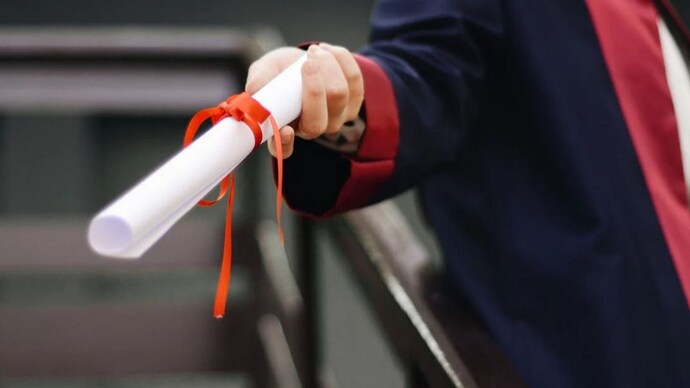
Dr. Ravi Pachamuthu, Chairman of SRM University, advocates for enriching university curricula to nurture creativity and critical thinking, vital skills for success in the 21st century.
Understanding the Importance of Creativity and Critical Thinking:
In an era defined by rapid technological advancement and global connectivity, the ability to think creatively and critically is paramount. “These skills not only facilitate academic achievement but also empower students to navigate complex challenges, innovate solutions, and contribute meaningfully to society,” says Dr. Pachamuthu.
Embracing an Interdisciplinary Approach:
One of Dr. Ravi Pachamuthu's core principles in enriching curricula is the embrace of interdisciplinary learning. By breaking down silos between subjects and integrating diverse perspectives, students are encouraged to make connections, think holistically, and approach problems with versatility and creativity.
Empowering Student Agency and Self-Expression:
He emphasises the importance of empowering student agency and self-expression in enriching the curricula. By providing opportunities for student-led enquiry, project-based learning, and creative expression, colleges can foster a sense of ownership over learning, igniting students' passion for exploration and discovery.
Cultivating a Culture of Enquiry and Innovation:
At the heart of Dr. Pachamuthu's approach lies a commitment to cultivating a culture of inquiry and innovation within universities. By nurturing a growth mindset, encouraging risk-taking, and celebrating failure as a stepping stone to success, educators can instil in students the confidence to challenge assumptions, push boundaries, and embrace experimentation.
Harnessing Technology as a Catalyst for Learning:
One should recognise the transformative potential of technology in enriching the curricula. By leveraging digital tools, online resources, and immersive learning experiences, educators can create dynamic and engaging learning environments that spark creativity, foster collaboration, and expand students' horizons beyond the confines of the classroom.
Promoting Equity and Inclusion:
“By addressing systemic barriers, embracing diversity, and honoring students' unique backgrounds and perspectives, educators can create inclusive learning environments where every student feels valued, supported, and empowered to succeed,” Dr. Pachamuthu added further.
Charting Future Directions:
Looking ahead, Dr. Ravi Pachamuthu envisions a future where university curricula continue to evolve to meet the changing needs of students and society. By embracing innovation, embracing student-centered approaches, and fostering a culture of lifelong learning, educators can prepare students to thrive in a rapidly changing world and make meaningful contributions to the global community.

IMAGES
VIDEO
COMMENTS
Table of Contents. 19 Short Stories and Questions - Suggestions for Teaching Them. 1. "The Most Dangerous Game". 2. "An Occurrence at Owl Creek Bridge". 3. "The Masque of the Red Death". 4.
[email protected]. by Charles Temple Storytelling can teach by imparting truths. But storytelling can also teach by inviting people to think for themselves and create their own truths. When people come up with interpretations and support them with reasons, they are doing what is called critical thinking. And when different people work together to ...
Top 10 Must-Read Inspirational Stories. 1. The Parable of "The Elephant Rope". "The elephant was conditioned to believe he could never break away. He believed the rope could still hold him, so he never tried to break free.". Summary: "The Elephant Rope" is a short motivational story about a young man who observes elephants at a ...
Seven Blind Mice by Ed Young. In this Caldecott Honor winner, seven blind mice try to determine the identity of an unfamiliar object. In Young's take on the classic Indian tale, each mouse only gathers partial information. Of course, it takes the wisdom of the seventh mouse to put the pieces together and solve the puzzle.
Building Your Critical Thinking Toolkit . Pre-reading activities: Prepare your mind for critical thinking before delving into the story.. Title and Cover Analysis: Examine the title and cover artwork to make predictions about themes, characters, and plot.; Author Research: Explore the author's background, literary influences, and relevant historical or cultural contexts to understand their ...
Teaching Critical Thinking with Stories is a series of printable exercises that give you: Planned Series of Exercises. All students can begin with the first set of exercises. When they're ready for more challenges, you can add additional levels, or incorporate the challenges in the levels. Additional Challenges to Exercises.
The best books on critical thinking: Table of Contents [ show] 1. Critical Thinking: A Beginner's Guide to Critical Thinking, Better Decision Making, and Problem Solving - Jennifer Wilson. $12.38. Buy on Amazon. 03/08/2024 04:56 pm GMT. As the title says, this book introduces you to the art of critical thinking.
Here are five great book recommendations for teens that promote critical thinking, authentic voices, diversity and good conversations.
The stories naturally encourage curiosity, deeper learning, and critical thinking — in a way teachers and students share is captivating, too. Weaving wordless videos with real human stories and lesson plans helps teachers, students, and parents to teach and learn key social skills like critical thinking and problem solving in school — and ...
Description and Features. This fun, easy to use picture book is made up of two stories. Students tell each story by analyzing the pictures and responding to the guided questions on each page. The questions are engaging and produce a deeper analysis of the scene and the storyline by encouraging students to provide details, describe events ...
Students can use these critical thinking questions with fiction or nonfiction texts. They're also useful when discussing important issues or trying to understand others' motivations in general. "Who" Critical Thinking Questions. Questions like these help students ponder who's involved in a story and how the actions affect them.
Storytelling can teach by imparting truths. But storytelling can also teach by inviting people to think for themselves and to create their own truths. When people come up with interpretations and support them with reasons, they are doing what is called critical thinking. And when different people work together to create responses to stories ...
Read stories about Critical Thinking on Medium. Discover smart, unique perspectives on Critical Thinking and the topics that matter most to you like Education, Philosophy, Self Improvement ...
The Case for Reading Fiction. by. Christine Seifert. March 06, 2020. cintascotch/Getty Images. Summary. When it comes to reading, we may be assuming that reading for knowledge is the best reason ...
First, consider the five words below: Cruise ship. Bicycle. Airplane. Walking on foot. Automobile (not a race car) Now, put them in order from the slowest to the fastest, when they are going at ...
12661PEP. Tell Me a Story - eBook. PreK-1. eBook. $19.99. Add to Cart. To comprehend science lessons, students must understand the science vocabulary. This set of 25 crossword puzzles are a fun way to reinforce and expand science vocabulary as well as encourage interest in science.
Critical Thinking in Analysing the Fake News. 10. Critical Thinking in Distinguishing between Right and Wrong. 11. Critical Thinking in Decoding Fashion Trends. 12. Critical Thinking in Choosing the Suitable Diet and Exercise. 13. Critical Thinking in Online Shopping.
There are many resources to help you determine if information sources are factual or not. 7. Socratic Questioning. This way of thinking is called the Socrates Method, named after an old-time thinker from Greece. It's about asking lots of questions to understand a topic.
To investigate the effectiveness of short stories use on critical thinking improvement, Khatib and Mehrgan (2012) asked the experimental group to read short stories, do some critical thinking ...
The cognitive and social benefits of storytelling. "When children hear stories, they practice many of the skills they'll need to be effective readers, writers, and critical thinkers," Miyata ...
Stories give life and substance to scientific methods and provide an inside look at scientists in action. Case studies deepen scientific understanding, sharpen critical-thinking skills, and help students see how science relates to their lives. In Science Stories, Clyde Freeman Herreid, Nancy Schiller, and Ky Herreid have organized case studies ...
Critical thinking is the ability to effectively analyze information and form a judgment. To think critically, you must be aware of your own biases and assumptions when encountering information, and apply consistent standards when evaluating sources. Critical thinking skills help you to: Identify credible sources. Evaluate and respond to arguments.
The intellectual roots of critical thinking are as ancient as its etymology, traceable, ultimately, to the teaching practice and vision of Socrates 2,500 years ago who discovered by a method of probing questioning that people could not rationally justify their confident claims to knowledge. Confused meanings, inadequate evidence, or self ...
Critical thinking acts as a dependable GPS, steering you toward informed decisions. It involves weighing options, evaluating potential outcomes, and confidently choosing the most favorable path forward. ☑ Enhanced Teamwork Dynamics. Within collaborative settings, critical thinkers stand out as proactive contributors. They engage in ...
We can read articles, watch videos, and listen to podcasts to learn. So, the first step in freeing teachers from the front of the room is to identify concepts and skills that students can access using media. Then, decide how to actively connect students with that content to develop critical-thinking skills and construct knowledge.
Today, I'd like to share my ideas for the most important mindsets for ELL teachers to remember: Be asset-based and not deficit-based. Our students bring many assets to the classroom, not least ...
A belief constellation is a group of beliefs common to a particular social silo or echo chamber of views. They do not necessarily relate to each other, or require logical consistency. This is how ...
The history major turned tech banker said AI enhances skills like critical thinking, creativity, and logic. Banks are increasingly using AI for fraud and credit risk amid rising regulatory demands.
Story by Stacey Saldanha-Olson, Topeka Capital-Journal • 13h S tanford University professor Greg Watkins visited Topeka High School to meet students from his online course on philosophy and ...
Dr. Ravi Pachamuthu, Chairman of SRM University, advocates for enriching university curricula to nurture creativity and critical thinking, vital skills for success in the 21st century. Understanding the Importance of Creativity and Critical Thinking: